






























By Rio N. Araja and Pot Chavez
PRESIDENT Ferdinand “Bongbong” Marcos Jr. has not given any sign that he intends to call for a special session of Congress to tackle Vice President Sara Duterte’s impeachment, Senate President Francis “Chiz” Escudero said on Sunday.
The Senate President noted that neither the proponents or opponents of Duterte’s ouster had contacted him about starting the impeachment trial, so he set the issue aside while both chambers of the legislature are on break.
By Rio N. Araja












By Rio N. Araja
LEADERS at the House of Representatives sounded the alarm over a plan by opposition solons to divert public attention from the impeachment case against Vice President Sara Duterte.
On Sunday, two lawmakers called an impending complaint against Speaker Martin Romualdez and two other House leaders “a feeble attempt” to distract the public’s focus from the legislature’s efforts to hold Duterte accountable for alleged wrongdoings while in office.
By Rio N. Araja
AKBAYAN party-list Rep. Percival Cendaña on Sunday accepted the apology of Senator Ronald ‘Bato’ dela Rosa for tirades on his physical appearance as a person with disability.
“I welcome Senator Bato’s apology. I hope he can also do the same to all stroke survivors who were hurt by his remarks,” he said in a statement.
“We are not being onion-skinned but it is a different thing when a public servant of such a high position uses his voice to threaten people with violence and discriminate against people with health concerns,” the lawmaker added.
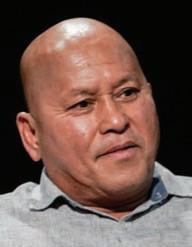




“There has been none. But, of course, if the President calls for one [special session], what can we do? We will have to attend,” he said in Filipino over Super Radyo dzBB.
Mr. Marcos has expressed willingness to call for a special session on the Vice President’s impeachment case if the Senate requests it.
“If the senators ask for this, yes [he would call for a special session]. Again, they will decide. We did not decide this,” the President said in a Palace briefing on Thursday.
Escudero previously said there was no legal basis for a special session, which can be called to pass urgent legislation but not for an im -
peachment trial. For former Senior Associate Justice Antonio Carpio, “as long as there is a will,” the Upper Chamber can convene and hold a special session to try Duterte even if Congress is in recess.
He pointed out that it is up to the President to take the initiative by first calling for a special session.
“It can be done, he [President] can tell them [lawmakers], ‘Okay I will give you 25 days to convene a special session.’ It’s easy to amend the General Appropriations Act to finance an extra 20 to 24 days [of Congress being in session]. It can be done in as short as 20 days… so they can now convene an impeachment court because there is a session.
That’s one way to do it,” Carpio explained in a mixture of Filipino and English.
Meanwhile, Congress is left with no other choice but to impeach Duterte, he emphasized, Iloilo Rep. Lorenz Defensor on Sunday.
He emphasized that Duterte’s remarks on assassinating Mr. Marcos, First Lady Liza Araneta-Marcos and House Speaker Martin Romualdez is a serious crime that poses a direct threat to national security.
“Hiring or even suggesting the hiring of an assassin is not just reckless rhetoric. It is a high crime that threatens the very foundations of our Republic,” Defensor said.
“It is an attack not just on the individuals named but on the institutions they represent, especially the Office of the President, which is at the core of our government and national security framework,” he added.
Defensor is one of the prosecutors in
the impeachment of Duterte. As this developed, the University of the Philippines College of Law has launched a primer on the impeachment process to provide the media, the public, and officials with basic information on impeachment proceedings.
The institution launched the document following the Vice President’s impeachment by the House of Representatives last week to further UP’s public service orientation.
“We live in a world where disinformation even on the most basic things is rampant and taken advantage of. Regardless of where people stand, the current impeachment saga raises fair questions about corruption, abuse of power, and what it means to be a democracy with accountability,” Asst. Prof. Paolo Tamase said.
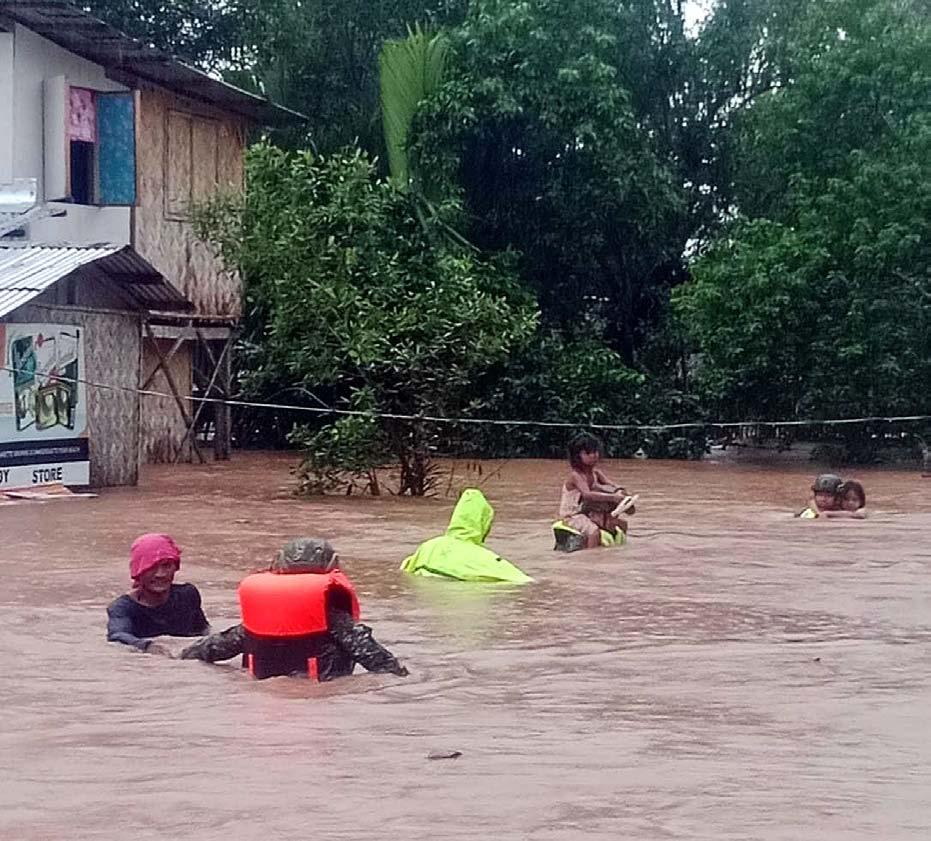
insertions in the 2025 national budget.
“There is no basis, another fantasy and fiction. It is obvious that the goal is to divert public attention from the real issue,” Ortega said.
“Don’t use that as a coverup,” he added. For his part, Khonghun said the expected allegations against the Speaker will merely be another attempt to discredit the House’s overwhelming support for Duterte’s impeachment.
“This is nothing more than a desperate move to discredit the impeachment process,” he said.
“Speaker Romualdez has been instrumental in ensuring that the rule of law is followed, and now he is being targeted to weaken the case against VP Duterte,” he stressed.
The complaint against Romualdez dubiously coincides with the impeachment of Vice President Sara Duterte, he noted.
Ortega warned attempts to derail the impeachment trial through politically motivated cases would only backfire. He urged the Senate to stay independent and disallow external influences from affecting the impeachment trial.
“The Senate must not be swayed by political distractions. The people demand transparency and accountability, and they will not be fooled by these diversionary tactics,” he said.
Dela Rosa earlier said he was sorry for his insensitive and inappropriate remarks against Cendaña. The senator mocked and threatened the party-list solon after the latter criticized Vice President Sara Duterte’s seeming non-
chalance over her looming impeachment trial.
“Your face looks as though it has been punched, that’s why it’s skewed. Come here so I can punch the other side of your face and make it balanced,” Dela Rosa told Cendaña via social media, which resulted in a public backlash against the senator.
“May this serve as an important les-
son that a true leader is not only powerful but has the concern to keep our political discourse rational and humane. And the call for accountability is nothing personal but [the] responsibility of every [person],” Cendaña reminded Dela Rosa. Cendaña said the real fight is the evidence of abuses and corruption of Vice President Duterte.
The agency is now working on the terms of reference of the ID system, she said, adding it is also working with the National Privacy Commission to ensure the data security of the ID cardholders.
Apart from these, the DWSD is coordinating with the Department of Information and Communications Technology and the Philippine Statistics Authority for the smooth issuance of the unified PWD IDs, she noted.
According to Dumlao, the new PWD IDs would bear security features, such as radio frequency identification, to link establishments to a webpage portal for verification of the legitimacy of the user. Republic Act 10754 mandates a 20 percent discount and a valueadded tax exemption on the purchase of certain goods and services from all establishments for the PWDs.
The unified PWD ID system is DSWD’s answer to the proliferation of fake PWD IDs, which has caused many businesses to complain about how they affect their revenues. It can be recalled that the Restaurant Owners of the Philippines (RESTO PH) has denounced the “widespread abuse” of fake PWD IDs for discounts in restaurants and other establishments, noting that it “is now putting a serious strain on restaurants and other businesses.”
This raised public attention enough to cause law enforcement agencies to pursue the printers of fake PWD IDs.
Last week, government agents raided a small room in Manila where fake PWD IDs were allegedly being printed, issued by Quezon City, Manila, Pasig, Muntinlupa, and Angat in Bulacan. The Bureau of Internal Revenue issued a warning last December against the sale and use of counterfeit PWD IDs, calling them a form of tax evasion.
Recently, Senator Sherwin Gatchalian said fake PWD IDs cost the government around P88.2 billion in lost revenue in 2023.
resolute against any intrusion, foreign or domestic, and will not stop protecting its national territory in accordance with international law.
The NMC statement over the weekend was made following the President’s remark reaffirming the country’s resolve to safeguard its sovereign rights in the disputed waters despite the ongoing illegal presence and intrusion of Chinese naval and coast guard vessels.
Several Chinese Coast Guard (CCG) ships, including its largest vessel dubbed as ‘The Monster,’ were in and out of the Philippines’ exclusive economic zone (EEZ) off western Luzon waters for a month now.
Three Chinese naval ships were also spotted last Tuesday near Scarborough shoal, one of which headed south to the Sulu sea where two other Chinese ships joined it, according to Rear Admiral Roy Trinidad.
“We stand resolute against any foreign intrusion into our maritime zones and will never cease upholding our rights and honoring our du -
ties under international law, particularly the United Nations Convention on the Law of the Sea (UNCLOS) and the 2016 Arbitral Award,” the NMC said.
“The Philippines, while committed to the peaceful settlement of disputes and proper diplomatic approaches, will never waver in protecting its national territory and maritime domain,” it added.
On Thursday, President Marcos vowed that Philippine ships would maintain their presence in the WPS, regardless of China’s aggressive actions, including ramming Philippine
enable us to have deeper cooperation and more substantive participation in training to build capacity,” Canada’s ambassador to Manila, David Hartman, said in a statement.
“We are hopeful that the signing and ratification of the agreement by both governments can be expected before the end of 2025,” he added. Canadian officials held discussions last month with counterparts from the Philippine defence and foreign departments, he said.
Hartman said the agreement would allow for future participation by Canadian troops in large-scale joint military exercises held every year between the Philippines and the United States.
The Philippine foreign office did not immediately reply to a request for comment.
The Canadian navy has taken part in recent months in several patrols in the South China Sea with the US, Australia, the Philippines and Japan to assert freedom of navigation and flights in a strategic waterway claimed almost in whole by Beijing. AFP
vessels, using water cannons, lasers, or blocking ships.
“We will always be there protecting our territory. We will always be there making sure our fishermen are able to exercise their sovereign rights,” the President said during a press briefing held in Malacañang.
Meanwhile, Philippine Coast Guard (PCG) was closely monitoring various CCG vessels, including the ‘monster chip (CCG-5901), which was first spotted last January 4, 2025. BRP Teresa Magbanua is currently watching the activities of CCG vessels in the Zambales coast.





FURst Date: Express your love for your furry ones
Keep the fun going by treating your fur-babies to a paw-some Valentine’s date at the Paw Park! Enjoy cuddles, treats, and special memories with activities like Paw-p Art, where your pets can get custom pop art portraits, or Paw-fect Match, for fur parent and


LOVE Vibes: You gotta play it cool indoors
To kick off Valentine’s Day, plan a date filled with fun activities! Keep it light and enjoyable with SM’s indoor entertainment options. Go see a movie at SM Cinema with friends or solo, or opt for a couple’s skating session. Challenge your partner to bowling, or explore other amazing experiences at SM. Fun, laughter, and memories await!

LOVE Market: Share the gift of love

LOVE Bites: Indulge in dining deals made for you Next stop: food! Because the way





After a hearty meal, take your date on a shopping spree because nothing says “I love you” like a thoughtful gift. Head to the LOVE Market to shop for curated selection of cakes, chocolates, flowers, and personalized items for your special someone— or yourself!

LOVE Lab: Time to create love memories together
What’s a good Valentine’s Day without quality time? Get hands-on and creative with your special someone at the Love Lab. This workshop hub is all about making memories—and







Love comes in all forms, and SM Supermalls is here to help you celebrate it your way. Mark your calendars and map out a full day of love at the SM malls. Let’s make this Valentine’s season one to remember with your partner, friends, family, or fur babies. To know more about SM Supermalls’ Valentine’s Day activities, visit www. smsupermalls.com or follow @ SMSupermalls on social media.

MY COLUMN last Thursday, Feb. 6, was filed Tuesday morning, as I had a series of business meetings on Wednesday, the deadline for submission. Frankly, I did not foresee that moves were being hatched and denouement would happen so soon.
Of course there were ominous signs.
The HoR secretary-general kept sitting on the three impeachment complaints filed in his office, and kept saying he was waiting for a fourth one whose endorsers were still collecting the mandatory 103 co-endorsers, so that they could send it to the Senate posthaste.
Clearly, the HoR was awaiting a gosignal since the President had made previous statements he was not in favor of impeaching his vice.
That signal came late on Monday so the first signatures were collected on Tuesday, followed by a caucus on Wednesday where, allegedly, promises of bounty in AKAP, AICS and identifyit DPWH projects were made.
No wonder, as the president himself stated much later, some wanted to yet sign beyond the 215 signatories sent to the Senate. As we write this, more than 20 representatives made “habol,” giving credence to accusations that “inducements” were made. Dagdag ayuda for the signatories.
It is difficult, whatever the denials and reasons, to not see Malacanang’s imprimatur especially with the first son as the first to sign.
Senate President Chiz stated on Thursday he would take cognizance of the complaint only on June 2, as Congress was already on recess. He further stressed that a “special session” called by the President is meant for urgent legislation that needs to be passed, not for an impeachment trial.
A leading senatorial candidate told this writer last Thursday the President would not likely call for a special session to tackle the impeachment complaint, as it would expose his hand, yet the President on Friday stressed that while impeachment was the sole business of the legislature, he was open to calling for a special session.
As President Joseph Estrada’s political secretary then, I recall how the impeachment complaint filed in the HoR first went through the Committee on Rules, assigned to the Committee on Justice, which held several acrimonious hearings, until Speaker Manny Villar decided to turn the opening prayer into transmission to the Senate.
The incident happened on Nov. 8, 2000, and it took the Senate more than three weeks to convene the trial, after setting the rules along with the Chief Justice as presiding officer, and having their custom-made scarlet robes tailored.
This time around, the HoR secretary-
general received the first impeachment complaint on Dec. 2 last year, followed by another two days or so later. Then another the following week. But he did not transmit any of the complaints to the Speaker, clearly freezing the ball.


MONDAY, FEBRUARY 10, 2025 advertise@manilastandard.net
He even had the gall to say that endorsing the first impeachment complaints through the regular procedure would take time, given the few remaining weeks in the calendar of Congress prior to the election campaign.
What will happen starting June 2 when Escudero formally convenes the Senate into a court?
I recall having told President Estrada on Nov. 2 that Speaker Villar was meeting with several congressmen and would gather the signatures of a third of the membership to impeach him.
He was in disbelief, but it happened.
The Senate convened as a court on Dec.7, with Chief Justice Hilario Davide presiding, and Nene Pimentel was the Senate President.
Pimentel, upon the recommendation of the 11 senators who had earlier promised not to convict Erap, replaced Franklin Drilon in a decision made at Erap’s Greenhills home.
The trial kept the entire nation hooked on their TV sets throughout the holiday season and the first three weeks of Jan. 2001, until the prosecutors walked out after being defeated on a vote whether or not to open a second envelope which supposedly contained documents pertaining to the Jose Velarde account, ostensibly belonging to Erap where his cronies deposited sums of money under fictitious names.
Thus did Edsa Dos begin, and within the next few days, the duly elected president was ousted through a “mob” blessed by Cardinal Sin and given judicial cover by the Supreme Court.
What will happen starting June 2 when Escudero formally convenes the Senate into a court?
Or if the President calls for a special session, unseemly though it be, in response to the clamor of the HoR and the Duterte detractors, how would the “independent” Senate act?
Or would the Supreme Court be asked to interpret the Constitutional conundrum?
Whatever, we are into troubled and troubling times, and the economy, already morose as it is, will further worsen.
But our politicians could not care less, their mission being “off with her head.”

Democracy Watch Philippines, she emphatically stated that corruption means slower public service delivery, higher prices of commodities, and poorer living conditions.
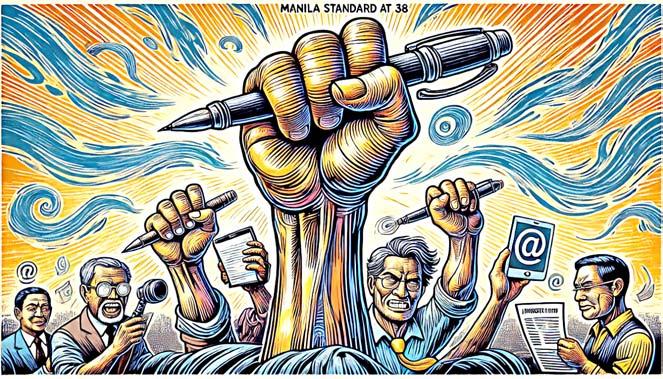
CURLS are seen and closely observed by many as France, Japan, and the United States are above board in an 11day multi-large deck event in the Philippine Sea aimed at advancing coordination and cooperation among the participating nations.
Known by its initials MLDE and called Exercise Pacific Steller 2025, it is hosted by the French navy and involves ships from the US Navy, the French Carrier Strike Group, and the Japan Maritime Self-Defense Force.
The Philippine Sea is a vital maritime region that connects the Western Pacific, the South China Sea, and important global trade routes and a focal point for security operations in the Indo-Pacific.
The Philippine Sea is a section of the western North Pacific Ocean, lying east and north of the Philippines, and the floor of this portion of the ocean is formed into a structural basin by a series of geologic folds and faults that protrude
benefit the powerful; they deepen poverty and inequality, limiting access to quality education, healthcare, and infrastructure, especially for the marginalized.
A Pulse Asia survey reflects this frustration, revealing that 90 percent of Filipinos want corrupt officials held accountable.
above the surface in the form of bordering island arcs. Participating in the trilateral event are the French Carrier Strike Group -centered around the Charles De Gaulle aircraft carrier – and ships from the US Navy’s Vinson Carrier Strike Group, and the Japan Maritime Self-Defense Force.
The multi-large deck event is conducted consistent with international law and wth due regard to the safety of navigation
This MLDE, sailing on the east and north of this archipelago which is protecting itself from continuing harassment in its exclusive economic zone in the West Philippine Sea by superior foreign vessels, is designed to advance coordination and cooperation among French, Japanese and US maritime forces while simultaneously demonstrating
simple meal—these short-term handouts keep the corrupt in power while the people remain trapped in long-term poverty.
But voters are not powerless.
Dr. Magno stressed the importance of recognizing and resisting vote-buying, noting that money politics thrives on voter ignorance and economic desperation.
capabilities in multi-domain operations, promoting a shared dedication to regional stability, and highlighting the US Navy’s enduring power projection capability.
This month’s MLDE follows a similar event in August 2024 between the Nimitz-class aircraft carrier USS Abraham Lincoln and the Italian Navy aircraft carrier ITS Cavour, the first between them in the Indo-Pacific region. Official sources say MLDEs are conducted in a manner consistent with international law and with due regard to the safety of navigation and the rights and interests of other states.
The French Carrier Strike Group is at present engaged in Mission Clemenceau 25, sailing alongside its allies and strategic partners to promote a free, open and stable Indo-Pacific space for the benefit of French populations, interests, and those of their regional partners, within the framework of international law.
The Carl Vinson Carrier Strike Group is operating in the area of operations of the US 7th Fleet, the US Navy’s largest forward-deployed numbered fleet and routinely interacts and operates with allies and partners in preserving a free and open Indo-Pacific region.
out, government alone cannot solve this problem.
It requires the active participation of civil society and the private sector to sustain a culture of integrity. Corruption cannot thrive if the people refuse to tolerate it.
to build.
The question we must ask ourselves is simple yet profound: Will we allow corruption to continue crippling our country, or will we choose leaders who genuinely serve the people?
Corruption in the Philippines is more than just a talking point—it is an insatiable monster that feeds on our economy, undermines democracy, and exacerbates poverty.
It leaves the poor even poorer while the corrupt in government grow more entrenched. We suffer its effects in delayed public services, overpriced infrastructure projects, and ill equipped hospitals.
In the keynote speech of Budget Secretary Amenah Pangandaman during the side event of the 2025 Open Government Partnership Asia and the Pacific Regional Meeting organized by the Stratbase Institute in partnership with
Will we let corruption win again, or will we finally break the cycle?
These adversities erode trust in government, weaken democracy, and hinder economic growth.
The forum brought together government officials, civil society leaders, and policy experts who all agreed on one thing: corruption is not just a moral failure—it is a governance failure.
Ateneo School of Governance Dean Philip Arnold Tuaño described it as an abuse of public power for private gain, manifesting in election fraud, patronage politics, and bureaucratic bribery.
These forms of corruption don’t just
Meanwhile, a Social Weather Stations survey found that while Filipinos prioritize job creation, food security, healthcare, and education, 70 percent also want candidates who will actively push for anti-corruption measures.
Clearly, the Filipino people want clean governance.
Dr. Francisco Magno, Director of the La Salle Institute of Governance, emphasized that elections should be a contest of ideas and leadership, but too often, they are hijacked by financial interests.
This means that money, more than merit, dictates who gets elected.
Politicians with deep pockets can drown out more qualified candidates by funding massive disinformation campaigns or outright buying votes.
Vote-buying has long been an ugly feature of Philippine elections. A few hundred pesos, a sack of rice, or even a
This means we must look beyond campaign promises and scrutinize candidates’ records. What policies have they championed?
Have they been involved in corruption scandals? Have they truly served the people or only their own interests?
Civic education must go beyond voter registration drives.
Voters must be equipped with the tools to discern propaganda from fact.
As Dr. Magno put it, critical analysis of candidates and policies is necessary to reduce the influence of misinformation.
As citizens, we must actively participate in governance by monitoring government projects, holding leaders accountable, and demanding transparency in public spending.
It is easy to blame politicians for corruption, but, as Anti-Red Tape Authority Secretary Ernesto Perez pointed
The passage of the New Government Procurement Act in 2024, which mandates open contracting and transparency in public spending, is a step in the right direction.
But laws alone cannot eliminate corruption—vigilant citizens can.
When politicians realize that Filipinos will no longer sell their votes or turn a blind eye to abuse, the tides will begin to shift.
As Filipino voters, we must demand better.
We must vote not based on personal gain, but for the greater good.
We must reject the corrupt and elevate those who serve with integrity.
And most importantly, we must remember that our vote is not just a choice for today—it is a choice that will define the future of our country.
Will we let corruption win again, or will we finally break the cycle?



CAMILLE Villar turned over on Tuesday the house and lot won by 26-year-old overseas Filipino worker Angelica Abellano during simple ceremonies in Camella Pili, Camarines Sur.
A former BPO call center agent before working as a teacher in Taiwan, Abellano was very grateful when she and her family toured their new home for the first time.
“Nandito na po, nakita ko na po finally yung bahay. Wala pong mapaglagyan yung kasiyahan ko kasi wala palang imposible. Dahil po kay Ma’am Camille, ginawa niyang posible yung isang pangarap na sa tingin ko po ay ilang taon ko pong pagsisikapan,” said Abellano, fourth among eight siblings.
Ginawa pong magic ni Ma’am Camille,” she said, referring to how Camille was instrumental in making her dream come true.
For decades, Abellano and her family lived in a modest home owned by a relative in their hometown. Winning the Camella house was a lifechanging blessing for them.
“‘Ito na yung bunga ng sacrifice mo sa family’, sabi ng papa ko. Gusto ko po mag thank you dahil ginawa siyang instrument ni Lord pa maisakatuparan ang pangarap ko, kung bakit ako nasa ibang bansa. Sobrang thankful po ako,” she said, referring to Camille Villar.
Abellano’s father is a farmer while her mother sells rice cakes to augment the family income.
“Itong bahay po para sa family ko, hindi na po kami matutulog sa lapag. Hindi na po namin mararanasan na pag umuulan, kailangan maglagay ng balde o tabo kung saan-saan...May concrete na pong bahay kung saan mag-create kami ng new memories,” Abellano added.



Abellano won the house and lot from Camella during the “Paskong Pinoy 2024: Piyesta, Musika at Kultura” Christmas gathering organized by the Manila Economic and Cultural Office (MECO) led by its chairperson, Cheloy Velicaria-Garafil, last December. Over 3,000 OFWs attended the event held at the Fu Jen Catholic University in New Taipei City.
Villar congratulated Abellano as she gave her the key to her dream house and lot in Camella Pili, located at Brgy. Cadlan in Pili, Camarines Sur. She also handed over to Abellano a move-in gift certificate worth P50,000 from AllHome to help her start her furnishings for her new house.
She said OFWs like Angelica continue to inspire her in continuing her advocacy to help overseas Filipinos. “Talagang gusto ko magpasalamat sa inyo dahil ikaw ang nagsilbing inspirasyon sa amin. Sobrang saya ko na kahit papaano, maalagaan mo ang pamilya mo,” Villar said.
Villar reiterated her concern for the OFWs, who sacrifice themselves just to provide for their families.
Lagi po akong narito, kasama ang aking pamilya, sa pagtataguyod ng maayos na kabuhayan para sa ating mga kababayan, lalung-lalo na ang ating mga bagong bayani. Kasama niyo po kami sa pagkamit ng inyong mga pangarap sa buhay,” Villar said.
“Lahat ng pangangailangan niyo ay lagi ko pong inaalala. Lapitan niyo lamang po ako, at handa po akong tumulong sa inyo sa abot ng aking makakaya,” Villar also said, as she vowed to pursue legislation that would promote and ensure the welfare of OFWs around the world.

Thousands rally vs. Iran’s leaders
PARIS—Several thousand Iranians came from across Europe to rally in Paris on Saturday, calling on world leaders to put greater pressure on the Islamic republic’s ruling clerics.
“Instead of appeasing the mullahs, (the international community) should stand side by side with the Iranian people,” Maryam Rajavi, president of the National Council of Resistance of Iran (NCRI), told the rally.
The NCRI is the political wing of the People’s Mujahedin of Iran, which Tehran regards as a “terrorist” group. Iran’s opposition abroad has been emboldened by the fall in late 2024 of Syrian President Bashar al-Assad, a longtime ally of Tehran.
“As Syria did with Bashar al-Assad, the Iranian people will free themselves of the mullahs, and it will be in 2025,” said Belgium’s former prime minister Guy Verhofstadt.
“The strategy of complacency has to change”, he argued, adding: “I don’t think it’s going to happen that way with the US administration this time”.
“The Iranian regime will fall like the Syrian regime fell, at a speed that no one would have predicted,” former Syrian rebel leader Riad al-Asaad told the crowd by video link.AFP
Hundreds protest vs. Beijing ‘mega embassy’
LONDON—Hundreds of demonstrators on Saturday protested at a site earmarked for Beijing’s controversial new embassy in London over human rights and security concerns.
The new embassy -- if approved by the UK government -- would be the “biggest Chinese embassy in Europe”, one lawmaker said earlier.
Protester Iona Boswell, a 40-year-old social worker, told AFP said there was “no need for a mega embassy here” and that she believed it would be used to facilitate the “harassment of dissidents”.
China has for several years been trying to relocate its embassy, currently in the British capital’s upmarket Marylebone district, to the sprawling historic site in the shadow of the Tower of London.
The move has sparked fierce opposition from nearby residents, rights groups, critics of China’s ruling Communist Party and others.
“This is about the future of our freedom, not just the site of a Chinese embassy in London,” Conservative Party lawmaker Tom Tugendhat told AFP at the protest, adding that people living in the UK “sadly have been too often been threatened by Chinese state agents.” AFP
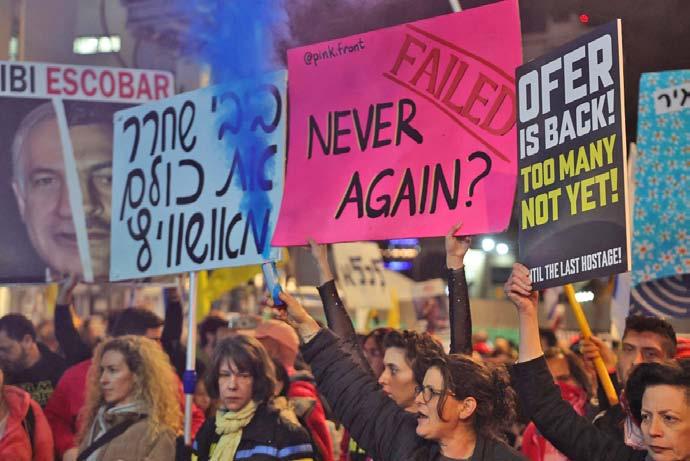



WASHINGTON, DC—A US judge issued an emergency order early Saturday blocking Elon Musk’s government reform team from accessing personal and financial data for millions of Americans stored at the Treasury Department, court documents showed.
raise placards and chant slogans during a protest calling for the release of
EIR EL-BALAH, Palestinian Territories—Israeli Prime Minister Benjamin Netanyahu ordered negotiators on Saturday to return to Qatar to discuss the fragile ceasefire in the war with Hamas, after the fifth hostage-prisoner swap agreed under the truce was completed.
He repeated his vow to crush Hamas and free all remaining hostages, denouncing the militant group as “monsters” after the handover of three captives in Gaza who appeared emaciated and were forced to speak on a stage.
The hospital treating the three Israeli hostages released from Gaza on Saturday said Or Levy and Eli Sharabi were in a “poor medical condition,” while Ohad Ben Ami was in a “severe nutritional state”.
Of the 183 inmates released by Is-
rael in return, the Palestinian Prisoners’ Club advocacy group said seven required hospitalization and decried “brutality” and mistreatment in jail.
While 41 of those released returned to the West Bank city of Ramallah, four were released in Israeli-annexed East Jerusalem, 131 were sent to Gaza and seven were deported to Egypt.
The fifth exchange since the truce took effect last month came as negotiations were set to begin on the next phase of the ceasefire, which is intended to pave the way for a perma-

nent end to the war.
But senior Hamas official Bassem Naim on Saturday said Israel’s “procrastination and lack of commitment in implementing the first phase... exposes this agreement to danger and thus it may stop or collapse.”
He also described, in an interview with AFP, the condition of the hostages as “acceptable under the difficult circumstances that the Gaza Strip was living”.
Saturday’s swap followed remarks by President Donald Trump suggesting the United States should take control of the Gaza Strip and clear out its inhabitants, sparking global outrage.
The three Israeli hostages, who were all seized by militants during Hamas’s October 7, 2023 attack that sparked the war, “crossed the border into Israeli territory” on Saturday, the Israeli military said. AFP
US District Judge Paul A. Engelmayer’s order restricts giving access to Treasury Department payment systems and other data to “all political appointees, special government employees, and government employees detailed from an agency outside the Treasury Department.”
The temporary restrictive order, which remains in effect until a February 14 hearing, also says any such person who has accessed data from the Treasury Department’s records since President Donald Trump’s January 20 inauguration must “immediately destroy any and all copies of material downloaded.”
Musk, the world’s richest person, is leading Trump’s federal cost-cutting efforts under the so-called Department of Government Efficiency (DOGE).
The case was brought against the Republican president, the Department of the Treasury and Treasury Secretary Scott Bessent by attorneys general from 19 states on Friday. They alleged the administration violated the law by expanding access to sensitive Treasury Department data to staff from Musk’s DOGE.
The Tesla, SpaceX and X chief is neither a federal employee nor a government official, although US media reported this month that he had been registered as a “special government employee.”
DOGE does not enjoy full status as a government department, which would require approval by Congress. AFP

WASHINGTON, DC—The US agency overseeing medical research has announced a major cut in funding to universities and research centers, a move strongly condemned by scientists and academics who say work on cancer and other diseases will suffer.
The National Institutes of Health said late Friday it was setting a 15 percent limit on its funding of “indirect,” or overhead, costs linked to research.
That represents a dramatic drop, amounting to billions of dollars, from the indirect billings of up to 60 percent now charged by some organizations, the agency said.
“This change will save more than $4B a year effective immediately,” the official NIH account said on X. It said it was “vital to ensure that as many funds as possible go toward direct scientific research costs.”
The expenses being targeted include maintenance, equipment and administrative costs at research laboratories.
The cut could affect research on diseases like cancer and neurodegenerative conditions like Alzheimer’s and Parkinson’s diseases, scientists said.
“This is a surefire way to cripple lifesav-
ing research and innovation,” Matt Owens, president of COGR, which represents research institutes and university medical centers, said in a statement to AFP.
“America’s competitors will relish this self-inflicted wound,” he said. “We urge NIH leaders to rescind this dangerous policy before its harms are felt by Americans.”
Jeffrey Flier, former dean of the Harvard University medical faculty, said on X that the approach by President Donald Trump’s administration “was designed not to improve the process, but to harm institutions, researchers and biomed research.”
He said it would “cause chaos and harm biomedical research and researchers.”
The White House on Saturday defended the move, saying it was bringing its indirect cost rates in line with metrics used by private sector foundations.
“NIH announced a new indirect costs policy that is in line with what research institutions receive from private foundations,” said a statement.
“The indirect cost rate is intended to cover overhead and the federal government has been paying an exorbitantly high rate.” AFP

FEBRUARY 10,

By Joel E. Zurbano
BUREAU of Immigration (BI) Commissioner
Joel Anthony Viado has expressed grave concern over the alarming increase in cases of trafficking Filipinos by online syndicates using the catphishing platform.
In a statement, Viado disclosed that 14 victims were intercepted over the past week, preventing their attempts to depart for illegal work in scam hubs abroad.
The first wave of interceptions occurred on Feb. 4, when three victims,
OCD donates essential items for Gaza people
THE Philippine’s Office of Civil Defense (OCD) on Friday donated 8,323 bonnets, 3,187 pairs of gloves, and 20 blankets as a humanitarian gesture to help the people of strife-torn Gaza Strip in the Middle East.
“We stand in solidarity with all those impacted by this tragedy and recognize the urgency of the situation,” OCD administrator Ariel Nepomuceno said during the turnover of the donations at the NDRRMC Operations Center at Camp Aguinaldo in Quezon City.
“Today’s ceremony marks a significant moment in our efforts to support global humanitarian initiatives. It is an honor to gather here with our partners from the Jordanian Honorary Consulate and the DFA as we officially recognize the Philippines’ contribution to the Humanitarian Air Bridge Campaign of the Hashemite Kingdom of Jordan,” he added.
FEBRUARY 10, 2025
According to the OCD, the initiative “not only delivers essential aid, but also reinforces the Philippines’ role as a compassionate partner on the global stage, committed to alleviating human sufferings Rex Espiritu
AFP launches program to help military retirees
THE Armed Forces of the Philippines and Bayo Manila Foundation Inc. have jointly launched a program for military retirees.
The “Weave for Peace” initiative is a collaborative effort that seeks to enhance the economic well-being of the military retirees and their families.
The program aims to equip participants with the necessary skills and resources to engage in handicraft production, fostering financial independence while promoting peace and unity within the community.
“The collaboration reflects the AFP’s commitment to improving the welfare of its personnel and their families, ensuring they have access to dignified, sustainable livelihoods post-service.” The AFP said.
The launched was attended by AFP chief Gen. Romeo Brawner Jr. and Anna Lagon, president of the Bayo foundation. Rex Espiritu
Bataan wetland gains global recognition
A BATAAN wetland has been included in the list of Ramsar sites, giving the area international significance.
The declaration of Ramsar sites is provided under the Ramsar Convention, an inter-governmental environmental treaty by the UNESCO for the conservation and sustainable use of wetlands.
The Balanga Wetland is an 11-hectare ecological biodiversity of mangroves and mudflats in Barangay Tortugas, Balanga City supporting rich ecosystems and serving as a sanctuary for migratory birds.
Environmental conservationists and birdwatchers congratulated Balanga leaders led by Mayor Francis Garcia and Vice Mayor Vianca Venzon-Gozon for achieving yet another milestone.
Mayor Garcia and Vice Mayor Vianca Venzon-Gozon have been instrumental in the conservation and promotion of the Balanga Wetland.
Butch Gunio
By Rex Espiritu
A TOTAL of 232 New People’s Army (NPA) rebels have surrendered in Davao de Oro province and are now undergoing reintegration process, the Philippine Army reported. The Army viewed the mass surrender as a “significant step toward lasting peace and reconciliation.” The Army’s 10th Infantry (Agila) Division (ID) presented the former insurgents to Special Assistant to the President Antonio Ernesto Lagdameo Jr. at the Agila Hall of Camp Gen. Manuel Yan Sr., at Brgy. Tuboran, Mawab, Dav-
aged 33, 25, and 27, were rescued at the Ninoy Aquino International Airport (NAIA) Terminal 1 while about to board a Philippine Airlines flight to Thailand.
The BI’s Immigration Protection and Border Enforcement Section (I-
PROBES) reported that the passengers appeared to be first-time travelers on a self-funded trip to Thailand. However, their conflicting responses during initial questioning raised suspicions, prompting their referral for further inspection.
During questioning, the victims admitted they had been recruited to work in Cambodia as customer service representatives for a business process outsourcing (BPO) company.
On Feb. 5, another group of 11 trafficking victims in their mid-20s were intercepted while attempting to board the same airline also bound for Bangkok, Thailand.
The victims initially claimed to be students from a certain school, embarking on a four-day trip to Thailand. However, their inconsistent answers triggered further investigation.
Subsequent interrogation disclosed that the victims had been lured with promises of P50,000 monthly pay to work at fraudulent (business process outsourcing (BPO) in Pakistan. The recruiter had instructed them to pose as students on vacation and to conceal their Pakistani visas.
BI I-PROBES chief Mary Jane Hizon noted the disturbing nature of these cases, where traffickers prey on vulnerable individuals, particu-
larly young Filipinos. The syndicate promises purported employment in reputable BPO companies, only for the victims to unwittingly end up working in scam hubs and forced to work as catphishers. Viado blasted the scheme, stressing that it places Filipinos in perilous situations where they face limited or no opportunity for escape, trapped in illegal work within unregulated industries and fraudulent business operations. The rescued victims were referred to the Inter-Agency Council Against Trafficking (IACAT) for assistance, and efforts are underway to file cases against their recruiters.
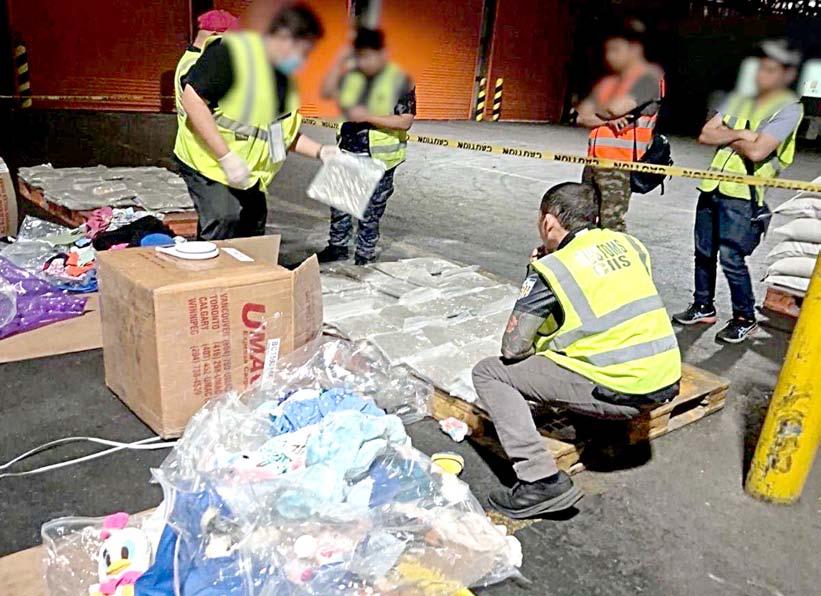
By Rio N. Araja
THE Department of Social Welfare and Development (DSWD) will offer hot, homecooked meals in its 15 newly acquired mobile kitchens during disasters.
DSWD Secretary Rex Gatchalian said the mobile kitchens, acquired through the assistance of Senator Joel Villanueva, were meant to help provide fresh and healthy meals to evacuees, especially in disaster situations that require long-term response.
This is in addition to family food packs usually given away to the evacuees.
“Of course, the evacuees cannot always eat preserved food and those at the food packs. So they can set up community kitchens that could could fresh food, and now, these mobile kitchens can augment the food they eat at the evacuation centers,” Gatchalian added.
Each mobile kitchen, worth over P5 million, and equipped with sink, oven, kitchen utensils, refrigerator/freezer, stove, cooking wares and other stockpiles of food.
It has the capacity to serve people in evacuation centers who may be organized into teams to help in the hot meal
preparations, depending on the extent of the disaster. The DSWD chief also inaugurated two mobile water treatment units capable of cleansing non-certified drinking/ potable water of at least 6,000 liters per hour using ultrafiltration to make it potable and safe for human consumption.
A mobile water treatment unit costs over P5.7 million and can also process floodwater and seawater by at least 2,500 liters per hour through desalination or reverse osmosis, making the unsafe water potable and drinkable during emergency situations.
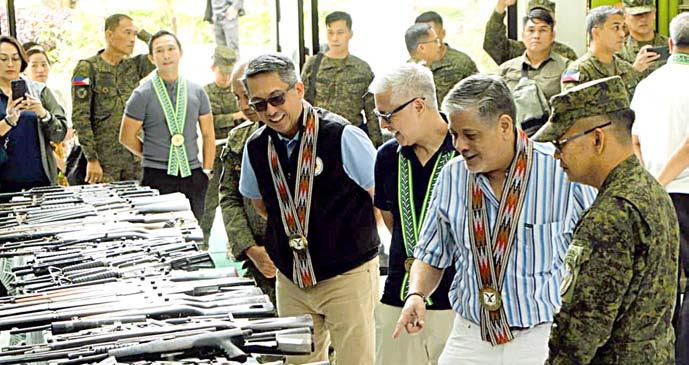
ao de Oro.
The 232 surrenderees consisting of former NPA regular members and Milisyang Bayan, were among those who laid down arms during the Joint Operational Area of the 10ID last year and up to last month. The group also turned in 111 firearms during the surrender ceremony. Lagdameo commended the surrenderees “for choosing peace and a lawful path toward prosperity.”
“Today is a testament to the effectiveness of our peace programs. It reflects the strong collaboration between the national and local governments, as well as
the military, in fostering genuine reconciliation,” Lagdameo said.
10ID commander Maj. Gen. Allan Hambala called for collective efforts to sustain an insurgency-free environment within his unit’s area of responsibility.
“Today’s event is not only a celebration of transformation, but also a call to action for all of us to strengthen our commitment to building bridges of trust and reconciliation,” Hambala said.
As part of the government’s support for reintegration, the former rebels also received food packs from the Department of Social Welfare and Development (DSWD).
BOC seizes P39-m marijuana declared as household items
THE Bureau of Customs (BOC) has thwarted an attempt to smuggle into the country P39 million worth of high grade marijuana leaves also known as kush from Canada.
The prohibited leaves, concealed in two balikbayan boxes that arrived at the Manila International Container Port (MICP), were confiscated on Wednesday (Feb. 5) following thorough laboratory examinations, The Customs Intelligence and Investigation Service (CIIS), with the assistance of the Philippine Drug Enforcement Agency (PDEA), was able to confirm the presence of kush or dried marijuana in 108 pieces of vacuum-sealed pouches stashed inside two balikbayan boxes.
BOC Commissioner Bien Rubio regretted the use of balikbayan boxes for unlawful purposes, saying it has become “a symbol of the Filipino diaspora.”
“I see balikbayan boxes as a symbol of the love and sacrifice of Filipino families so they can have a good life. For other Filipinos to use these in the illicit trade of drugs that destroy lives and communities is horrifying,” he stressed.
“Illegal drugs have no place in our Bagong Pilipinas. Smuggling of any kind is what we, in the Marcos administration, will work to pulverize and end with finality,” he added.
According to CIIS director Verne Enciso, whose team received the intelligence information the drug smuggling bid, said the shipment came through the U Mac Forwarders Express Inc. by a certain Riza Munar from Vancouver, Canada and consigned to John Paul de Leon of San Mateo, Rizal. The boxes were declared to contain used household goods and personal effects from Canada.


HEAVY rains attributed to a shear line forced many residents out of their homes in Palawan as flood waters rose over the weekend, based on several photos shared online by local disaster response, including the Philippine Coast Guard (PCG). The PCG through its special operations group in Central Palawan deployed rescue teams on amphibian boats Sunday to save individuals battered by chest-deep floods in low-lying neighborhoods across Puerto Princesa City.
Responders were instructed “to ensure the safety of residents, conduct rescue operations if necessary, and provide immediate assistance to the communities experiencing severe flooding due to continued heavy rainfall,” the PCG said in a Facebook post.
State weather bureau PAGASA forecasts a heavy rainfall outlook over the province as well as Quezon, Camarines Norte, Camarines Sur, Catanduanes, Albay, Sorsogon, Eastern Samar and Northern Samar. Cagayan, Aurora, and Isabela will likely be affected over the next two days.
BI deports 26 ‘aliens’ involved in illegal POGO
THE Bureau of Immigration (BI) has deported 26 more illegal aliens involved in illicit Philippine Offshore Gaming Operator (POGO) activities, following President Ferdinand Marcos Jr.’s directive to eradicate illegal offshore gaming operations in the country.
The deportees were part of the 450 foreign nationals apprehended in January for violating Philippine immigration laws, particularly those linked to illegal POGOrelated scams.
The 26 deportees were made up of 23 Chinese nationals and 3 Malaysians, who boarded Philippine Airlines and Malaysian Airlines flights at the Ninoy Aquino International Airport (NAIA).
BI Commissioner Joel Anthony Viado reiterated the government’s commitment to cracking down on illegal POGO operations.
“This is just the beginning. We are resolute in enforcing immigration laws and ensuring that those who exploit our country for illicit activities are removed,” he said. Viado emphasized that more arrests and deportations would follow. “Foreign nationals who engage in unauthorized and illegal operations should take this as a warning—we will find you, arrest you, and send you back to your country,” he added. Vito Barcelo
Lawmakers earmark P3b for cancer program
THE House of Representatives has allocated P3 billion to fight cancer, according to Makati City Rep. Luis Campos Jr. Congress has increased the combined budget for the Cancer Control Program (CCP) and the Cancer Assistance Fund (CAF) to P3.01 billion as the national government intensifies its battle against the disease that kills 96 Filipinos every day, he said.
“The total of P3.01 billion represents a 33 percent increase over the P2.27 billion allocated to the CCP and the CAF in 2024,” he said. The CAF directly aids cancer patients, individuals living with cancer, cancer survivors and those at high risk. The CCP supports cancer prevention and related interventions, including the procurement and delivery of medicines aimed at providing supportive therapy and palliative care to patients.
Cancer is now the

A SHEAR line affecting Southern Luzon and Visayas will bring moderate to heavy rains to select provinces until Wednesday noon, the Philippine Atmospheric, Geophysical and Astronomical Services Administration (PAGASA) said.
In its 5 p.m. bulletin on Sunday, PAGASA further said the affected provinces until Tuesday noon are Quezon, Oriental Mindoro, Palawan, Camarines Norte, Camarines Sur, Catanduanes, Albay, Sorsogon, Eastern Samar and Northern Samar.
Palawan News reported heavy flooding in several villages in Puerto Princesa City and other southern towns on Sunday following two days of heavy rainfall. The affected communities are San Miguel, San Pedro, San Manuel, San Jose, Tagburos, Sta. Lourdes, Tiniguiban, Sicsican, Irawan, Iwahig, and Bancao-Bancao. By Tuesday noon until Wednesday noon, shear-line affected areas will include Cagayan, Isabela and Aurora, and will only have Quezon, Camarines Norte, and Camarines Sur from the previous list.
Other forecast conditions until 4 p.m.
Monday: Cloudy skies with scattered rains and thunderstorms (easterlies): Caraga and Davao Regions
By Nash B. Maulana
AMPATUAN, Maguindanao del Sur—Local authorities appealed to residents to help them convince a man, who had apparently taken a valuable item from the wreck of the aircraft that crashed on a rice field here on Thursday.
Camino also posted on social media the man’s picture showing the black bag with a long shoulder belt slung on his shoulder.
“If I were you, friend, I will surrender that bag. See US soldiers are not pulling out from here, apparently looking for an
exhumes kidnap victims’ remains in Cavite
GENERAL TRIAS CITY, Cavite--The remains of a Chinese woman, Hong Rong Rong, and her young son, who were among nine individuals abducted in Muntinlupa in October 2023, were discovered in General Trias, Cavite on Friday.
Authorities exhumed their bodies from Savannah Fields in Barangay San Francisco. This discovery follows the deaths of four other Chinese nationals who were part of the same group.
Two were found in Tanay, Rizal on November 1st, and two more in Infanta, Quezon on November 6th. The three Filipino victims were released unharmed in Calauan, Laguna shortly after the kidnapping on October 30th.
In the report, Police Regional Office (PRO)IVA director P/Brig. Gen. Kenneth Lucas, the remains of the victims were exhumed by joint elements of the PNP-Anti-Kidnapping Group and Gen. Rias Police in Savannah Subdivision, around 5 pm.
The three other Filipinos who were abducted include a couple of stay-in family maids and a driver as well as their son who were released by the kidnappers in Calauan, Laguna. Dennis Abrina
important item. Whoever you are, your face would eventually surface in a police sketch,” the MNLF leader wrote in the vernacular in a Facebook post.
A former village chair Suraida Ampatuan-Mamaluba also appealed on social media to anyone who may have known the man in the picture to persuade him to turn over the bag to authorities, because “it is not good to take that which does not belong to you.”
The US Embassy in Manila earlier confirmed that there were no survivors in the plane crash on Thursday afternoon. US authorities said “the cause of the crash is currently under investigation.”
Earlier, Amer Jehad Ambolodto—one of the rescuers and head of the provincial disaster risk-reduction council—also said that
apparently there were no signs of life in the plane wreck.
A female lactating water buffalo, which happened to be in the crash site was also fatally injured, with its jaw and nasal bones hit and cut probably by a fast-turning plane propeller.
The US Embassy said the aircraft “was providing intelligence, surveillance, and reconnaissance support at the request of our Philippine allies. The incident occurred during a routine mission in support of US-Philippine security cooperation activities.”
De Lima formalizes congressional bid as ML party-list representative Sultan Datu Ali Camino, a former vicemayor of nearby Datu Abdullah Sangki town and a leader of the Moro National Liberation Front (MNLF) in this town showed a photograph of the man carrying a black bag, reportedly looted from the plane crash wreck.
“We can confirm no survivors of the crash. There were four personnel on board, including one US military service member and three defense contractors,” said the US Embassy statement.

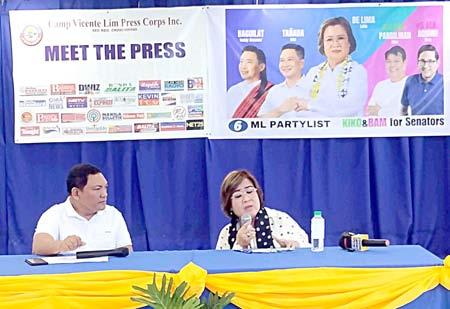
By Roy C. Tomandao
CALAMBA CITY, LAGUNA - Former Senator Leila de Lima, the first nominee of Mamamayang Liberal (ML) Partylist, announced her bid for a House seat in the upcoming 2025 elections during a press conference initiated by the Camp Vicente Lim Press Corps held here on January 8. In an interview with the Manila Standard, De Lima, a human rights advocate, expressed her commitment to continuing her advocacy for the rights of marginalized sectors and promoting social justice.
“My experience as a senator and my passion for public service makes me an ideal candidate for the House of Representatives,” De Lima said. The press conference was attended by lo-
cal media and supporters of the ML Partylist. De Lima’s announcement was met with enthusiasm and optimism from the crowd, who believed that her candidacy would bring about positive change in the country. As the first nominee of ML Partylist, De Lima is expected to play a key role in promoting the party’s platform and advocating for the rights of its constituents. Her candidacy is seen as a significant boost to the party’s chances in the upcoming elections. De Lima’s bid for a House seat is also seen as a comeback of sorts after she was detained for several years on charges that were widely criticized as politically motivated. Her experience during that time has only strengthened her resolve to fight for justice and human rights.



Higher US tariffs to have little impact on PH—PhilExport
THE Philippine Exporters Confederation Inc. (PhilExport) expressed confidence that Philippine exports to the US would remain strong despite the trade tensions between the US and china.
PhilExport president Sergio OrtizLuis Jr. also called for a de-escalation of geopolitical tensions between the Philippines and China.
“We hope [President Donald] Trump can lower geopolitics in the Philippines so we can recover the market we lost with our neighbors and China. Not only market but tourism and investment were also affected by geopolitics,” said PhilExport president Sergio Ortiz-Luis Jr., as he stressed the need for reducing tensions to help recover lost markets.
Ortiz-Luis said while the US recently imposed a 10-percent tariff on Chinese imports, this would have little impact on the Philippines.
“I don’t see the 10-percent tariff imposed on China affecting the Philippines because Chinese prices are so low. Even adding the 10 percent will not stop the US from buying from China,” he said.
He expressed confidence that Philippine exports to the US, the country’s largest export market, would remain strong despite the trade tensions between the two global economic powers.
Data from the Philippine Statistics Authority show that the US was the largest export market of the Philippines in December 2024, accounting for $94 million, or 16.8 percent, of the country’s total export value that month.
Other major export markets for the Philippines are Japan, China, Hong Kong and Singapore.
Othel V. Campos

By Darwin G. Amojelar
THE Philippines’ gross international reserves (GIR) fell to $103 billion as of end-January 2025 from $106.3 billion as of end-December 2024, the Bangko Sentral ng Pilipinas (BSP) said over the weekend.
The BSP said, however, the latest GIR level still represented a more than adequate external liquidity buffer equivalent to 7.3 months’ worth of imports of goods and payments of services and primary income. It was also about 3.6 times the country’s short-term external debt based on residual maturity.
The BSP’s reserve assets consist of foreign investments, gold, foreign exchange, reserve position in the IMF and special drawing rights.
The month-on-month decrease in the GIR level reflected mainly the BSP net foreign exchange operations and drawdown on the national government’s (NG) deposits with the BSP to pay off its foreign currency debt obligations. Similarly, the net international reserves (NIR) declined by $3.2 billion to $103.0 billion as of end-January 2025 from the December 2024 level of $106.2 billion, the BSP said. Rizal Commercial Banking Corp.
chief economist Michael Ricafort said that for the coming months, GIR could increase due to the $3.3 billion additional foreign commercial borrowings made by the national government in the latter part of January 2025.
This could be reflected in February 2025 that could be added to the country’s balance of payments (BOP) and GIR data.
“GIR equivalent to 7.3 months worth of imports in recent months, the lowest in more than 2 years or since 2022 and down from an immediate high of 8.1 months in September 2024; but still more than twice the international standard of 3 to 4 months and sustained well above the $100 billion mark, thereby could strengthen the country’s external position that is positive for sustaining the country’s favorable credit ratings of 1-3 notches above investment grade as consistently seen since the pandemic or over the past 4 years,” Ricafort said.
$103 billion
GIR as of endJanuary 2025
$106.3 billion $103.3 billion
GIR as of endDecember 2024
GIR as of endJanuary 2024
GCash recognized for its commitment to sustainability and inclusion by UN Women Asia-Pacific Awards and other international organizations
GCASH, the Philippines leading finance super app and largest cashless ecosystem, enjoyed a meaningful 2024, reaping accolades from prestigious international award-giving bodies for its efforts in digital financial inclusion, sustainability, and women empowerment, among many other game-changing innovations that help uplift the lives of the 94 million Filipinos that use its services.
GCash was recognized at the UN Women Asia-Pacific WEPs Awards, which honors companies taking action to achieve gender equality in the region, aligning with the organization’s Women’s Empowerment Principles. GCash was named 2nd runner-up in the awards’ newest category, Innovative Financing for Gender Equality, which highlights the importance of private sector financing in unlocking opportunities for women.
The Asia Corporate Excellence & Sustainability (ACES) Awards acknowledged GCash as the 2024 Industry Champions of the Year,
recognizing the company’s “innovative contributions, as well as its resilient pursuit of sustainable growth and digital empowerment for Filipinos,” noting its contributions in enabling financial well-being among Filipinos while championing both sustainability and security.
ACES went on to cite how the company’s achievements are punctuated by its rapid user adoption rate, leading to unparalleled market reach by serving both the unbanked and underbanked.
GCash’s efforts on strategic partnerships with the Philippine government were also lauded, recognizing their crucial role in accelerating the transformation of the country to a cashless society.
GCash was also named by the ACES Awards as one of the Top Sustainability Advocates in Asia, a recognition for companies whose sustainability initiatives are integrated in policies and operations, with high levels of involvement from top management and employees. GCash was cited as showcasing “how a digital fi-
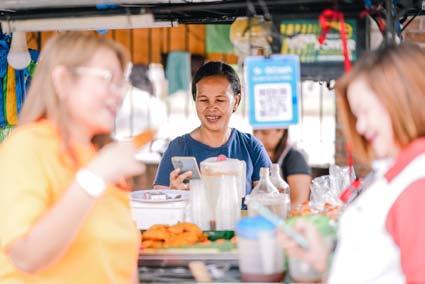

Catalina. This widespread effort aims to restore mangrove and beach forest ecosystems, which are crucial for environmental sustainability and local livelihoods.
nance platform can simultaneously drive profound environmental and social change.”
Through GForest, GCash has activated 21 million “Green Heroes” to plant 4 million actual trees, significantly contributing to environmental efforts through climate technology and boosting the livelihoods of Filipino farmers.
GCash also scored two wins at the 2024 ESG & Sustainability Awards, presented by ESG Business, which recognizes companies that pursue the UN Sustainable Development Goals (UN SDGs), receiving the Gender Equality and Women Empowerment Award for its efforts in promoting diversity, equity, and inclusion in
the workplace, particularly its programs that encourage more women to pursue careers in tech, and the ESG Business Award for Climate Advocacy, particularly for GForest, which demonstrates how a digital platform can create a movement for climate action.
Finally, the World Business Outlook Awards has named GCash as the Best Cashless Mobile Financial Platform APAC 2024, Best Fintech Solutions Provider APAC 2024, and Best Finance Super App APAC 2024—all indicating how the company is setting the standard for fintech tech solutions in the Asia-Pacific region, especially in providing solutions to unbanked
and underserved communities in an emerging market like the Philippines. These awards also acknowledge the strategic partnerships that GCash put in place to ensure the safety and security of its users, as well as efforts to attract and retain talent in the fintech industry.
“These awards are a testament to the hard-work & dedication of the 2000-strong GCash Team who continue to innovate towards our vision of Finance for All. We are excited for what 2025 may bring as we continue to pursue digital financial inclusion, environmental sustainability, and women empowerment,” stated Martha Sazon, GCash President and CEO.
ing the world’s biggest geothermal producer anew. The Philippines is the world’s third biggest geothermal producer next to Indonesia (second) and the US (first).
“We hope that it will be finalized this year,” Guevara said when asked then the ADB financing would materialize. The DOE previously said it was looking at a $250-million GDRF with ADB. Alena Mae S. Flores
JTI recognized No. 2 Top Employer in PH JAPAN Tobacco International (JTI) ranked No. 2 in this year’s
ROBINSONS Retail Holdings Inc.
(RRHI), one of the largest multiformat retailers in the Philippines owned by the Gokongwei Group, said it plans to spend up to P7 billion in 2025 capital expenditures primarily to roll out more stores.
RRHI said in a recent investor presentation about P5 billion to P7 billion would support the store expansion of various brands this year.
It plans to add 130 to 170 stores across its brands which include supermarkets, department stores, drug-
By Alena Mae S. Flores
By Othel V. Campos
THE Management Association of the Philippines (MAP) asked the Metropolitan Manila Development Authority (MMDA) to prioritize the Mabuhay Lanes as a key strategy to alleviate traffic congestion on EDSA, highlighting their effectiveness in enabling efficient “point-to-point” travel.
“The existing Mabuhay lanes should be revitalized and utilized fully for motorcycles, and more so because they travel ‘point to point,” said MAP president Alfredo Panlilio. He also called for the clearing of the Mabuhay lanes of all traffic ob-
structions and illegal parking, which is seen as a better solution considering the dismantling of the EDSA Carousel Line.
Panlilio warned that adding any extra lanes for private vehicles on EDSA would only result in more traf
fic congestion, as the lanes would inevitably be filled.
He said proposals such as congestion fee charges should be fully explained to motorists, let alone tested. Addressing suggestions that private vehicles could potentially outperform buses in terms of passenger capacity on the Busway, Panlilio said such a comparison is unrealistic, noting that the MRT-3’s design capacity is limited to 350,000 passengers. He said adding extra coaches or carriages could risk overloading the system’s superstructure and trackway and pointed out that there is no available space on the platforms to accommodate an extension of the train.

and Cavite-Laguna Expressway (CALAX) and a subsidiary of Metro Pacific Tollways Corp., receives three International Organization for Standardization (ISO) certifications. The company achieved certifications for ISO 9001 (Quality Management), ISO 14001 (Environmental Management), and ISO 45001 (Occupational Health and Safety), showcasing its commitment to operational excellence and sustainable business practices. Shown are DQS Certification Philippines president Romeo Bravo (left) presenting the certificates to the MPT South Management Committee led officer-in-charge Elnora Rumawak, (enter) along with MPTC chief human resource officer Maria Antonette Allones. (fourth from right) on Jan. 27, 2025 at the Sequoia Hotel in Pasay City. Joseph Muego
stores, convenience stores appliance and toy shops.
RRHI had 2,453 stores as of end2024, consisting of 761 food stores, 1,133 drugstores, 50 department stores, 227 DIY stores and 282 specialty stores. It also had 2,115 franchised stores of TGP.
RRHI has same store sales growth guidance of 2 percent to 4 percent and 30 to 40-basis-point increase in gross margins as domestic consumption is expected to improve amid stabilizing inflation rate.

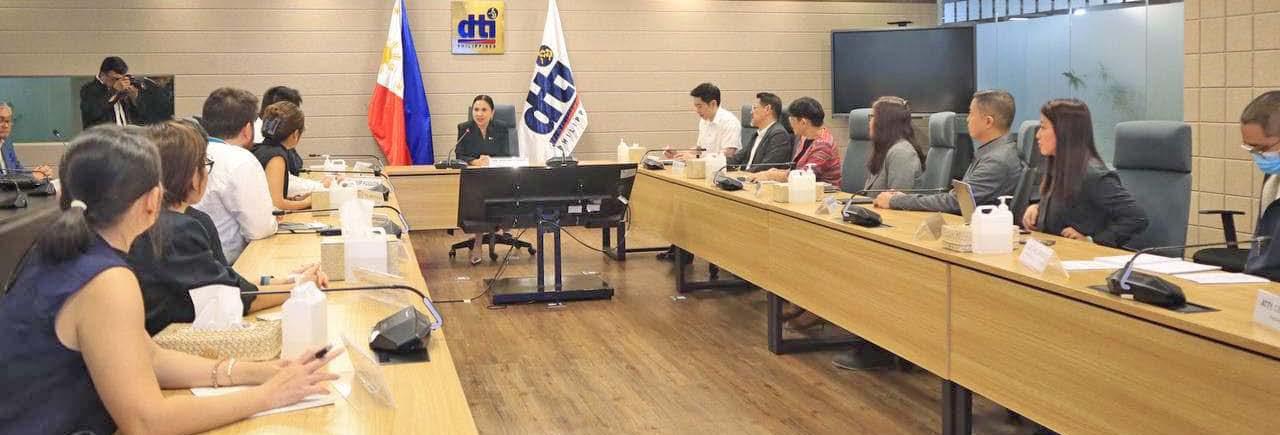
THE Department of Energy is studying options for the 232-megawatt Mindanao coal-fired power plant in Villanueva, Misamis Oriental, as the planned rehabilitation of the Agus-Pulangi hydroelectric complex in Mindanao gets underway. The DOE also welcomed congressional approval to extend the corporate life of the state-run Power Sector Assets and Liabilities Management Corp. (PSALM) for five years from June 26, 2026. PSALM manages the assets and liabilities of the National Power Corp.
“What has eluded us for decades now is the rehabilitation of the Agus-Pulangi,” Energy Secretary Raphael Lotilla said. “If we finish the rehabilitation...it will
power in Mindanao, which is very significant.” Lotilla said the Agus-Pulangi
RRHI president and chief executive Stanley Co said in a previous statement the company would look for more ways to grow the business, while continuing to integrate sustainability agenda into the group’s value chain.
The retail firm more than doubled its net income in 2024 to P10.3 billion, boosted by one-time gain from the merger of Robinsons Bank into the Bank of the Philippine Islands which was booked in the first quarter.
Core net income, which excludes extraordinary gains/losses, jumped 3.7 percent to P6.3 billion, driven by higher gross profit and improved operational efficiencies.
Consolidated net sales climbed 3.7 percent to P199.3 billion as samestore sales growth improved to 1.5 percent.
Food retail accounted for 60.4 percent of total net sales, followed by drugstores at 18 percent and department stores at 8.3 percent. Jenniffer B. Austria


By Jenniffer B. Austria
Philstocks
thority’s policy
and
amid current market conditions. “A cut in policy rates together with a dovish outlook is expected to give the market a boost,” Tantiangco said. The continued strengthening of the peso against the dollar, decline in long-term treasury yields and the strong inflows of foreign investors are also boosting market sentiment, Chartwise, the local market’s support is seen at 6,150 and resistance at 6,400.
Last week, the Philippine Stock Exchange index rallied by 4.99 percent to close at 6,154.99, while the broader all-shares index surged 4.07 percent to 3,663.64. Average daily turnover declined to P7.483 billion, down from previous week’s P9.411 billion.
Foreign investors were net buyers last week by P1.69 billion. The benchmark index, however, was still down 5.73 percent since the start of the year.
By Darwin G. Amojelar
GLOBE Fintech Innovations Inc. (Mynt), the parent company of mobile wallet GCash, said it is not exploring other options for its planned initial public offering, despite what it considers “too rigid” minimum public ownership requirements on the Philippine Stock Exchange.
“We have not really looked at other venues outside the Philippines today and (are) very optimistic that the PSE [Philippine Stock Exchange], and the SEC [Securities and Exchange Commission] will see that this IPO is quite unique in terms of its size, in terms of the interest of the public and the international investors, and that they will see things our way in terms of the need to look at this threshold that has been around for quite some time,” said Mynt chairman Ernest Cu.
“And we believe it is quite rigid. And given where our market is at, I think it’s in the best interest of everyone that they consider the reduction in public float,” he said.
The PSE issued guidelines in August 2020, requiring a company applying for initial listing through IPO to sell a minimum public offer size of 20 percent to 33 percent of its outstanding capital stock post-IPO.
“We are working to remove any kind of private equity overhang that may exist today when we go public,” Cu said.
Bloomberg News earlier reported that GCash was planning to raise $1

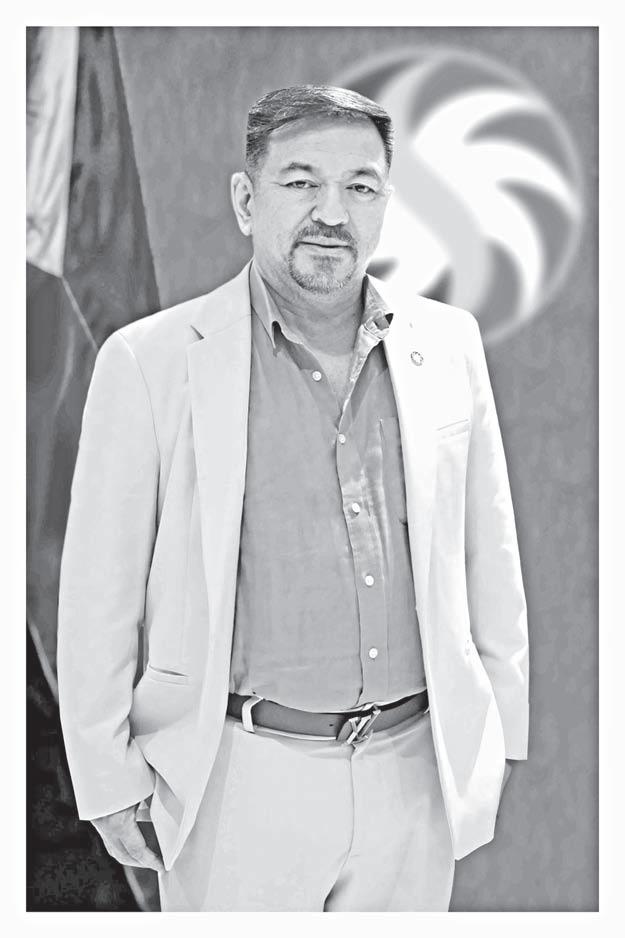
MELQUIADES A. ROBLES General Manager


The Philippine Charity Sweepstakes Office (PCSO) proudly joins in celebrating the 38th anniversary of Manila Standard with the theme “Empowering a Sustainable Tomorrow.”
For nearly four decades, Manila Standard has stood as a pillar of responsible journalism, delivering timely and accurate news that inform and empower the Filipino people. We deeply appreciate your commitment to truthful reporting, especially in sharing the PCSO’s programs that uplift the lives of many.
Your initiative in announcing Lotto winning numbers, jackpot prizes and jackpot winners is crucial in maintaining public trust and confidence in our games. By delivering correct and credible information, you help uphold the integrity of the PCSO’s lottery draws, ensuring that every Filipino has access to fair and transparent results. Through this, Manila Standard displays high regard to public service.
Correct and credible news do not only foster public trust but also strengthens national unity. Through integrity in journalism, Manila Standard continues to guide our nation toward a more sustainable and informed future.
Congratulations, and may you continue to inspire and enlighten generations to come and empower a sustainable tomorrow!
Mabuhay ang Malayang Pamamahayag! Mabuhay ang Manila Standard!




—“—
I am confident that our unwavering pursuit of excellence and superior value will continue to set us apart from our competition and provide us with the unique opportunity to offer homes that our customers truly deserve.

A— Alfredo I. Austria DMCI Homes president
MID challenges in the real estate sector, DMCI Homes, remains confident on the housing sector’s prospects, as housing continues to be a critical need for many Filipinos.
“Every year, thousands of new families are formed, and new households are created. Good housing remains a need, perhaps even a dream for many of our fellow Filipinos,” DMCI Homes president Alfredo Austria said.
With this in mind, the company is focused on delivering projects that provide long-term value, while adapting to the changing market landscape.
“I am confident that our unwavering pursuit of excellence and superior value will continue to set us apart from our competition and provide us with the unique opportunity to offer homes that our customers truly deserve,” Austria said.
Best-in-class
In an increasingly competitive real estate market, DMCI Homes has maintained its edge by offering highquality condominium units, flexible ownership options and a strategic expansion plan designed to meet


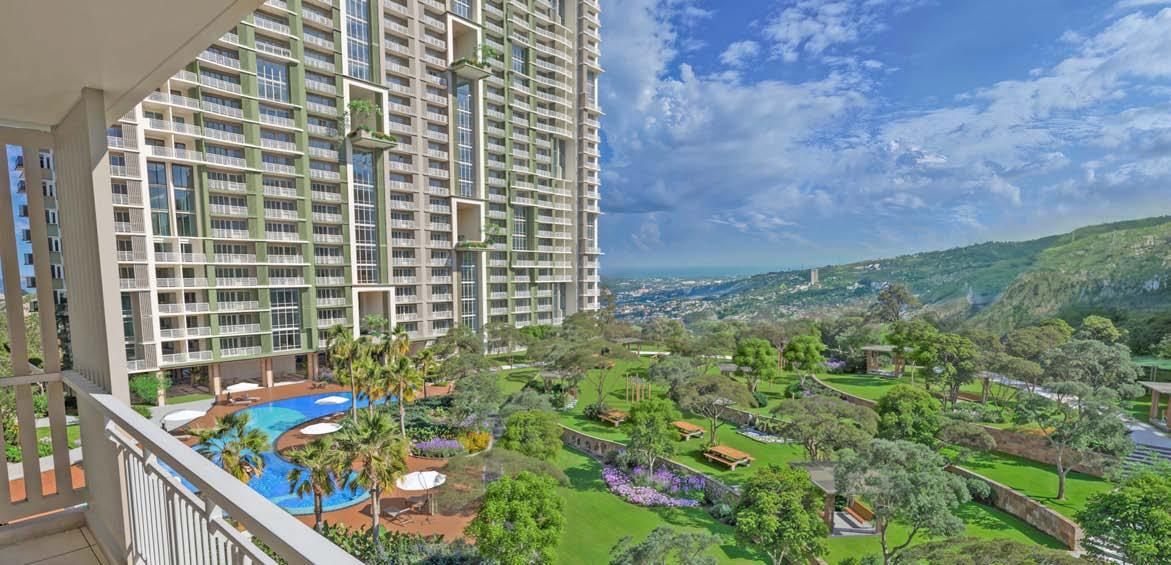
evolving market demands.
The company enhances its developments with innovative amenities such as subscription-free, commercial-grade fiber internet, a community shuttle service called RideShare, co-working spaces and a property management app.
These features cater to the changing needs of homebuyers, ensuring longterm value and satisfaction.
Strategic expansion
Over the past two years, DMCI Homes has expanded its portfolio to include leisure properties under the DMCI Homes Leisure Residences brand, in addition to its residential developments.
In 2023, the company launched
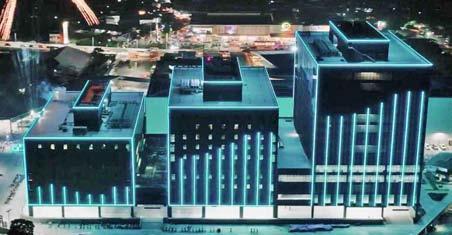



Solmera Coast in San Juan, Batangas, which quickly became a top performer, selling 74 percent of its launched units within just five months. It also launched Moncello Crest in Tuba, Bengue and Kalea Heights in Guadalupe, Cebu in 2024.
“By venturing into regional markets like Cebu, we aim to address the housing needs of a broader audience while contributing to local economic growth through job creation and infrastructure development,” said DMCI Homes vice president for project development Dennis Yap.
“Our expansion strategy also aligns with our vision of enriching lives by providing sustainable and well-planned communities across the

By Othel V. Campos
Philippines,” Yap said. Rent-to-own
In response to the challenges faced by potential homebuyers due to economic uncertainties, DMCI Homes has introduced the HomeReady Rent-to-Own (RTO) program. This initiative allows buyers to move into a home with a minimal down payment, rent for a set period and then have the option to purchase the unit later, making homeownership more accessible. The company also offers flexible payment terms and financing options, aimed at helping buyers who may be cautious about committing due to financial concerns.








By Peter Atencio
ERNEST John Obiena jumped a little higher and rewarded himself a gold medal —his first this year—at the Meeting Metz Moselle Athlelor in France late Saturday evening.
The 29-year-old Obiena cleared 5.7 meters on his first try, a leap 5 cms higher than his 5.65-meter performance, also on his first attempt, when he earned a silver
SHOWING maturity beyond her years, rookie Ishie Lalongisip rose to the occasion to keep shorthanded Cignal as one of the top contenders in the 2024-25 Premier Volleyball League (PVL) All-Filipino Conference. Following the shocking departure of main hitter and skipper Ces Molina and middle blocker Riri Meneses mid-season, the HD Spikers found a gem in the seventh overall pick in the first-ever Draft.

Lalongisip repaid the trust given to her by head coach Shaq Delos Santos by coming up with a stellar performance as she stepped up when Cignal needed her the most.
The Adamson University product was a revelation after dropping 13 points to help the HD Spikers arrest a two-game skid in a 25-12, 25-15, 2517 rout of Capital1 last Thursday at Philsports Arena. Cignal hiked its record to 6-3 and remained in the upper half of the standings. For her consistency and determination, Lalongisip earned the distinction as the first-ever rookie to win the PVL Press Corps Player of the Week presented by Pilipinas Live for the period of February 4 to 8.
“Ine-embrace ko lang yung role na binigay sa akin ni coach Shaq [Delos Santos], parang siguro yung pressure laging nandyan, ineentertain ko lang siya as positive,” said Lalongisip.
“Like everyday sa training, tinatiyaga ko lang din kahit nandon yung factor ng pagod, pero alam ko at the end of the day may natutunan ako sa ensayo namin,” she added.
medal at the International Jump Meeting Cottbus in on Thursday in Germany last week.
Obiena, who has just recovered from a back injury, tried go-
ing higher, but he missed all of his three attempts.
But the first leap proved enough as it was Obiena’s best so far in the new indoor season.
Menno Vloon wound up with the silver medal at 5.70 meters on countback, after he missed his tries at 5.80 meters.
Tokyo Olympics’ silver medalist Christopher Nilsen settled for third with 5.60 meters, missing out at 5.70 meters in all three of his attempts.
Obiena will see action on Sun-
day evening (Manila time) at the ISTAF Indoor in Dusseldorf, Germany. it was Obiena’s second meet since the Paris Olympics last August, after he withdrew from his remaining competitions for the rest of the year.
Obiena returned home and sought medical assistance to heal his bothersome back injury.
The back injury has hounded him during the Olympics and sidelined him from his earlier stints in the 2024 Diamond League series.
AT 39, cycling doesn’t stop—and so thus clinching a medal—for Mark John Lexer Galedo who clinched silver in the Masters 40-44 years old category of individual time trial (ITT) on Saturday at the Asian Cycling Confederation Road Championships in Phitnasulok, Thailand. Galedo clocked 28 minutes and 25.2 seconds in the 21-km race won by Thailand’s Tawatchai Jeeradechatam, who was 35 seconds faster than the Filipino, an ITT gold medalist at the Myanmar 2013 Southeast Asian Games.
Thailand’s Kritsana Keawjun clinched the bronze medal behind Galedo, in the Masters races where another Filipino, Roderic Calla was sixth in the 45-49 years old group.
A Special Citation awardee at the recent Philippine Sportswriters AssociationSan Miguel Corp. Annual Awards, Galedo has retired as an elite rider in 2024 and was classified in the 40-44 category in Phitnasulok based on his year of birth.

“I’m so happy for this victory and so inspired to see our flag being raised here,” said Galedo, who’s now one of the coaches a 21-cyclist national team competing in the championships through the PhilCycling, Philippine Sports Commission and the MVP Sports Foundation.
“Thank you to the PSC, POC [Philippine Olympic Committee] and PhilCycling president [Abraham] Bambol Tolentino, to 7Eleven Roadbike Philippines, to my family for the opportunity to compete here,” he said. Galedo, who won his fifth Tour of Guam crown before retiring last December, will also compete in the road race on Thursday.
National team coach Joey de los Reyes also clinched a bronze medal in Masters road race in last year’s Asian championships—also supported by the PSC—in Astana, Kazakhstan.
WITH Aleah Finnegan playing a supporting role, the no. 3 Louisiana State University Tigers grabbed three individual titles and the team honors in conquering the University of Alabama Crimson Tide, 197.300-197.075 on Friday night at the Coleman Coliseum.
This gave the Tigers their third triumph in four outings over no. 14 Alabama, following their road victory in the Southeastern Conference at Tuscaloosa, Alabama.
It was in the final rotation, where Finnegan stood out with her moves in the beam exercises.
The anchor routine was via the veteran performance of Finnegan, who bounced back from her dropped scores in the floor and posted a 9.875 to clinch a tough road victory for the Tigers. LSU’s final score in the beam led to a 49.250, allowing the Tigers to post a team win by a small margin.

The Tigers now have a 3-1 slate in the SEC standings. In the first rotation, Finnegan posted a 9.825 score at fifth spot on the floor, before McClain anchored it with a strong 9.90.
The 9.90s from McClain and Cowan were the joint-highest score in the event of the night, helping boost LSU’s rotation score to a 49.275. In the floor in the third rotation, a 9.675 was handed to Finnegan at fifth spot after a step out on a pass, but Haleigh Bryant anchored with a 9.875 to bring LSU’s floor tally to 49.325 for the event. This allowed Tigers to lead by a score of 148.050-147.575 heading to the final rotation of the night.
The victory marked the Tigers’ first road win in the SEC this season and was their fourth consecutive win over Alabama in the regular season. Peter Atencio
ABRAHAM “Bambol” Tolentino and David Lappartient—both presidents of their respective national Olympic committees (NOC) and cycling federations—met in Harbin on Friday and discussed significant topics bordering on their sport and the International Olympic Committee (IOC).
“From a casual conversation—hellos and how are you?—to the more significant topics concerning cycling and the forthcoming IOC presidential elections,” said Tolentino, president of both the Philippine Olympic Committee and PhilCycling, from China during the opening ceremony of the Harbin Ninth Asian Winter Games.
“As an active national federation of the UCI [International Cycling Union, which Lappartient heads as president], Dave [Lappartient] asked about cycling in the Philippines and expressed full support to our track program,” Tolentino said. “He was just too happy to learn that an indoor UCIstandard velodrome in Tagaytay City will be operational in a few months.”
A velodrome is being built in Tagaytay City,
where Tolentino is the mayor, and is expected to be operational by the middle of the year—the facility replaces the concrete and outdoor Amoranto Velodrome which the Quezon City government reportedly intends to demolish to give way to a football field.
“Dave also got serious about the IOC elections in March, stressing on his program for the world’s top sporting organization,” Tolentino said.
Lappartient, who heads France’s NOC, is one of seven candidates vying for the position that Thomas Bach will vacate after 12 years—the election is on March 21 in Olympia, Greece.
“We’re hoping and praying for Dave to win that election, and I personally believe he’s the most capable to lead the Olympic movement,” Tolentino said.
Lappartient traces his serious involvement with cycling to the Philippines when in 1995, he was a young member of the commissaires panel that supervised the country’s hosting of the Asian road and track championships at Amoranto and Subic.
He flew into Harbin from Bangkok where he

—The Kansas City Chiefs aim for a historic hat-trick of Super Bowl titles on Sunday when they take on the Philadelphia Eagles in front of a star-studded crowd in New Orleans headed by US President Donald Trump.
Trump, a strident critic of the National Football League over the years, will become the first sitting president ever to attend the Super Bowl when he takes his seat among a sell-out crowd of around 74,000 fans at the Caesars Superdome for the biggest annual event in the American sporting calendar.
Pop superstar Taylor Swift will also be in the VIP seats to watch as her boyfriend Travis Kelce and his Chiefs team-mates bid to become the first team in history to lift three consecutive Vince Lombardi Trophies.
Trump’s presence at the NFL showpiece will heighten security around an event which was already protected by a heavy police presence following the New Year’s Day attack which left 14 people dead and many more injured in the Big Easy’s famous Bourbon Street district.
“I’m confident the safest place this weekend will be under the security umbrella we have in place around (the Superdome),” Cathy Lanier, the NFL’s chief security officer, said this week. “We have reviewed, and re-reviewed, all the events of January 1.”
Trump’s groundbreaking attendance at the game comes against a backdrop of a strained relationship with the NFL stretching back several decades, when he sought to join the league as an owner in the early 1980s only to be rebuffed.
Trump also triggered uproar during

his first term as president when in 2017 he criticized NFL players who knelt during the playing of the US national anthem to draw attention to issues of racial injustice.
Players in Sunday’s game have so far walked a diplomatic line when asked about Trump’s presence, with Chiefs quarterback Patrick Mahomes saying playing in front of the US leader would be “cool.”
Fans in New Orleans meanwhile expressed hope that Trump does not politicize the occasion.
“I’m hoping that basically he comes in and he’s at his seat and they kind of like keep it quiet. I just want it
More Fil-Americans give PH women’s footballers a boost
By Peter Atencio
THIRTY-ONE players have been called up for a training camp that is in the works for the Philippine national women’s football team next month.
And there will be nine new faces, including elite members of the US varsity squad, in the national squad which will begin important preparations for a busy year.
Among them are Fil-Americans Autumn Cayelli and Malia Cerdon.
The 19-year-old Cayelli is a freshman playing for the University of South Carolina Gamecocks in the Division 1 meet of the US NCAA.
Cayelli, considered as one of the top collegiate players in the state, has made appearances in nine games as a rookie for her school.
The 5’7” Cerdon is a junior at the California Baptist University.
The other newbies responding to the call-up are Kaela Hansen, Nya Harrison, Ivymae Perez, Mallie Ramirez, Emma Tovar, Jaime Turrentine and Maysen Veronda.
Three players, Maddie Ayson, Nina Mathelus and Maz Pacheco, are said to have withdrawn due to injury.
The Philippine Football Federation has arranged a nine-day training camp that starts on Feb. 17, and ends on February 25.
The Filipinas, under coach Mark Torcaso, will first play in an exhibition at the newly completed Mall of Asia Football Field.
Torcaso said their preparations are focused on the ASEAN Women’s Championship, the Asian Cup Qualifiers and the Southeast Asian Games.
to be a fun game and not be political,” Debra Ward, a teacher from Virginia, told AFP.
As always, the Super Bowl crosses over into popular culture and the halftime show this year will feature hiphop artist Kendrick Lamar, who had a clean sweep at last Sunday’s Grammys, winning in all five categories for which he received nominations.
Bookmakers and casinos meanwhile are taking odds on whether Chiefs star Kelce will propose to pop icon Swift after what might be his final game in the NFL. Reports late Saturday said the 35-year-old is considering retirement after the Super Bowl.


American sports books, now legal in 38 states, could take an estimated $1.39 billion in bets on the Super Bowl according to an annual report from the American Gaming Association (AGA).
Chiefs favourites
For the more serious punters, the oddsmakers have the Chiefs as slight favourite for the game, a rematch of the Super Bowl from two years ago which the Chiefs won by three points.
The Chiefs defended their title last year, beating the San Francisco 49ers in Las Vegas and putting them one win away from an unprecedented “three-peat”. AFP

targets strong finish at ICTSI PH Ladies Masters







BACOLOD—Senior play, which takes the lid off of the 76th edition of the Philippine Airlines (PAL) Interclub on Monday, will have the Championship division playing the tree-lined Marapara on the first and last rounds and Binitin in the middle two with liftclean-and-place in effect because of rains here the past few days. And this comes as no surprise to Luisita non-playing skipper Jeric Hechanova, with Marapara the more difficult course owing to its length and trickiness, that’s why the team has a plan of playing its long hitters in the first and final rounds.
“I have no choice but to play my longer (hitting) guys at Marapara,” Hechanova said while refusing to say which of his players he has told of this ploy. “The length of the course will just demand a lot from the players, while the Binitin now is a thinking man’s course.”
Del Monte will be defending its maiden Senior crown, and Hechanova believes that the Bukidnon club is still the team to beat, with the Del Monte course in Bukidnon playing slightly similar to Marapara.
“And they have an intact line-up,” Hechanova said. “So there’s no doubt that they are the favorites.”
Del Monte ran away with its breakthrough title last year in Cagayan de Oro, winning by 17 points over Canlubang. The Yoyong Velez-skippered squad took an 18-point lead into last year’s final round and was never threatened, and that’s something that Hechanova feels will be key again this year.
“If we are going to contend for the title, we need to have a sizeable lead going into the final day at Marapara,” he said. “Otherwise, catching up on this course will be very hard to do in the final round.”
Canlubang is the third team seen as a force for the title. Led by Abe Rosal, the Sugar Barons have the second-most number of titles in the 55-years-old and above category after the Luisitans. “It’s a very wide-open tournament from where I see it,” Rosal said. “It’s such a balanced tournament that I see that team making the least mistakes as the team that wins it.”

WITH a blend of experience, preparation and excitement, Dottie Ardina is eager to showcase her game on a course that has been a familiar battleground since her amateur days.
“I’ve been practicing and working on my swing.
I don’t really expect anything, but the goal is always to win and do my best,” said Ardina, exuding both determination and humility ahead of the ICTSI Worldwide Link Philippine Ladies Masters at The Country Club in Sta. Rosa, Laguna.
The $200,000 tournament, a collaboration between the Korean LPGA, the LPGA of Taiwan (TLPGA), and the Ladies Philippine Golf Tour (LPGT), promises to be a thrilling championship when it is fired off on Wednesday (Feb. 12). Featuring a stellar lineup of top players from all three tours, the event is set for three days of intense competition, showcasing power, precision iron play and masterful putting.
It will also be a true test of endurance and mental toughness, with players facing the challenges of a well-manicured but demanding layout, coupled with the sweltering heat and swirling winds typical of this time of year.
For Ardina, holding it at the TCC in a competitive setting also brings a new level of excitement.
“It’s very exciting to play TCC again in tourna-
ment mode, not just in practice,” she said while emphasizing her eagerness to navigate the course under pressure.
Meanwhile, the traditional pro-am tournament kicks off today (Monday), featuring a select group of professionals paired with sponsors’ officials and guests in an 18-hole event. The tournament not only fosters camaraderie but also provides top contenders with a valuable opportunity to familiarize themselves with the challenging course ahead of the main competition.
Beyond personal aspirations, Ardina, an LPGA and Epson Tour campaigner, acknowledges the significance of the event, especially with the Korean LPGA Tour players joining the field.
“It’s great to host these international players. I’m excited to see how they will perform at the TCC, given its exacting challenge,” added the Paris Olympics veteran and one of the slew of ICTSIbacked players. With Koreans dominating the LPGA, Ardina believes their participation elevates the competition.
“The Korean LPGA Tour coming here to play is a good motivation for our local players and other Asian players. Next week will definitely feel like playing in the world’s premier circuit,” she said.
LOS ANGELES—Superstar big man
Anthony Davis dazzled in his Dallas debut before hobbling out hurt in the third quarter of the Mavericks’ 116105 NBA victory over the Houston Rockets on Saturday.
Davis had given Dallas fans still fuming over the trade of Luka Doncic plenty of reasons to welcome his arrival, scoring 26 points with 16 rebounds, seven assists and three of the Mavs’ 18 blocked shots.
But he pulled up in pain with less than three minutes remaining in the third period, departing with what the team called a lower-body injury.
There had been no contact when Davis stopped short and put his hand to his groin, heading immediately for the sideline. Davis, whose Mavs debut was delayed as he recovered from an abdominal strain, downplayed the injury after the game, saying it was “nothing serious.”
“I’m fine,” he said, adding that he felt “a little spasm” in his groin-quadriceps area and could not get it loose. Even so, the injury will likely fuel the ire among some Mavs fans at the trade that brought Davis from the Los Angeles Lakers in exchange for Doncic -- the 25-year-old Slovenian star who led the team to the NBA Finals last season.
Some gathered outside American Airlines Center before the game with signs calling for general manager Nico Harrison to be fired.
Huge ovation Nevertheless, Davis received a huge ovation when he was introduced and the cheers were even louder when he fed Daniel Gafford for an alley-oop dunk for the first points of the game. Davis had 14 points on six of eight shooting in the first quarter with eight rebounds, three assists and a block as the Mavs surged clear of the Rockets and coasted to a comfortable victory. AFP


Nickie Wang




T“I’m
and controversies,” she said in the vernacular when asked about frequently being involved in issues.
Despite always being in the spotlight (and sometimes for the wrong reasons), she chooses to see it in a positive light.
“It just means people care about me, so in a way, I find it amusing. I’d rather have people pay attention than not at all. I’m not an attention seeker, but maybe they just enjoy making issues about me. Still, I’m thankful because it means I’m being noticed.”
Her latest TV project follows the success of her 2023 GMA drama series Magandang Dilag, which was overshadowed by controversy when private messages between her and her leading man, Rob Gomez leaked online.
During a press conference, Herlene admitted that the incident deeply affected her,












V COMEDIENNE and beauty queen Herlene Budol acknowledges that she often becomes the subject of public scrutiny.
leading her to seek psychiatric help to process what had happened.
When asked if she feared the controversy would end her career, she said she has moved on, though she and Rob never reconciled.
“I’m not mad at him anymore. I’ve let go of all the negativity in my heart. Maybe we just never got the chance to fix things. I’m not angry, but we’re not okay,” she said.
Looking back on the issue, Herlene said she was never afraid because she knew the truth. What hurt her the most was that no one defended her.
“I wasn’t scared because I knew what was true. What worried me was—why wasn’t I defended? Out of everyone involved, why did no one speak up?” she said.
Without naming anyone, she added, “He knows who he is. We all know the truth.”
“I feel like he wanted what happened. But he should have spoken up—I would have accepted that more. He should have acted like a man,” she continued, not mentioning any names.
Herlene takes on a new leading role Despite past controversies, Herlene is eager

to take on a new challenge in Binibining Marikit , where she plays Marikit, a witty yet strong-willed member of the indigenous Dumagat Remontado tribe. As a tour guide for her family’s travel company, Marikit finds herself in the middle of a battle when wealthy and powerful figures attempt to take their ancestral land.
Beyond protecting her community, Marikit also struggles with the absence of her mother, who left years ago. Seeking companionship, she turns to a dating app and meets a man who seems to be her perfect match—until she realizes she has fallen victim to a love scam.
Joining Herlene in the series are Pokwang, Tony Labrusca , and Thai-Irish model-turnedactor Kevin Dasom. Also part of the cast are Almira Muhlach, Thea Tolentino, Cris Villanueva, Ashley Rivera, Jeff Moses, Migs Almendras, and John Feir
Directed by Jorron Lee Monroy Binibining Marikit premieres today at 2:30 p.m. and will air Monday to Saturday.






FORMER Pinoy Big Brother: Gen 11 housemate Jarren Garcia introduced himself as a recording artist with the launch of his self-titled debut album under StarPop, joining fans at That Boy, Jarren, a listening party and fan meet held at SM City North Edsa Skydome on Saturday, Feb. 8.
The album features eight tracks, including the lead single “Gimme, Gimme, Gimme,” a song about searching for the right person after an unappreciated love.
“It talks about finding and receiving the love that you deserve after being with someone that didn’t appreciate you,” Jarren shared in a recent interview. He co-wrote the track with StarPop label head Roque “Rox” Santos and ABS-CBN Music operations and

creative head Jonathan Manalo
The album draws from R&B, soul, and ballad influences and includes “Make It, Make It Sense,” “Impulsive,” “Pardon My Pace,” “Never Go Away,” “Future,” “Without Warning,” and “Hits Different.”
Jarren performed live at the event, with special guests Kai Montinola and Kolette Madelo joining him on stage. Regular tickets sold out ahead of the show, while VVIP and VIP packages gave fans a chance for closer interaction with the singer. Before his PBB stint, Jarren competed in The Voice UK in 2020. He is now a MYX VJ, a mainstay in ASAP with Rockoustic Heartthrobs, and appears weekly in It’s Showtime Jarren’s self-titled album is now available on streaming platforms.
IN TODAY’S dating scene, relationships fizzle out fast—breakups go viral and memes make heartbreak a spectacle. But, deep down, people still long for a love that stands the test of time.
This Valentine’s season, McDonald’s once again tugs at the heartstrings of Filipinos with its latest film, #ForeverDate, celebrating love’s quiet strength in life’s fragile moments.
The film, featuring veteran actors Eva Darren and Leo Rialp, tells
the story of a couple whose love has remained steadfast through the years, with McDonald’s serving as a silent witness to their treasured moments.
Directed by Joel Limchoc of Film Pabrika and conceptualized by Leo Manila, the narrative follows a devoted husband patiently waiting for his wife to get ready for their date. In a quiet but deeply moving moment, he gently draws her eyebrows when her trembling hands can no longer do so.
The film ends with the couple sitting together on a park bench, sharing

their favorite McDonald’s Fries. “In a time when social media is filled with stories of fleeting love and viral breakups, it’s good to be reminded that such love exists,” said Ada Lazaro, chief marketing officer of McDonald’s Philippines. “We hope this feel-good film fills our timelines with more heartwarming stories about true love.”
The new campaign includes exclusive #ForeverDate P88 McCafé deals available on the McDonald’s App until Feb. 16.






was meant to banner inclusivity and diversity. I personally think some designs were courageous, authentic, and sometimes eccentric, breaking free from the constraints of gender stereotypes, materialism, and perfectionism.
I considered the event a medium for self-expression, selfdiscovery, and beautiful storytelling using couture as a transformative art form. Every piece manifested an emotional depth in every seam and stitch of the handcrafted and woven tapestries.
Overall, these next-gen designers bannered their unique subconscious and irrational expressions, producing designs that flowed between the worlds of the living and the supernatural in a colorful display of the surreal, the absurd, and the fanciful.
At the end of the show, three outstanding designers were given awards. The most prestigious Emerging Creative Talent
NOT too long ago, I received an invitation from a good friend to join him for a weekend event on Philippine fashion named Sinulid. Curious to find out what the latest couture on the home front is, I agreed to join him in what I thought was an exhibit.
It took me by surprise when I was ushered into a front-row seat in a crowded hall with a long fashion ramp inside the De La Salle College of St. Benilde Design and Arts Campus.
The show turned out to be the annual culminating event of the graduating Fashion Design and Merchandising (FDM) students of the school. Thirty-four student designers were featured, showcasing style innovations that bannered the depths of their dreams and subconscious, as shown in the photos on this page.
Sinulid shows the designers’ bold move to display beauty in unconventional and thought-provoking designs, with distinct creativity and individuality deeply rooted in the personal journeys of the young artists. The more than a hundred designs showed a striking balance between symbolism and transformation, encapsulated in various ensembles—from ready-to-wear to contemporary to avant-garde.
Although there were also ultra-modern designs for men, femininity took center stage, as the selections delved into the different facets of womanhood—from the tender and nurturing to the fierce and bold, and everything in between.
Of course, I also noticed some experimental pieces that challenged the audience’s inner mind and societal norms, although fluidity in the traditional designs




profusion of colors from the Imahinasyon sa ‘Banyera Collection’ of Elijah Mananghaya











Award was bestowed on Gemma Santos whose collection was thought-provoking, with a vision to explore new concepts and the ability to create a fashion-forward and directional collection.


The Fashion Innovation Award went to Serena San Jose , as her collection provided a new and innovative design that addressed sustainability, while the Brand Concept Award was received by Alessandra Gwyneth Caamic , whose collection

HONG KONG Disneyland Resort (HKDL) is kicking off a year-long celebration this summer with a star-studded lineup of new shows, grand parades, and exclusive offerings. Dubbed
The Most Magical Party of All, the milestone anniversary promises guests an unforgettable experience—it’s a celebration like no other. A brand-new, anniversary-only castle stage


showcased a strong narrative of a brand, recognizing the value it holds in the market.
The show was certainly an eye-opener for me as I realized how our next-gen fashion force has skillfully equipped themselves with the creativity and mastery of what makes avant-garde fashion acceptable. I am proud of these thirty-four graduating fashion design students, whose creations are ready to impress the rest of the world, and happy that the De La Salle College of St. Benilde offers the academic program to hone their skills. For feedback, I’m at bobzozobrado@gmail.com




In addition to the stage show, the celebration will feature “Friendtastic!”, the largest parade ever seen at HKDL. The parade will take over Main Street, U.S.A., with 11 lively floats and dancers in dazzling costumes. Guests will be transported into a world of spectacle, dancing to the rhythm of upbeat tunes as their favorite Disney characters come to life.
show will welcome guests, featuring Mickey and Friends, Duffy and Friends, and beloved Disney princesses. The high-energy performance, staged in front of the Castle of Magical Dreams, will infuse the park with excitement, offering captivating rhythms, vibrant dance numbers, and stunning theatrics that embody the party spirit of HKDL’s celebration.

As part of the festivities, the resort will also present a special 20th-anniversary edition of Momentous, the nighttime spectacular. This enhanced version will include even more Disney stories, mesmerizing projections along Main Street, U.S.A., and breathtaking drone choreography, all designed to create a magical conclusion to each day’s celebration.
The anniversary festivities extend beyond performances. Throughout the resort, guests will encounter 20th-anniversary-themed decorations, exclusive merchandise, and photo opportunities with Mickey, Duffy, and Friends dressed in celebratory outfits. The resort’s eight themed lands will also showcase a mix of classic and exclusive attractions, from the enchanting Castle of Magical Dreams to the world’s first and largest Frozen themed land. Guests are required to purchase their tickets in advance and have a valid park reservation for their visit. Refer to the latest visit arrangements on Hong Kong Disneyland’s official website: https://www.hongkongdisneyland.com/














































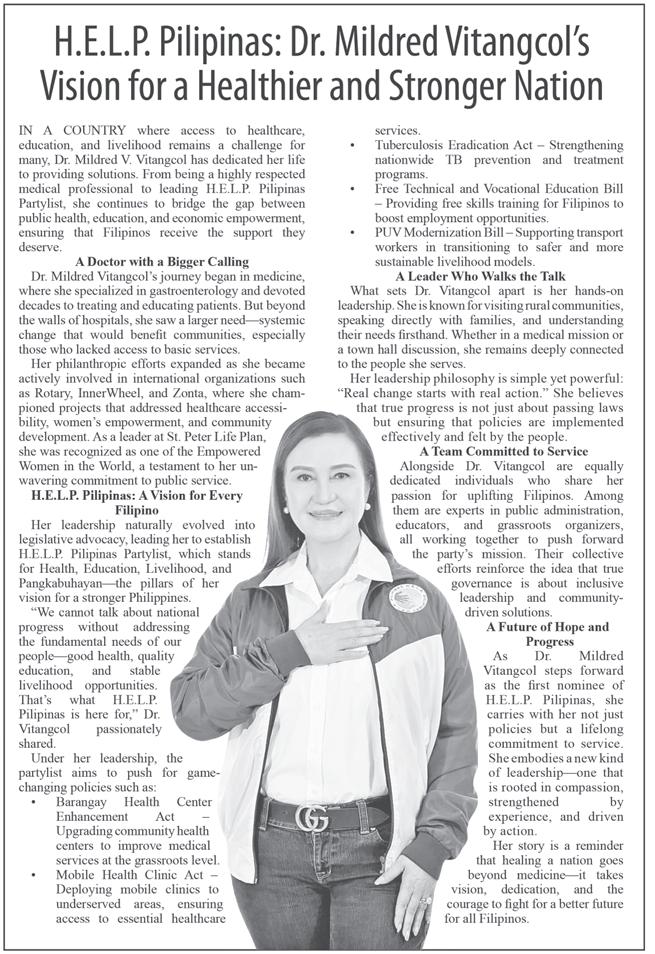
THE Department of Energy (DOE) recognized TeaM Energy Foundation, Inc. (TEFI) for its outstanding contribution to sustainable energy at the recently concluded Sustainable Energy Awards 2024. TEFI’s Productive Use of Renewable Energy (PURE) 4th Pilot Project in Barangay Bago, Don Salvador Benedicto, Negros Occidental, was celebrated for its innovative approach to renewable energy and rural development.
The PURE pilot project, implemented in partnership with the Bago Integrated Solar Farmers Association (BISFA), features a renewable energy-based post-harvest solution designed to benefit local pineapple farmers. This initiative was made possible through the collaborative efforts of TEFI, the Department of Energy, and the European Union-supported Access to Sustainable Energy Program (EUASEP). The project is powered by a 4-kilowatt solar photovoltaic system, which drives a decorticating machine to produce high-quality, export-ready piña fiber from pineapple leaves. Piña fiber, a sustainable and versatile material, is highly sought in the international textile market for its use in clothing and as an alternative to leather.
TEFI supported the project through funding for the fabrication of the solar-powered decorticating machine, the procurement of solar components such as panels and batteries, and the construction and renovation of the powerhouse facility. The Department of Energy and EU-ASEP provided technical assistance in the preparation of a feasibility study for the project with early coordination with the local government to ensure the project’s successful implementation. The LGU of Don Salvador Benedicto provided a cash counterpart in the completion of the PURE building.
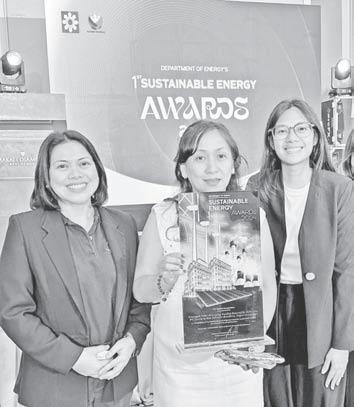
the Sustainable Energy
of the foundation’s transformative efforts in renewable energy and rural development.
Don Salvador Benedicto, known as the primary pineappleproducing region in Central Visayas with over 2,000 hectares of pineapple fields, has embraced this transformative initiative. By utilizing renewable energy to process agricultural by-products, the PURE project underscores the region’s commitment to sustainability and innovation.
“The PURE pilot project is a testament to how renewable energy can drive rural development and improve livelihoods. By providing this solar facility, we are empowering farmers and contributing to a greener economy,” said Maria Teresa Lopez, vice president of TEFI.
TeaM Energy Foundation is the social development arm of TeaM Energy, which operates the 735 MW Pagbilao Power Station in Quezon and holds a 50 percent stake in the adjacent Pagbilao 3 Power Project.






By Charles Dantes
SUSTAINABILITY is at the forefront of President Ferdinand “Bongbong” Marcos Jr.’s administration, as the Philippines accelerates its transition toward a greener and more resilient future.
With a strategic focus on renewable energy, climate-resilient infrastructure, and sustainable agriculture, his administration is implementing forward-thinking policies aimed at reducing carbon emissions, strengthening disaster preparedness, and promoting long-term environmental stewardship.
These initiatives not only drive economic progress but also ensure that future generations inherit a more sustainable and climate-secure nation.
PUSH FOR RENEWABLE ENERGY
One of the biggest moves in this direction is the push for renewable energy.
In November 2024, Mr. Marcos led the groundbreaking of the Meralco Terra Solar Project, a massive 3,500-hectare facility in Nueva Ecija. By 2027, this solar farm is expected to generate 3,500 megawatts of electricity—enough to power more than two million homes—while cutting carbon emissions by over 4.3 million metric tons each year. That’s like taking three million gasoline-fueled cars off the road.
Beyond this, the government greenlit 126 renewable energy projects, with a potential output of 31,000 megawatts.
These initiatives include wind, geothermal, and hydropower plants, marking a significant shift away from fossil fuels.
The Department of Energy also rolled out incentives to attract both local and foreign investors, ensuring that renewable energy becomes a long-term pillar of the country’s energy security.
SHAPING PH TRANSPORTATION
Sustainability is also shaping the way Filipinos move.
In December 2024, the president approved five major Public-Private Partnership (PPP) transportation projects
designed to create more efficient and lowemission transit options. Among them are the expansions of the North-South Commuter Railway, the Metro Manila Subway, and the Mindanao Railway, which will offer faster, greener alternatives to traditional travel.
The government is also championing the shift to electric vehicles (EVs) by promoting the construction of charging stations and incentivizing businesses and consumers to make the switch under the Electric Vehicle Industry Development Act (EVIDA).
INTERNATIONAL COMMITMENTS
On the global stage, the Philippines is making its commitment to sustainability clear.
In December 2023, President Marcos joined other leaders in Tokyo for the Asia Zero Emission Community (AZEC) summit, reinforcing the country’s goal of reaching net-zero emissions.
Additionally, the Philippines was selected to host the board of the “Loss and Damage” fund, an international initiative established by the UN to support nations most affected by climate change.
Disaster preparedness is another key priority, given the Philippines’ vulnerability to typhoons, earthquakes, and rising sea levels.
In October 2024, Mr. Marcos called for stronger, more coordinated disaster risk reduction efforts to safeguard communities and align national policies with global climate goals.
The government has since increased funding for flood control systems, early warning technologies, and emergency response programs.
At the same time, reforestation initiatives—such as the National Greening Turn to D2
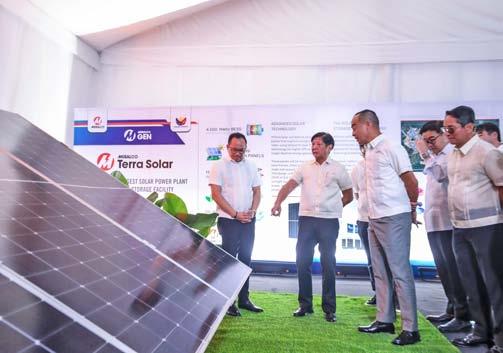

Marcos...From D1
Program and expanded mangrove restoration projects— are helping to rebuild forests and protect coastal areas.
SUSTAINABLE FOOD PRODUCTION
In the agricultural sector, sustainability is being woven into the fabric of food production. Through a partnership with South Korea, the Philippines introduced climate-smart greenhouses and post-harvest facilities in key farming provinces like Quezon, Laguna, and Nueva Ecija.
Digitalization and innovation are central to building a resilient and sustainable future by optimizing resource use, promoting clean technologies, and supporting smart cities and infrastructure.
—President Ferdinand Marcos Jr.
These innovations aim to boost food security while reducing agriculture’s environmental footprint. Additionally, the Department of Agriculture is ramping up investments in organic farming, sustainable fisheries, and climate-resilient crops, supporting local farmers as they transition to eco-friendly practices.
President Marcos’ sustainability agenda is shaping a future where economic progress goes hand in hand with environmental responsibility. By investing in clean energy, green transportation, disaster resilience, and sustainable agriculture, the administration is laying the foundation for a Philippines that thrives not just today, but for generations to come.
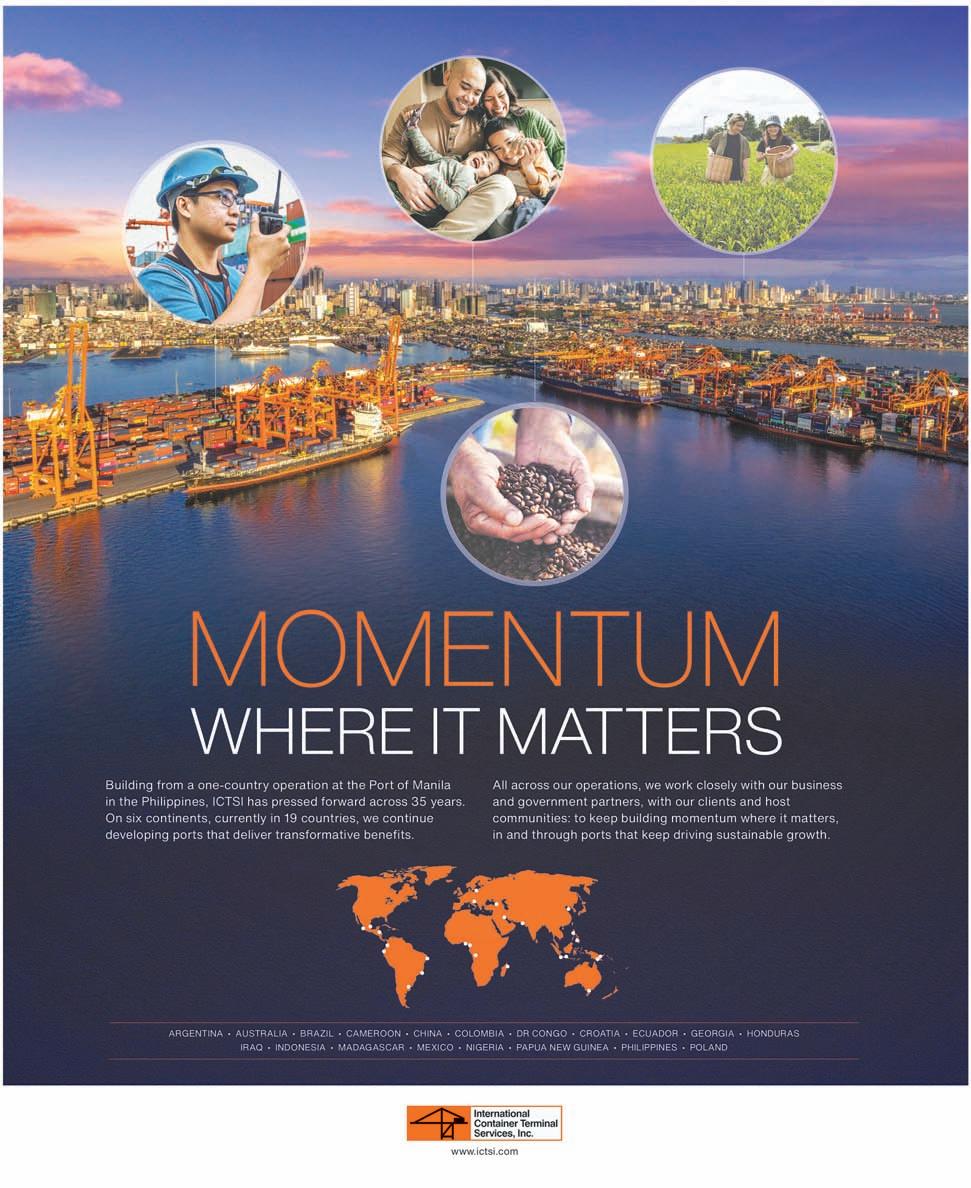
By Ratziel San Juan
THE Department of Science and Technology’s (DOST) premier textile research and development arm known as the Philippine Textile Research Institute (PTRI) successfully launched several initiatives designed to extend the life cycle of Philippine Tropical Fabrics (PTFs).
DOST-PTRI recently held its 2025 National Textile Convention (TELACon), a two-day event showcasing efforts to promote sustainability in the local textile industry through circular design principles. This year’s TELACon featured insightful discussions on policy, sustainability practices, program launches, and notable partnerships, including collaborations with key industry stakeholders.
TELACon’s first day established a whole-of-value-chain circularity framework for the local textile ecosystem. Namely, it held the key session “SusTELAbility: Fostering a Circular Economy” to promote closed-loop systems, upcycling, and life-cycle analysis (LCA) to assess the environmental and socio-economic impacts of textiles. Another keynote session “Science, Technology, and Innovation as Drivers to Textile Circular Economy” underscored the role of technological advancements in driving sustainability. It explored challenges like waste reduction and resource efficiency, with practical case studies on how innovation can foster a circular textile economy. Meanwhile, TELACon’s second day introduced notable developments in the textile industry, particularly several strategic partnerships and program launches. A major partnership with Cebu Pacific Air is set to promote Philippine textiles and destinations by showcasing local weaves through the airline’s platform. Key initiatives were launched, including the Halal Textile Science and Technology Program that aims to develop textiles that meet Halal standards for both local and international markets.


DOST-PTRI will strengthen the Bamboo Textile Fiber Innovation Hub in partnership with Timpuyog Dagiti Mannalon Ti Casilagan and the Health, Education, Environment, and Discipleship Foundation. The agency will likewise
collaborate with the University of the Philippines Diliman to advance bamboo textile research. It is also working with Creative Definitions to test and refine alternative leather materials made from natural fibers like pineapple, promoting sustainable textile solutions. A collaboration with HeArteFino seeks to empower local artisans, focusing on product development using PTFs like poly/piña and bamboo fabrics, as well as nonwoven materials like leatherlike nonwovens. Furthermore, the Philippine Tropical Fabrics Technical Committee panel discussed key accomplishments and plans for the industry. The Legislative Framework and Policies in Support of Philippine Textiles forum also examined how government policies can facilitate the promotion and use of PTFs. The event culminated in the KatHABI Fashion Innovation Show featuring government-appropriate uniforms made from PTFs.
“By weaving circularity into every aspect of textile production and embracing innovative business models, we aim to create a more responsible and sustainable future,” DOST-PTRI Director Dr. Julius L. Leaño Jr. said.

By Ram Superable
THE climate crisis is no longer a distant threat; it is a reality that the Philippines faces with increasing intensity.
With typhoons becoming more destructive, sea levels rising, and extreme heat waves affecting livelihoods, the Senate is stepping up to address these environmental challenges.
In the 19th Congress, several bills and resolutions have been introduced by senators aiming to bolster climate resilience, promote sustainability, and future-proof the nation.
Below is a rundown of the most significant legislative efforts currently in the pipeline.
• Senate Bill No. 650: Climate Change Emergency Declaration Act (Author: Senator Imee Marcos)
This bill seeks to officially declare a climate emergency in the Philippines, recognizing the urgency of addressing climate change through aggressive policies and sustainable solutions.
“A need for resiliency and adaptability to the effects of climate change is imperative and the declaration for an environment and climate emergency is necessary for the protection and preservation of the environment,” Marcos stated in her explanatory note.
The bill puts the spotlight on the need for a coordinated, multi-sectoral approach to mitigate climate risks and adapt to their consequences.
The measure also mandates a climate change emergency summit to be held in the second week of September every year, spearheaded by the Climate Change Commission and shall be participated by all relevant stakeholders.
• Senate Resolution No. 153: Declaring
a Climate and Environmental Emergency (Author: Senator Loren Legarda)
Similar to SB 650, this resolution calls for government agencies, local government units, and various institutions to mobilize resources and align policies with existing climate laws.
LGUs will be encouraged to issue Climate Change Declarations and adopt a “No to Coal” or “No to New Coal Policy” within their respective jurisdictions; and a national integrated risk information system and a national loss and damage registry will be established to support science-based policy formulation and risk governance at national and subnational levels.
“In declaring a climate emergency, a government admits that global warming exists and that the measures taken up to this point are not enough to limit the changes brought by it, stressing the need for the government and administration to devise measures that try and stop human-caused global warming,” the senator stated in the resolution.
• Senate Bill No. 18: Sustainable Cities and Communities Act (Author: Senator Pia Cayetano)
With urbanization accelerating, this bill proposes a framework to develop environmentally sustainable and resilient cities.
It mandates the integration of green infrastructure, efficient transportation, and waste management systems into urban planning.
The measure also calls on the Department of Interior and Local Government (DILG) to provide the necessary technical assistance and resource augmentation to LGUs to assist them in transitioning into sustainable cities and communities.
“This rapid urban migration resulted from the popular view that urban areas offer better opportunities for the rural poor. However, this has instead led to the increase in the incidence of urban poverty and inequality, as well as homelessness and Informal settlement in our cities,” Cayetano said.
• Senate Bill No. 157: National Energy
Policy and Framework for a Clean and Just Energy Transition Act (Author: Senator Sherwin Gatchalian)
Recognizing the urgent need for a shift to sustainable energy sources, this bill lays the groundwork for a national energy transition framework.
It seeks to promote renewable energy adoption, increase energy efficiency, and ensure a just transition for workers affected by the gradual phase-out of fossil fuels.
“The Philippine Energy Plan (2020-2040) fails to provide a clear energy transition framework given the country’s NDCs (nationally determined contributions) and the aforementioned policies laid out in RA 7638, RA 9136 and RA 9513,” Gatchalian said.
“Through this bill, it is hoped that the country will be able to comply with its commitments under the Paris Agreement while ensuring that the transition shall be fair and inclusive,” he added.
By aligning the country’s energy policies with climate goals, the bill aims to strike a balance between economic growth and environmental stewardship.
• Senate Resolution No. 549: Inquiry on the Impacts of Natural Extreme Events, Disasters, and Climate Change on the Agricultural Sector (Author: Senator Joel Villanueva)
This resolution highlights the vulnerability of the agricultural sector to climate change.
With over 10 million Filipinos dependent on agriculture, the resolution calls for an investigation into climate-induced crop losses and the effectiveness of the government’s agricultural insurance programs.
“There is a need for the government to determine the gaps in the current agricultural insurance system and put in place a whole-of-government approach in determining solutions,” Villanueva said.
• Senate Bill No. 869: Mandatory Environmental Insurance Coverage Act (Author: Senator Grace Poe)
This measure proposes mandatory environmental insurance for businesses and industries, ensuring that financial resources are
available for ecological rehabilitation in cases of environmental disasters.
“There remain lapses in the protection of the people’s right to a healthy and balanced ecology. In particular, environmental degradation and manmade disasters which arise from economic activities are extremely underregulated,” Poe said.
The measure states that the said insurance will be used to compensate for damages and to rehabilitate any environmental impairment caused by their operation.
It will also answer for all claims for the payment of damages to health and property; and the environmental rehabilitation, remediation and clean-up costs and expenses.
• Senate Bill No. 2609: Philippine Environmental Assessment System Act (Author: Senator Loren Legarda)
This bill proposes the establishment of a comprehensive environmental assessment system to ensure that all government and private-sector projects comply with stringent environmental protection standards before implementation.
“The bill advocates for the selection of the most environmentally friendly alternatives that can effectively meet national demands and priorities. This approach aims to ensure that environmental factors are considered at a strategic level, providing a comprehensive framework for decision making,” Legarda said.
• Senate Bill No. 1887: Climate Change Education Act (Author: Senator Imee Marcos)
Recognizing the role of education in climate action, this bill seeks to integrate climate change topics into the national curriculum to raise awareness and foster proactive environmental stewardship among students.
“Mandating the subject on climate change will help people, especially the youth, in understanding and addressing the impact of global warming, increasing ‘climate change literacy,’ and encouraging changes in their attitudes and behavior to protect and preserve our environment,” Marcos said.
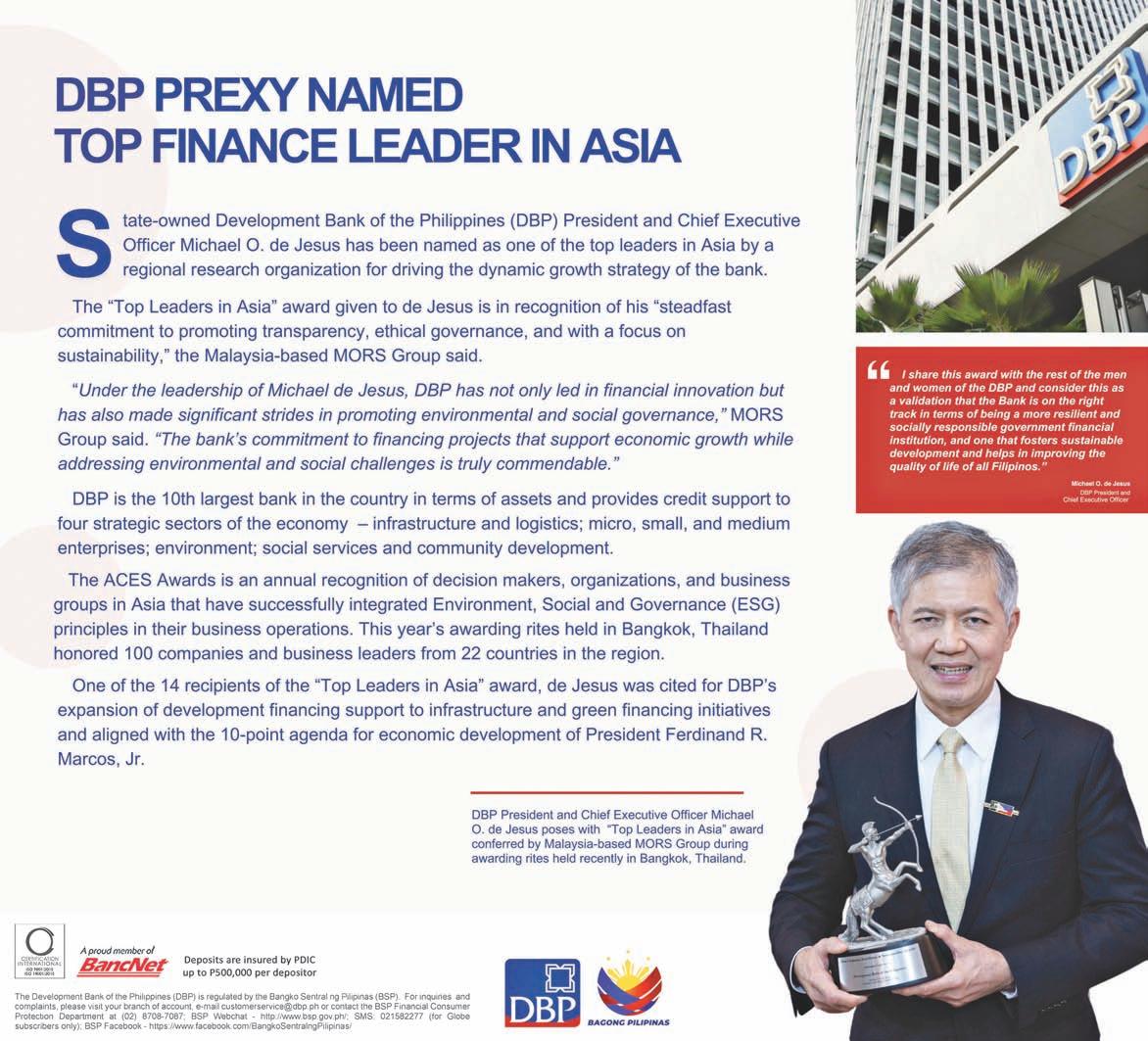

By Maricel V. Cruz
THE House of Representatives will continue to be vigilant against climate change which has caused increasingly severe weather disturbances in the Philippines.
Thus said Speaker Martin Romualdez as the chamber is committed to tackle legislative actions that encourage climate resilience.
“We must be vigilant against climate change to protect our people from falling victim to such tragedies,” said Romualdez who represents the First District of Leyte, one of the provinces hardest hit by Typhoon Yolanda in 2013 that claimed over 6,000 lives.
He said the fight against climate change need everyone’s cooperation.
“It takes a whole-of-society approach to combat climate change effectively. We need everyone’s cooperation.”
The House was instrumental in the recently enacted Ligtas Pinoy Centers Act which mandates the establishment of permanent, stormresilient evacuation centers all over the country, which are intended to provide safe refuge for communities during natural disasters.
This landmark measure represents a vital step forward in addressing the challenges faced by communities repeatedly battered by disasters
and calamities, enhancing our nation’s preparedness and response mechanisms to safeguard lives and livelihoods.
Romualdez actively pushed for the enactment of the measure— that President Marcos signed in December 2024, saying the tragedy that happened during Yolanda and similar strong typhoons should not be repeated.
The centers would be equipped with essential facilities, including healthcare stations and areas for vulnerable groups, to ensure safety and dignity for all evacuees.
“No matter how strong the coming typhoons, we must ensure that our people are prepared,” said Romualdez.
Apart from the Ligtas Pinoy Centers Act, the House is also currently deliberating on several measures on climate change resiliency and sutainability.
These include HB 9609 or the Climate Accountability (CLIMA) Act which seeks to establish a legal framework for climate loss and damage accountability.
—“—
It takes a whole-ofsociety approach to combat climate change effectively. We need everyone’s cooperation.
—Speaker Martin Romualdez
The bill has been lauded by various environment advocates because the measure, which is the first in the world, has been filed in the Philippine Congress.
“This is a historic proposed law, as this is the first one globally that opens up the possibility for corporate climate accountability to be recognized by a state, and that provides measures to call for reparations mechanisms,” an environment advocacy group said in commending the filing of the bill.
The bill, when enacted into law, puts in place policies and systems to address climate change; protect communities from climate changeinduced losses, damages, and human rights harms; and provide mechanisms for accountability and reparations from those responsible for worsening the climate crisis, including corporate interests such as the fossil fuel industry.
Also pending for plenary action is HB 13 which mandates the creation of the Department of Disaster Resilience (DDR) as the principal government institution responsible for ensuring safe, adaptive and disaster resilient communities.
The bill, with Romualdez as the principal author, was recently approved by the joint House Committees on Government Reorganization, and on Disaster Resilience, and has been referred for plenary action.
The DDR shall be the primary government agency responsible for leading, organizing and managing the national effort to reduce disaster risk, prepare for and respond to disasters, recover and rehabilitate, as well as build forward better after the occurrence of disasters.
HB 1937 of Rep. Brian Raymund Yamsuan mandates owners and operators of ”environmentally critical” projects to secure insurance coverage that would guarantee sufficient compensation for the possible adverse impact of their operations on affected communities.
The bill provides for this mandatory environmental insurance coverage (MEIC) that institutions and corporations should obtain before they are allowed to start construction or commercial operations of their projects. Yamsuan said that under the measure, environmentally critical
projects are, among others, activities like quarrying, logging, reclamation, mining, major infrastructure projects, and those constructed in areas frequently visited or hard-hit by natural calamities such as floods, typhoons and volcanic activity.
“Our country is the most disasterprone in Southeast Asia. But we cannot ignore the fact that the calamities we are experiencing now are also due to man-made activities that damage the environment.
Despite these realities, there is still no action or policy to ensure adequate compensation for losses resulting from these activities that lead to environmental degradation and cause harm to lives and property. This bill aims to fill this gap,” he said.
Similarly, Camarines Sur Rep. Luis Raymund Villafuerte sought the full implementation of ecofriendly programs such as the new law that aims to fuse state planning for sustainable development with environmental protection.
“The devastation brought about by Typhoon Kristine on Bicol and other parts of the country showed that now, more than ever, is the time for the no-nonsense implementation of state policies and programs mitigating the impact of climate change responsible for causing natural disasters of increasing frequency and intensity,” Camarines Sur Rep. Luis Raymund Villafuerte said.


By Rachelle Tonelada and Rex Espiritu

THE Philippines faces ongoing pressure to protect its environmental resources amid climate change and rising maritime tensions in the West Philippine Sea.
However, with the country’s successful bid to host the Fund for Responding to Loss and Damage Board (FRLD) in the previous year, there is hope on the horizon. This achievement not only strengthens the nation’s commitment to climate action but also boosts its diplomatic and environmental standing in the region— particularly in the WPS, where ecological destruction and geopolitical tensions intersect.
“Hosting the Fund for Responding to Loss and Damage Board (FRLD) elevates the Philippines’ profile in international climate discussions – increasing our international credibility,” Ludwig Federigan, Director at Climate Tracker Asia, Inc. said in an interview with Manila Standard.
“This credibility can be leveraged to assert more robustly its rights and responsibilities in regional environmental governance, particularly in areas affected by significant ecological degradation,” he added.
Earlier, Dr. Jonathan Anticamara of the University of the Philippines Institute of Biology reported that fish production in the country decreased by 60 to 80 percent due to marine environment degradation
and unfavorable fishing conditions in the WPS. He also pointed to coral destruction and over-fishing in the area.
The Philippine Coast Guard also reported coral reef damages in Sabina Shoal and Rozul Reef, pointing to China’s land reclamation projects and construction of artificial islands in the WPS.
“The Philippines can champion the establishment of clear international standards for environmental protection in contested maritime areas. By aligning these standards with climate resilience initiatives, the country can push for accountability from nations that contribute to ecological degradation,” Federigan said.
“Further, the Philippines can leverage access to global climate research and partnerships to better understand the environmental changes occurring in the WPS… By collaborating with research institutions, both locally and internationally, we can generate datadriven evidence to support advocacy efforts and enforce agreements on environmental protection,” he added.
The Philippine military likewise not just defends the country’s sovereignty and territory but also the environment and sustainability.
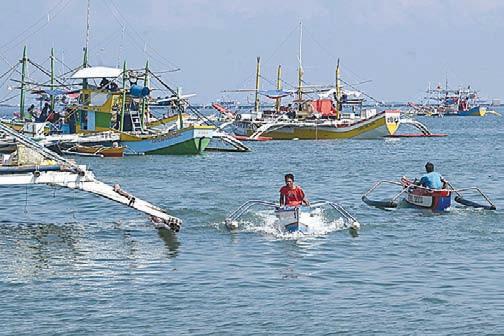
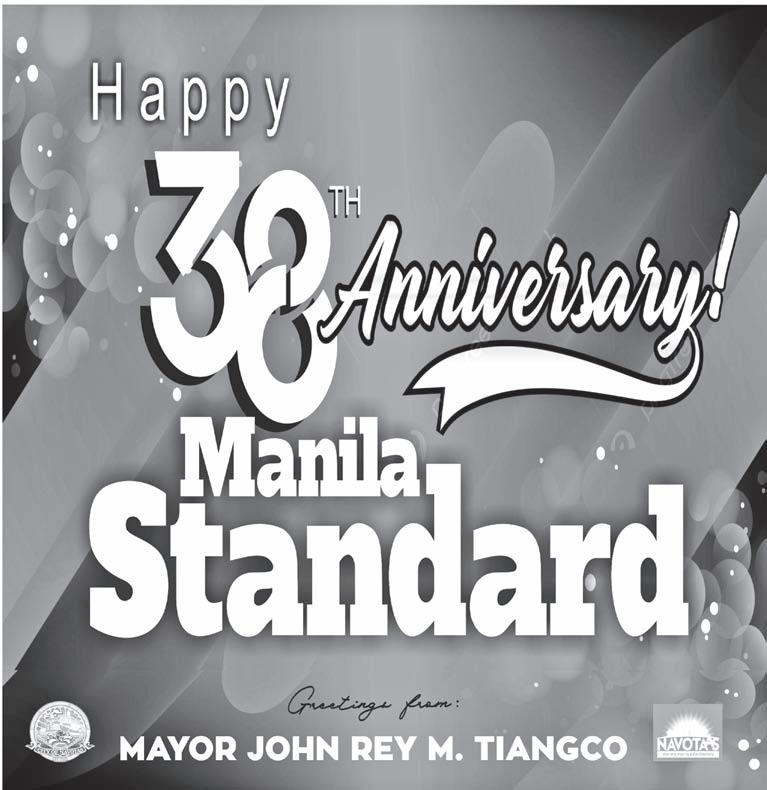
By Angelica Villanueva
THE climate crisis may seem overwhelming, but living sustainably doesn’t have to be complicated. Simple, everyday adjustments can significantly benefit our planet and enhance our quality of life. You don’t need to completely change your way of living—just a few minor modifications can lead to meaningful change.
Rethink, Reduce, Reuse, Recycle
You’ve probably heard the classic mantra of sustainability, but it’s time to rethink it. Before buying something new, ask yourself: Do I really need this? Borrowing, upcycling, and choosing secondhand items not only cut down on waste but also save money.
Recycling is great—but only when done right. Many people unknowingly contaminate recyclables, making them unusable. Learn your local recycling rules to ensure that your efforts aren’t wasted. Little changes, like rinsing out containers before tossing them in the bin, can go a long way.
Shop and eat sustainably
What we eat has a huge impact on the planet. Choosing locally sourced, organic produce supports sustainable farming and reduces


the emissions from longdistance food transportation.
Want an easy way to make a difference? Try cutting back on meat. Even one plant-based meal a week can reduce your carbon footprint. Plus, there are plenty of delicious, meatfree recipes to explore!
When shopping, support brands that prioritize sustainability— look for minimal packaging, ethical sourcing, and fair labor practices. Bringing reusable bags and opting for long-lasting products over disposable ones also helps reduce waste.
Save energy at home
Your home is a great place to start saving energy.
Switch to LED light bulbs, unplug devices when not in use, and use a smart thermostat to cut down on electricity costs while staying comfortable.
Water conservation is just as important. Fixing leaks, using water-efficient appliances, and collecting rainwater for gardening can help save gallons of water each year without much effort.
Going green on the go Transportation is one of the biggest contributors to pollution, but there are plenty of ways to travel smarter. Walking, biking, carpooling, or using public transport can cut emissions while saving money. Love to travel? Choose eco-friendly accommodations, bring reusable travel essentials, and opt for carbonoffset flights to reduce your environmental impact. Small steps, big changes
They say that a little goes a long way. Sustainable living isn’t about being perfect— it’s about progress. The more we embrace small, eco-friendly habits, the bigger the collective impact. By making mindful choices, we can inspire others and create a greener, healthier world for generations to come. Ready to make a difference? Start the shift today!
The Philippines can champion the establishment of clear international standards for environmental protection in contested maritime areas.
Ludwig
Federigan, Director at Climate Tracker Asia, Inc.
Military camps, assets and even its personnel have been involved in different initiatives for the environment.
The Philippine Army for instance, used 12 e-vehicles to ferry its personnel and even civilians to the different locations inside Fort Bonifacio in Taguig City.
The Army main headquarters also utilized three solar lamp posts to promote energy conservation and consumption.
“Also, no vehicles around the headquarters complex to promote healthy walking and zero carbon emission. We have also constructed solar powered water refilling stations and laundry.” Army Spokesperson Col Louie Dema-ala told Manila Standard. To promote environmental
sustainability, prevent soil erosion, enhance biodiversity, and strengthen the area’s ecological resilience, a total of 1,000 bamboo seedlings were also planted by Army’s 2nd Infantry “Jungle Fighter” Division on January 30 at the San Andres Military Reservation in Tanay, Rizal
For its part, the Philippine Air Force also conducted various tree planting projects across its bases and partner communities, with over a hundred thousand trees planted since 2018, PAF spokesperson Col. Ma. Consuelo Castillo said.
Castillo said PAF air assets are also usually tapped by other government agencies to monitor forests and sea conditions.
“We also use our aircraft for cloud
seeding activities to help farmers grow their crops during El Nino, and produce rain to help prevent or suppress forest fires. Our helicopters, equipped with heli-buckets have also been called repeatedly to help in fire suppression of various forest fires and support other disaster response efforts for communities affected by heavy rains and typhoons.”
The Philippine Navy, on the other hand, inked an agreement with private organizations, including the Advocates Capable for Environment to Restructure and Sustainability Inc. (ACERS Inc.), to raise awareness on climate change as well as support humanitarian assistance and disaster response.
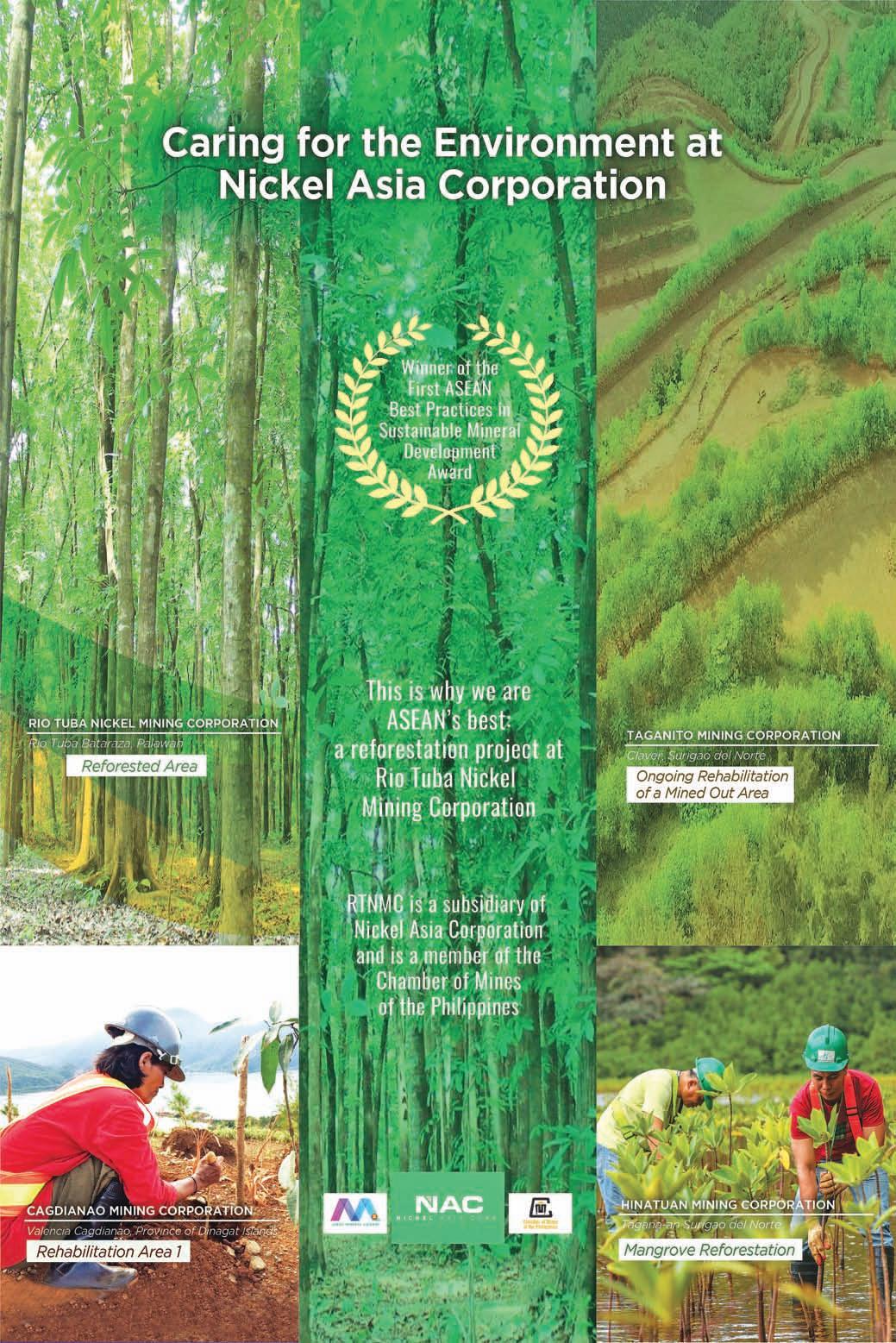


By Joel E. Zurbano
THE Metropolitan Manila Development Authority aims to enhance its zero waste campaign by implementing holistic strategies to promote sustainable waste management in the metropolis.
“With the execution of solid waste management-related interventions that the MMDA is currently pursuing in cooperation with local government units and the private sector, we will be able to achieve a cleaner Metro Manila in the shortest possible time,” said MMDA chairman Don Artes.
MMDA General Manager Procopio Lipana said the agency has long advocated for a cleaner Metro Manila by promoting waste reduction practices.
“To reach our targets, we hope that all stakeholders will work together to create a unified and efficient system, establish partnerships, and collaborate with businesses to identify and implement waste diversion strategies with our recyclers,” Lipana said.
“Only then will we be able to reduce waste volume and increase recycling, transforming waste into valuable resources until we reach net zero,” he added.
According to a 2023 Waste Analysis and Characterization study conducted by the MMDA in Metro Manila, nearly 21.44 percent of household waste can be recycled.

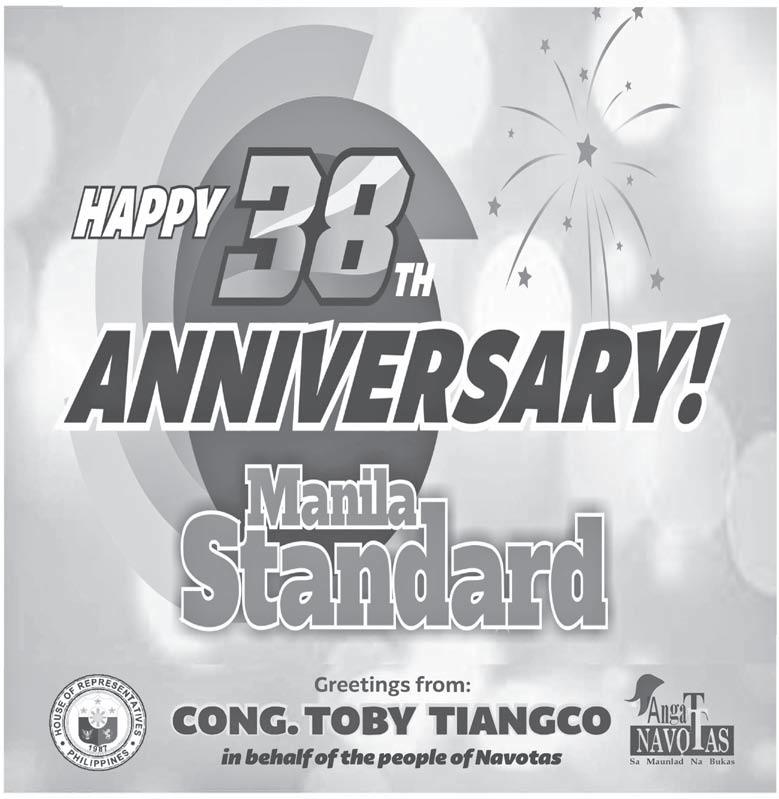
Additionally, a report from the Department of Environment and Natural Resources - Environmental Management Bureau estimates that 85 percent of generated waste can be composted.
“We cannot ignore the urgent need to address these types of waste. If left unattended, they will continue to degrade our environment, pollute our waterways, contribute to increasing flooding, and hinder economic growth, ultimately impacting our economy and public health,” said Artes.
The MMDA held its first-ever Road to Zero Waste Summit in November of last year, with the goal of promoting and demonstrating practices that support a more sustainable and circular economy, while addressing pressing issues related to solid waste management in the metropolis.
Key features of the summit included forums led by reputable speakers from various sectors and advocacy groups, with discussions focused on both community and metro-wide approaches. Panel discussions and sessions facilitated network mapping with an interactive design to educate participants about proper waste segregation and currently mapped waste diversion points to recyclers in Metro Manila, promoting sustainability. Campaigns highlighted the importance of proper segregation and resource value, along with alternative methods for waste handling.
On January 24, the agency also held its Road to Zero Waste Expo at the MMDA Motorcycle Riding Academy in Pasig City.
The expo, themed “Clean Metro Manila,” aims to expand its impact by engaging a broader range of communities and strengthening waste management systems.
Organized by the MMDA Solid Waste Management Office, this initiative seeks to enhance public awareness and significantly increase waste diversion rates through a series of impactful activities aligned with the 10-Year Road to Zero Waste Program.

THE Philippines is taking significant strides in addressing society’s most pressing issues by embracing the Sustainable Development Goals (SDGs) and pursuing climate finance initiatives. The nation’s commitment is evident in its national development plans, active participation in global climate summits and innovative financial mechanisms.
SDGs in national strategy
The Philippines has integrated the 17 SDGs into its economic blueprint, recognizing their crucial role in ending poverty, protecting the environment and climate, and ensuring peace and prosperity for all.
The UN is working closely with the Philippines to achieve these goals, aligning its efforts with the country’s development priorities. The UN’s 2024-2028 Sustainable Development Cooperation Framework complements the Philippine Development Plan (PDP) 2023-2028, which aims for deep economic and social transformation, reinvigorating job creation and accelerating poverty reduction.
Climate finance
At the recent COP29 in Baku, Azerbaijan, Finance Secretary Ralph Recto showcased the Philippines’ climate finance actions. He cited President Marcos Jr.’s leadership
and commitment to achieving both rapid economic growth and climate resilience, a goal central to the PDP.
Recto highlighted the Department of Finance’s (DOF) leading role in balancing economic development and climate action, emphasizing their harmonious relationship when properly contextualized.
The DOF has refined the MediumTerm Fiscal Program to support sustainable economic growth and fiscal discipline, enabling investments in green infrastructure, local adaptation projects, climate education, green jobs, and poverty reduction. The National Adaptation Plan (NAP) and Nationally Determined Contribution Implementation Plan (NDCIP) further guide the country’s climate and economic objectives.
Innovative mechanisms
The Philippines has established several innovative financial mechanisms to support its climate



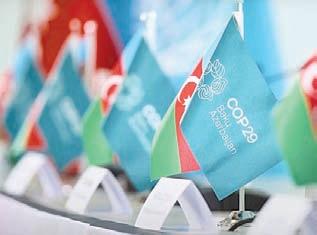
goals. The People’s Survival Fund, chaired by Recto, channels resources to locally tailored, community-led climate adaptation projects. The Bureau of the Treasury’s National Indemnity Insurance Program strengthens disaster preparedness and response by protecting national assets. The Philippines is also the first country to sign the World Bank’s Rapid Response Option (RRO), enabling quicker access to resources during crises.
The DOF and the Climate Change Commission co-chair the InterAgency Task Force on Sustainable Finance (Green Force) to accelerate the development of a sustainable
finance ecosystem and attract green investments. The country is also a pioneer in requiring ESG standards and championing gender inclusivity across all Public-Private Partnerships (PPPs).
Public-private partnership
Both the government and the private sector are actively issuing sustainability bonds to finance green and social projects, aligning with the Philippines’ commitment to the SDGs through its Sustainable Finance Framework. The country’s successful bid to host the Loss and Damage Fund Board further strengthens its position in facilitating climate finance access for the Asia-Pacific region.




The UNDP, through the Climate Finance Network and the Accelerating Green and Climate Finance Project, is collaborating with the DOF to develop a comprehensive climate finance strategy for the Philippines. The strategy aims to mobilize resources for climate action projects, consolidate funding, align public spending, and encourage private sector investment and innovation. It builds upon existing funding opportunities from the NAP and the NDCIP.
The Green Force is instrumental in mobilizing both public and private sectors for climate finance initiatives.
The DOF emphasizes digitalization, sustainability, and diversification in its policies, aiming to create a foundation for both short-term wins and long-term viability for businesses. The Philippines’ increasing leadership in international climate resilience and recovery initiatives, exemplified by hosting the Loss and Damage Fund Board, underscores its commitment to a sustainable future. The country recognizes that a climate-proof nation requires continuous effort and is eager to learn from global best practices to integrate climate action and poverty eradication effectively.






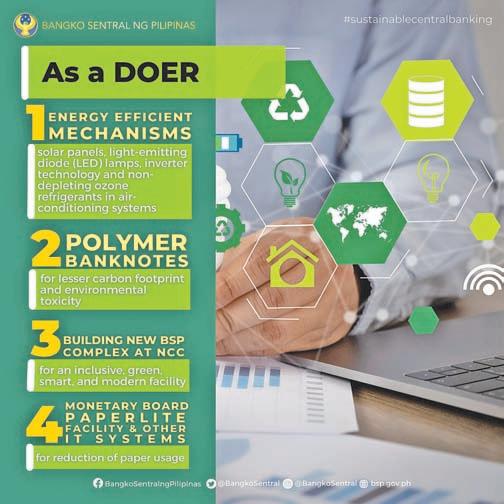
THE Bangko Sentral ng Pilipinas (BSP) said it is committed to becoming an internationally-recognized central bank at the forefront of green and sustainable policies and practices. Driven by its core mandates of price and financial stability, the BSP has embraced Sustainable Central Banking, positioning itself as an enabler, mobilizer, and active participant in promoting sustainability within the Philippine financial system.
Recognizing the urgency of addressing climate change and social inequality, the BSP integrated sustainable finance into its core operations. Sustainable finance, defined as “any form of financial product or service which integrates environmental, social and governance criteria into business decisions that support economic growth,” paves the way for long-term, sustainable economic projects.
A significant milestone in this journey is the 2024 approval of the Philippines’ Sustainable Finance Taxonomy Guidelines (SFTG) for banks by the BSP’s Monetary Board. The SFTG is designed to direct, accelerate, and increase capital flows toward economic activities that demonstrably promote sustainability.
Utilizing a clear “traffic light system,” the SFTG classifies bank activities: “Green” for activities aligned with the taxonomy, “Amber” for partially aligned activities, and “Red” for non-aligned activities. The initial version focuses on climate change mitigation and adaptation, with future iterations planned to incorporate biodiversity and the circular economy. Notably, the taxonomy offers a simplified approach for assessing the economic activities of micro, small, and medium enterprises (MSMEs).
“The issuance of a taxonomy is a crucial step in our sustainability journey,” said BSP Governor and Monetary Board chairman Eli Remolona Jr. “It provides high-level guidance in determining the greenness of an investment. But this is just the first step to what I expect will be a long iterative process of calibrating the document to fully capture the conditions of the Philippine economy.”
Beyond financial frameworks, the BSP’s commitment to sustainability is also evident in its adoption of polymer banknotes. These notes incorporate advanced security features, including a flora clear window, vertical clear window, embossed mirrored denomination, and iridescent figure, enhancing security and reducing counterfeiting risks.
A 2023 study commissioned by the BSP and conducted by De La Salle University’s Center for Engineering and Sustainable Development Research revealed that the 1,000-piso polymer banknote has a 38.36 percent lower global warming potential (GWP) compared to its paper counterpart. This reduced GWP is largely attributed to the extended lifespan of polymer banknotes, which minimizes resource consumption (such as electricity) throughout their lifecycle. These findings align with research conducted by other central banks, including the Bank of England, Bank of Canada and Banco de Mexico.
The smooth, non-absorbent surfaces of polymer banknotes make them more resistant to damage and dirt from water, oil, and other substances. They can also be sanitized with less risk of damage, a finding corroborated by the Department of Health following an evidence review that included data gathered during the COVID-19 pandemic.
BSP research indicates that polymer banknotes have a lifespan of up to 7.5 years, significantly longer than the 1.5year lifespan of paper banknotes. Similar results have been reported in other countries, with polymer notes lasting 4.8 times longer in New Zealand and 2.5 times longer in Canada.
The BSP also reports a lower incidence of worn-out polymer banknotes compared to paper banknotes. From 2022 to November 2024, only 0.08% (689,571 pieces) of the issued 1,000-piso polymer banknotes were returned as worn-out or damaged, resulting in significant cost savings on replacements.
More than 40 countries worldwide utilize polymer banknotes, underscoring the growing global trend toward sustainable currency practices. Through its multifaceted approach, encompassing financial regulations, technological innovation and a long-term vision, the BSP is paving the way for a more sustainable finance and a brighter future for the Philippines.

THE Department of Transportation (DOTr) is driving towards a greener future for Philippine transportation, championing projects and partnerships that prioritize low-carbon urban transit. This commitment aligns with the Paris Agreement and positions the Philippines as a potential leader in sustainable mobility within Asia.
“This harmonization of transport projects is crucial for shaping a more sustainable future and creating greener cities that are safe, commuter/pedestrian-friendly, and accessible for all,” said DOTr Undersecretary Jesus Ortega.
The DOTr recognizes Asia’s leading role in the global shift towards sustainable transport, acknowledging the region’s progress in areas like curbing fossil fuel subsidies, developing UN Sustainable Development Goal (SDG)compliant infrastructure, and spearheading the electric vehicle revolution. “These position Asia at the forefront of the global shift towards sustainable transport,” said Undersecretary Timothy John Batan. “It is our responsibility to initiate change, and not just respond and react to change.” Batan highlighted the Philippines’ vulnerability to climate change as a key motivator for embracing green transportation

solutions. Flagship projects like the P873.62billion North-South Commuter Railway and the P488.48-billion Metro Manila Subway Project are poised to revolutionize the country’s transit landscape.
“The transport sector is seen to play a critical role in sustainable development and holds great potential to increase the region’s climate ambition further,” Batan said. Beyond rail, the DOTr is transforming road
public transport through initiatives like the Public Transport Modernization Program, EDSA Greenways Project, EDSA Busway, Cebu Bus Rapid Transit, Davao Public Transport Modernization Project, and Taguig City Integrated Terminal Exchange.
The P8.5-billion EDSA Greenways Project, with support from the Asian Development Bank, will create five kilometers of elevated pedestrian walkways near MRT-3 stations. Bus rapid transit systems, inspired by the EDSA Busway, are also being prioritized in Metro Manila, Cebu, and Davao.
The DOTr is developing a comprehensive roadmap for transitioning public transport to electric vehicles. “If our road public transport goes electric, we are on our way to sustainable green transport,” Ortega said. Executive Order 12, issued by the President, is designed to stimulate the electric vehicle market, support the adoption of emerging technologies, reduce reliance on fossil fuels, and lower gas emissions.
Other climate-focused initiatives include electric trains, sustainable aviation fuel (SAF), crew training on methanol use for sea vessels, solar panels for airport terminals, and hybrid ferry boats for the Pasig River. Incentives for transport cooperatives adopting electric vehicles are also being explored.
“As a nation that is most susceptible to the effects of climate change, growing pollution, and loss of nature and biodiversity, the Philippine transport sector reaffirms its determination to cooperate for the implementation of transformational changes within our country,” Batan said.
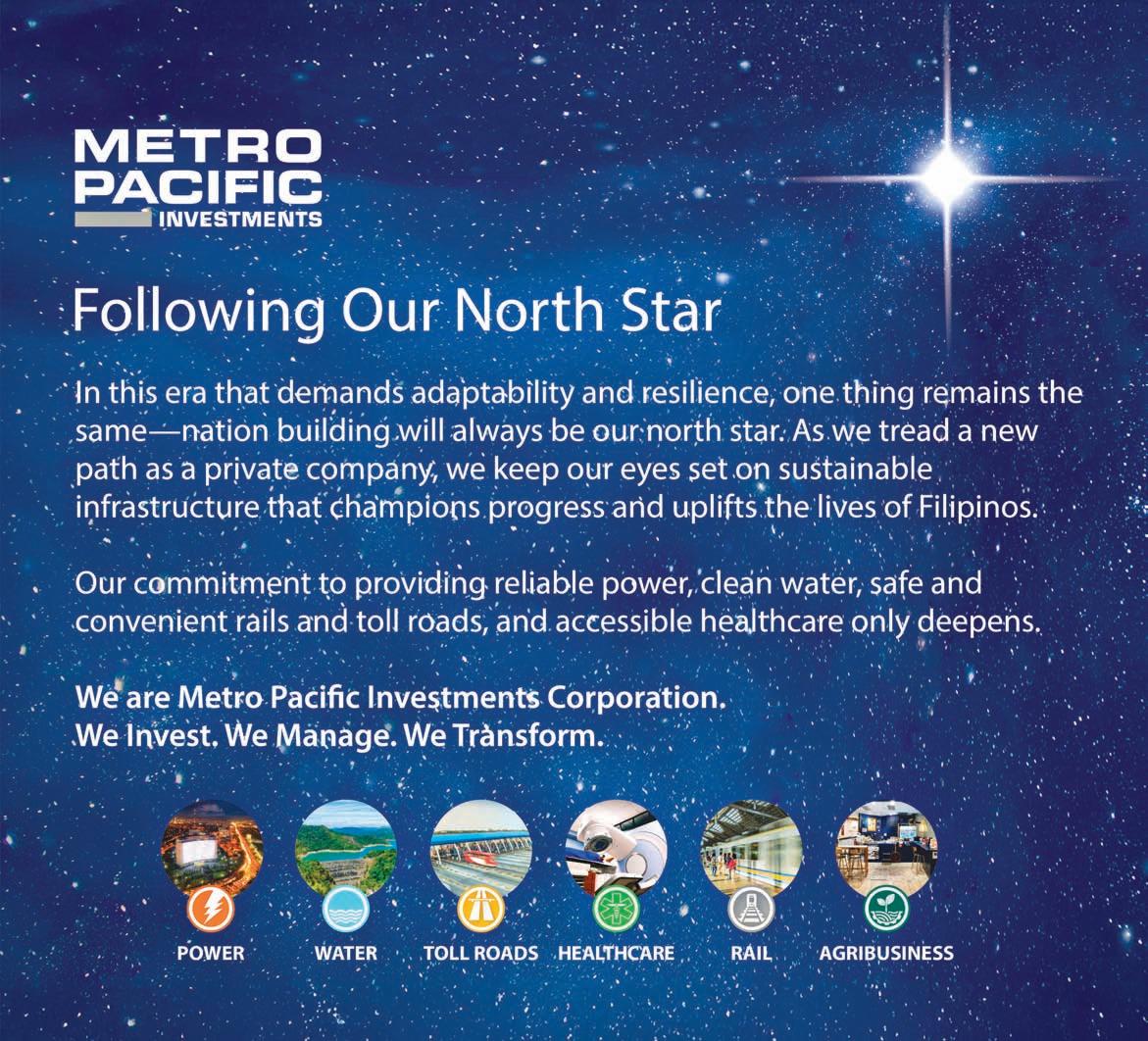

THE Securities and Exchange Commission (SEC) is accelerating its push for sustainable finance in the Philippines, strengthening its commitment through a new partnership and enhanced reporting requirements for publicly listed companies.
It recently teamed up with the International Finance Corp. (IFC) to bolster the 30by30 Zero Philippines Program—an ambitious initiative aiming to increase climate-related lending by financial institutions to 30 percent of their total portfolio, with near-zero coal exposure, by 2030. This collaboration, formalized in an agreement, will involve capacitybuilding initiatives for thematic bond issuers, investors and domestic external reviewers. The SEC and IFC will also conduct a stocktaking survey of the Philippine Thematic Capital Market to identify further opportunities for collaboration.
SEC commissioner McJill Bryant Fernandez noted the importance of the partnership in addressing the Philippines’ urgent climate challenges.
“The Philippines faces the immense challenge of mitigating climate change while ensuring inclusive and sustainable economic growth,” Fernandez said.
“Through this partnership, we aim to channel long-term funding into climate-focused initiatives that
prioritize both people and the planet,” he said.
The 30by30 Zero Philippines Program, developed by the IFC and the World Bank with funding from the German government’s International Climate Initiative, aims to empower financial institutions as aggregators of climate financing.
It encourages the integration of green finance strategies into investment plans to mitigate climate risks and reduce greenhouse gas emissions.
IFC regional manager for East Asia and the Pacific Christina Ongoma, expressed gratitude for the SEC’s support and collaboration.
“We are grateful for our partnership with the SEC and are delighted to formalize our collaboration,” Ongoma said.
“Through this, we will continue to jointly host dedicated technical workshops and training sessions to further enhance the awareness and capacity of the capital market players regarding climate thematic instruments and opportunities,” she said.
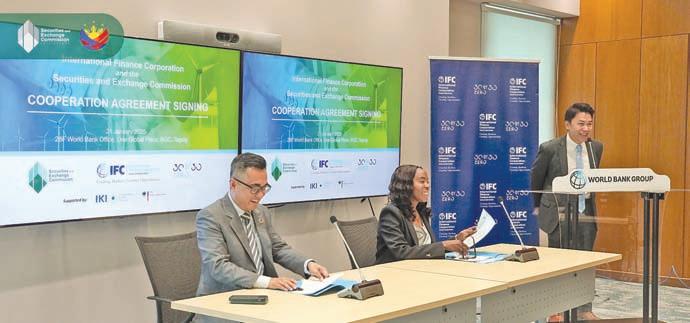
Beyond promoting sustainable finance, the SEC is also raising the bar for sustainability reporting among publicly-listed companies.
Revised guidelines, set to be released this year, will be implemented gradually, with staggered compliance requirements across different tiers of listed companies to ensure a smooth transition. While 2024 sustainability reports due this year can still follow the 2019 rules, which employ a “comply or explain” approach, more
comprehensive reporting is on the horizon.
The SEC has seen consistently high compliance rates for sustainability reporting since its introduction in 2019, reaching 96 percent in 2023.
The new guidelines, outlined in a draft memorandum circular released last October, will require listed companies to submit reports in both narrative and standardized form formats.
To further streamline the process,
the SEC is developing a web-based application in partnership with climate data and analytics software firm Komunidad Global Services & Operations Philippines Inc.
“The customized web application will streamline the data collection, verification, management and analysis of sustainability data, improving the monitoring capabilities of the commission on sustainability reporting compliance of publicly listed companies,” the SEC said.
THE Bank of the Philippine Islands (BPI) has been recognized by the International Finance Corporation’s (IFC) Climate Assessment for Financial Institutions (CAFI) for its exceptional commitment to climate action and efforts to mitigate climate change.
According to IFC, BPI achieved the “Highest Estimated Greenhouse Gas Emissions Mitigated” in the East Asia and Pacific region, with an impressive reduction of 1,754 thousand tCO2e/year. This marks the first time a Philippine financial institution has received such recognition.
“Receiving this recognition from IFC is a testament to BPI’s unwavering commitment to sustainable finance and our dedication to mitigating climate change,” said TG Limcaoco, President and CEO of BPI. “We are proud to continue to fund projects that deliver measurable environmental benefits for the communities we serve. This recognition highlights BPI’s critical role in financing projects that contribute to a more sustainable and low-carbon future for the Philippines.”
In 2023, BPI secured a $250 million green bond investment from IFC, a member of the World Bank Group. This landmark deal represented the largest green bond transaction IFC has ever made with a financial institution in the Philippines and underscores the Bank’s leadership in driving sustainable finance in the country.
“We are thrilled to present this award to BPI, in recognition of its unwavering commitment to promote investments that will help the country achieve its climate goals,” said Arnaud Dupoizat, IFC Financial Institutions Group Manager for East Asia Pacific. “We hope to continue working together to further deepen sustainable capital markets and accelerate the transition to a low-carbon economy.”
Building a Greener Future Together
The green bond investment is aligned with IFC’s 30 by 30 Zero Program, which aims to mobilize private financing for climate-related projects in the Philippines. The program’s goal is to

increase climate-related lending to 30% of total financial institution portfolios by 2030 while achieving near-zero coal exposure.
The green bond proceeds have been used to finance eligible green projects in the Philippines, such as renewable energy, with a focus on reducing greenhouse gas emissions and improving climate resilience. The majority of the proceeds have supported local projects. IFC also continues to help BPI build its capacity to assess the eligibility and impact of its climate projects, strengthening its role as a leader in sustainable finance.
A Vital Response to Climate Change
The Philippines is one of the most climatevulnerable countries in the world, with about three-quarters of its population exposed to the impacts of natural hazards. According to the
World Bank’s Country Climate Development Report, the economic damage caused by climate change in the Philippines could reach up to 7.6% of GDP by 2030. Given these risks, the BPI-IFC partnership plays a pivotal role in advancing climate-resilient infrastructure, renewable energy projects, and other initiatives aimed at mitigating the impacts of climate change.
Growing
The Philippines’ green bond market has grown significantly in recent years. Since the first green bond was issued in 2016, there have been 28 sustainability bond issuances totaling more than US$10 billion, according to the Philippines Securities and Exchange Commission. This expansion of sustainable finance is crucial for supporting the Philippines’ transition to a low-carbon, climate-resilient economy. In addition to
facilitating bond issuances, IFC plans to engage with regulators and conduct training sessions for potential issuers to strengthen the overall market for thematic bonds in the Philippines.
Looking Ahead
The partnership between BPI and IFC sets a powerful example for other financial institutions in the Philippines and the region. BPI remains committed to supporting the country’s climate goals through innovative finance solutions and is poised to continue leading the charge toward a more sustainable future.
“We believe in the power of partnerships to drive real change,” Limcaoco added.
“With the BPI-IFC partnership, we are not just financing projects — we are building a better, more sustainable future for the Philippines.”

By Othel V. Campos
AGRICULTURE,
the backbone of the nation’s food security, is facing a double whammy: it’s the biggest victim of climate changerelated disasters, and a contributor to the very problem it suffers from.
A recent report by the Philippine Institute for Development Studies (PIDS) paints a stark picture of the sector’s vulnerability and the urgent need for adaptive and mitigation measures.
The PIDS study reveals that agriculture now accounts for a staggering 60 percent of the country’s disaster-related damages. From 2012 to 2022, adverse weather and climate events cost the sector P44 billion annually. With projections indicating an increase in catastrophic natural calamities and worsening climate-related disasters, the situation is only expected to intensify.
“Extreme weather events, such as super typhoons, are expected to become more frequent and intense, affecting new locations and occurring at different times due to climate change,” the report warns.

“This will result in more widespread and severe damages as stronger typhoons hit the country with greater regularity,” it says.
Rising temperatures and unpredictable rainfall patterns are also on the horizon, with significant regional variations expected by 2050.
The effects are already being felt.
Water availability, crop production, livestock, and fisheries are all impacted.
Farmers face delayed harvests, lower yields, poorer quality produce, increased pests and diseases, and livestock deaths, leading to reduced farm income. Fisheries, too, are at risk, with rising temperatures
potentially slashing productivity by up to 2°C by 2050.
While the Philippines contributes less than 1 percent of global greenhouse gas (GHG) emissions, it ranks as the most vulnerable country in the 2024 climate risk index due to its exposure to intense tropical cyclones and rising sea levels. Ironically, despite its small global share, the agricultural sector contributes 23 percent of the country’s GHG emissions, primarily from rice cultivation, livestock digestion, and waste management.
2-pronged approach
The PIDS report calls for a two-pronged approach: urgent implementation of both adaptive
and mitigation measures to boost the sector’s resilience, sustainability, and productivity. Sustainable agriculture, the report argues, is crucial for balancing economic growth and environmental sustainability.
The sector must adopt practices that increase productivity while minimizing its carbon footprint.
The study suggests several costeffective mitigation technologies, including alternate wetting and drying for rice paddies to reduce methane emissions, biodigesters for better livestock manure management, and precision agriculture techniques to optimize resource use and minimize waste.
Climate adaptation measures, while not new, have become even more critical. These include ensuring the long-term sustainability of crops, livestock, and fisheries production.
The report emphasizes that the cost of inaction far outweighs the cost of proactive intervention, as climate change threatens not only agricultural production but also food security and livelihoods.
Improved GHG emissions estimates across sectors are also crucial for better-targeted policies and more efficient resource allocation for climate adaptation and mitigation.
The report further advocates for the inclusion of agriculture in the Philippines’ Nationally Determined Contributions (NDC) under the Paris Agreement, focusing on low-cost, long-term sustainable technologies that maintain the sector’s competitiveness and food security.
“Countries like the Philippines, which face both climate-related and non-climate disasters, must prioritize integrated strategies that combine adaptation, mitigation, and sustainability for a more cost-efficient and effective climate response,” the report says.
“Decision-makers must recognize that while sustainability measures may have high initial costs, they are crucial for building resilience and securing long-term climate and disaster preparedness,” it says.

largest marine protected area in the Philippines, covering 534,589 hectares.
“When we volunteered for this Scubasurero dive, our assumption was that we’d be collecting trash underwater. We thought the columns of the jetty would be entangled with a lot of trash. But when we went down, it was the exact opposite. Instead of trash, we found a thriving ecosystem instead,” said Roxie Diaz, diver and marine biologist.
“During the dive, the reef was pretty clean, and in the rock and rubble area, a lot of new coral growth was observed. We saw several fish species too,” added Agnes Sabonsolin-Bautista, also a diver and marine biologist. This was verified by a Marine Biodiversity Assessment Report by environmental firm Ridge to Reef, which found 56 species of fishes residing in coral reefs within the power plant’s vicinity. It also recorded six seagrass species and 28 genera of phytoplankton in the area, as well as 15 species of macroinvertebrates. These results and observations reflect Therma Visayas’ regular monitoring of the marine biodiversity within and near its site of operations, complying with the provisions of its Environmental Compliance Certificate and other environmental plans to protect and conserve the coastal area and the waters. Therma Visayas also holds regular coastal clean-up drives along Toledo’s shores together with the local community, with over 9,300 kilograms of trash collected in foreshore areas since 2022.
“This shows how Therma Visayas is a partner when it comes to resource management, protection, and preservation in the area where they operate. We see how they take care of the sites where their structures are, as well the fulfillment of their social responsibilities to the community,” Diaz said.
“The power plant has a coastal resource management program, which includes our

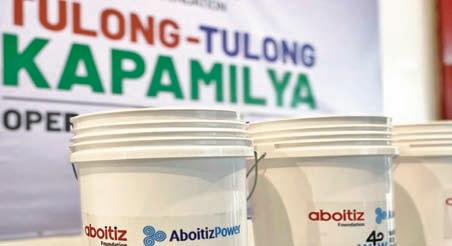
Generation companies Therma South Inc. and Therma Visayas Inc. have built carbon sinks in Davao del Sur and Toledo City, Cebu, respectively, planting one million trees each within their host communities. A carbon sink is anything that absorbs more carbon than it releases, helping lower the amount of carbon dioxide from the atmosphere.
Therma South, Inc. planted a variety of endemic, fruit-bearing, and high-value trees in the Marilog district, including areas
A Therma Visayas team member participates in a tree planting activity inside the power plant. information, education, and communication campaign for our host community regarding solid waste management and policies on the Strait Protected Seascape,” said Therma Visayas Environmental Supervisor Emalyn Sevilla. The Scubasurero project is being managed closely with the Department of Environment and Natural Resources, local government offices, Bantay Dagat, and the Philippine Coast Guard. Composed of marine biologists, Therma Visayas team members, and volunteers, the Scubasureros have explored submerged coastal areas since 2022, observing marine ecosystems and leading underwater clean-up efforts. Between 2017 to 2023, AboitizPower contributed to SDG 14 (Life Below Water) through 246 coastal and river cleanup activities, resulting in 162,847 kilograms of waste collected. Carbon sink initiatives From 2017 to 2023, AboitizPower also planted over 2.5 million trees in 6,127 hectares. In 2024, AboitizPower’s business units across the country rode on this momentum, working with local communities and stakeholders to further scale its carbon sequestration activities, while also bringing about livelihood and upskilling programs.


By Othel V. Campos
The Department of Trade and Industry (DTI) is doubling down on its efforts to attract renewable energy (RE) investments to the Philippines, positioning the sector as a critical driver of sustainable growth and environmental stewardship.
With approved investments for 2024 already surpassing the P1.5-trillion target and reaching an impressive P1.62 trillion, the Philippines is signaling its readiness to become a major player in the green energy landscape.
“The future of the Philippine economy is deeply intertwined with the growth of our renewable energy sector,” said DTI Secretary Ma. Cristina Roque. “As we transition to a more sustainable and inclusive future, attracting green investments will be critical to achieving our goals.”
2040 vision
Renewable energy is a central pillar of the country’s 2040 vision for economic growth. The Philippines is committed to increasing its renewable energy mix to 35 percent by 2030 and 50 percent by 2040.
“Our long-term strategy is clear—we must transition to renewable energy sources not only to combat climate change but to ensure a stable, sustainable energy future for the nation,” Roque said.
The Philippines’ abundant solar, wind and geothermal resources make it an attractive destination for green energy investments.
“With its natural resources, the Philippines is uniquely positioned to become a leader in offshore wind and solar energy,” Roque said. “This is a


key area where we are eager to collaborate with global partners, particularly the UK, who bring expertise and investment in these crucial sectors.” Green investment
The DTI is implementing a multi-pronged strategy to attract renewable energy investments, focusing on improving the business climate and offering competitive incentives. The Strategic Investment Priority Plan (SIPP) plays a crucial role, providing attractive incentives for sustainable projects, including those in renewable energy.
“The SIPP provides enhanced incentives for investments that promote sustainability and environmental protection,” Roque said. “We are committed to making the Philippines a top destination for renewable energy investments by ensuring businesses in this sector receive the support they need to thrive.”
By Alena Mae S. Flores
THE Philippines is betting on battery energy storage systems (BESS) to achieve its ambitious renewable energy (RE) targets and build a more sustainable energy future.
With goals of 35-percent RE in the generation mix by 2030 and 50 percent by 2040, the Department of Energy (DOE) sees BESS as a crucial component in integrating intermittent renewable sources like solar and wind, ensuring grid stability and reducing reliance on imported fuels.
The country anticipates nearly 3,800 megawatts (MW) of installed BESS capacity by 2033, a move that promises to transform the RE landscape. DOE data reveals 1,850 MW of committed BESS projects by 2030 and 1,951 MW of indicative projects by 2033, as of November 2024. The agency projects 330 MW of BESS capacity coming online this year alone.
“We have seen that battery electricity storage is a crucial technology for the Philippines,” the DOE said.
“With its current energy infrastructure facing challenges such as high costs and unreliable power supply, battery storage provides a reliable and cost-effective solution. …with the right support and investment, battery electricity storage can help transform the energy landscape of the Philippines and provide a sustainable future for generations to come,” it said.
The DOE formalized its commitment to BESS by issuing Department Circular No. 2023-04-0008 in 2023, establishing the energy storage system policy for the electric power industry. The circular defines BESS as systems capable of storing electricity electronically, enabling both charging and discharging.
Investor confidence
The rapid expansion of the RE sector has spurred significant investor interest in BESS projects.
Terra Solar Philippines Inc. (TSPI), a unit of MGEN Renewable Energy Inc. (MGreen),
recently signed a BESS supply agreement with Huawei International, Pte. Ltd. for the MTerra Solar project. This marks Huawei’s largest BESS project for an integrated solar photovoltaic (PV) and BESS facility. Meralco PowerGen, the power generation arm of Manila Electric Co., is MGreen’s parent firm.
The agreement covers the entire 4,500 megawatt-hour capacity of the MTerra Solar project, which will combine 3,500 MW peak of solar PV with 4,500 MWh of BESS. Citicore Renewable Energy Corp. (CREC) also teamed up with Chinese firm Sungrow Power Supply Co., Ltd. for BESS to support its RE projects, procuring 1.5 gigawatt-hours of BESS from Sungrow for its nationwide solar power projects.
San Miguel Corp., through its power arm SMC Global Power Holdings Corp., announced plans for 1 GW of BESS projects nationwide. Other major players, including Aboitiz Power Corp. and First Gen Corp., are also actively developing their own BESS projects.
Green energy auction
The DOE signaled its commitment to BESS by including Integrated Renewable Energy and Energy Storage System (IRESS) in the Green Energy Auction 4 this year. IRESS combines RE technology with energy storage systems (ESS). The DOE said the IRESS integrates RE sources with energy storage technologies like batteries, flywheels or pumped storage hydropower systems. This allows RE plants to optimize operations by storing excess energy during peak production and utilizing it when needed, thus reducing the burden on the grid.
The agency said that by combining RE and energy storage, IRESS enhances the stability and reliability of the energy system, ensuring a more consistent and efficient power supply. The DOE, in collaboration with development partners, is currently studying the design and economic viability of IRESS.

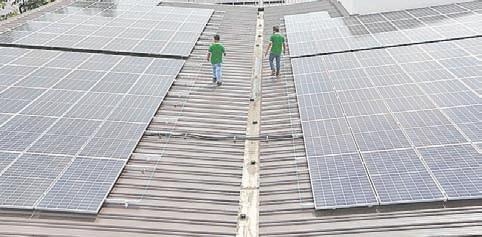
By Alena Mae S. Flores
ACROSS the Philippines, a quiet revolution is taking place on rooftops. Homes, malls and offices are increasingly adorned with solar panels, marking not just a trend, but a crucial step towards securing the nation’s energy future, driving economic development and embracing clean energy.
Solar rooftop installations are at the forefront of the Philippines’ journey toward sustainability.
“Solar energy is undeniably the cheapest source of electricity today,” said Tetchi Capellan, chairperson of the Philippine Solar and Storage Energy Alliance (PSSEA).
“Rooftop solar empowers homeowners and offers families a choice, as well as a way forward to address the rising cost of electricity in a quick and affordable manner,” she said.
Capellan said rooftop solar allows millions of homes and small businesses to actively participate in the global decarbonization effort.
Beyond cost savings, PSSEA highlights that solar rooftops increase home values and can even provide an additional revenue stream by selling excess energy back to the grid.
Cost of going solar
PSSEA’s latest market report on rooftop solar in the Philippines provides a detailed breakdown of installation costs, which can range from P150,000 to P1 million, depending on factors like
house type, roof structure, and system size.
For small, affordable homes with a monthly electricity consumption of 224 kilowatt-hours, a 2 kilowatt-peak (kWp) system, requiring five solar panels on aboui 12 square meters, would cost between P150,000 and P210,000.
Medium-cost houses, consuming around 448 kWh monthly, might need a 4-kWp system (10 panels, 17 sq.m.) costing between P300,000 and P420,000.
Larger, high-cost residences could require a 15-kWp system (38 panels, 86 sq. m.) ranging from P900,000 to P1.26 million, or even a 30-kWp system (75 panels) costing around P1.8 million.
Deciphering costs
PSSEA listed several factors influencing installation costs. System size is paramount; optimizing the system to match a household’s energy needs yields the greatest savings.
Roofing material also plays a role. Trapezoidal metal roofs are the most straightforward for solar installations, while corrugated metal roofs present more complexities and higher costs.
THE Philippines has received a significant boost in its battle against climate change, with the Asian Development Bank (ADB) approving a substantial $500-million policy-based loan.
Approved in November 2024, the loan approval underscores the ADB’s commitment to supporting the nation as it strives to build resilience against the increasing threats posed by a rapidly changing climate.
The loan will support the second subprogram of the Philippines’ Climate Change Action Program (CCAP), a crucial initiative designed to implement the country’s Nationally Determined Contribution (NDC) under the Paris Agreement.
The CCAP focuses on accelerating transformative reforms across key sectors—from agriculture and natural resources to energy and transport— steering them towards more climateresilient and low-carbon pathways.
The Philippines is particularly vulnerable to the devastating impacts of climate change. Ranked as the country with the highest disaster risk globally (World Risk Index 2022–2024), it has recently been battered by a succession of powerful typhoons, starkly illustrating this vulnerability.
The economic consequences of these climate-related disasters are potentially catastrophic, with estimates suggesting potential losses of up to 7.6% of the nation’s gross domestic product by 2030. “Climate change is exacerbating all
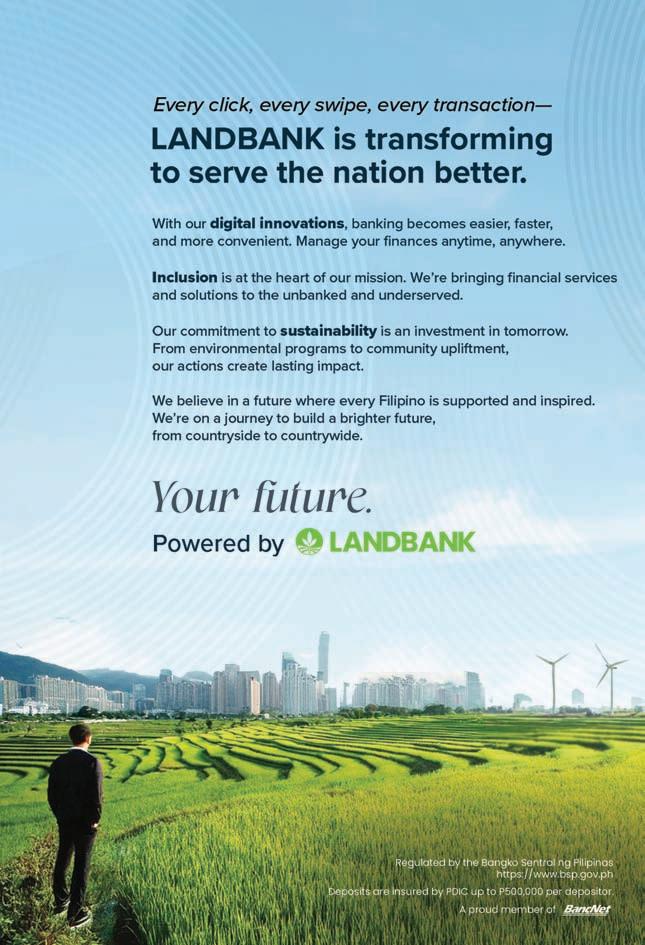
major development challenges in the Philippines,” said Pavit Ramachandran, ADB Philippines country director.
“The country’s high vulnerability impacts its economic momentum and outlook. This program is part of our commitment to help our host country avert economic damages from future climate change impact, mobilize green investment, and transform its economy,” he said.
The CCAP, initially approved in 2022, is a landmark initiative, representing ADB’s first climate policy-based loan in the Asia and Pacific region. It forms a key component of ADB’s new country partnership strategy for 2024–2029 and its country climate investment plan, which aims to mobilize $10 billion in climate finance to support the implementation of the Philippines’ NDC and National Adaptation Plan (NAP).
The Philippines’ NDC sets ambitious goals for greenhouse gas emission reduction and adaptation. Subprogram 2 is vital for achieving these ambitions, driving key reforms such as the adoption of the NDC Implementation Plan and NAP 2023–2050, increasing budget allocations for climate activities, and deploying climate technologies at both national and local levels. The program also strengthens policies and regulations designed to attract climate-related investment in crucial areas like renewable energy and energy efficiency, climateresilient agriculture, and nature-based solutions.


By Darwin G. Amojelar
PHILIPPINE telecommunication companies are aggressively embracing green initiatives, setting their sights on a 2050 net-zero emissions target and strengthening their commitment to environmental sustainability.
PLDT Inc. and Globe Telecom are leading the charge, implementing diverse strategies ranging from securing green financing to deploying renewable energy solutions across their vast networks.
PLDT, the country’s largest telecom company, has secured P5 billion in green loans to date, partially funding its fiber expansion and minimizing the carbon footprint of its network rollout.
Melissa Vergel de Dios, PLDT chief sustainability officer, earlier said that securing green loan facility showcases the company’s commitment to integrate sustainability in every facet of its operations, and underscores holistic approach to environmental stewardship and responsible business practices.
“Together with the financial community’s support, we can drive more meaningful change and collectively build a sustainable future for future generations,” she said.
PLDT and its wireless unit Smart Communications Inc. worked with First Gen Corp. to power six network facilities in Mindanao with 100-percent renewable energy. This includes the crucial PLDT Ponciano regional facility, which houses
VITRO Davao—the first data center in Davao City. This switch makes VITRO Davao the telco’s first 100-percent RE-powered data center.
The PLDT Group plans to expand its renewable energy mix, incorporating geothermal, solar, and wind sources. In May 2023, PLDT and Smart launched their RE supply partnership with First Gen, utilizing geothermal energy for network facilities in Cebu, Samar, Capiz, and Iloilo.
Prior to this partnership, the PLDT Group installed its largest solar rooftop facility in the Visayas, covering sites in Cebu, Roxas, Iloilo, and Bacolod. The Group expects to transition additional facilities in Greater Metro Manila to RE within 2024.
Beyond RE transition, PLDT and Smart are adopting green technologies and resource optimization initiatives for network sites, offices, and facilities nationwide.
Solar-powered savings
Globe Telecom has deployed hybrid solar power across 26 sites nationwide, including NCR, South Luzon and Mindanao, from 2022 to 2023. These sites include offgrid towers, traditionally reliant on diesel generators, now powered by

renewable energy with battery energy storage systems, or a combination of renewables and diesel. The technology was also tested in areas with unreliable or non-existent grid connections.
The results were impressive. Globe estimates savings of over 119,000 liters of diesel fuel and avoided electricity consumption of over 67,000 kWh, translating into P6.9 million in savings.
“Successfully implementing hybrid solar power across multiple sites represents a big leap in our efforts to decarbonize our operations,” said Joel Agustin, head of Globe network planning and engineering.
Globe’s cell sites traditionally relied on grid electricity (partially
generated from coal) and diesel generators for backup. The shift to sustainable sources became essential, especially for off-grid or unreliable grid sites, which typically relied on continuously operating generators.
Globe’s hybrid solar power solution includes a scalable Solar Mini-Grid, built within or adjacent to the facility, providing direct power to on-site equipment. It also features an Advanced Solar Hybrid solution, an intelligent off-grid power system primarily using solar energy, switching to batteries and diesel generators only when necessary.
Encouraged by the results, Globe will progressively deploy its hybrid solar power technology across its cell sites, actively pursuing green
solutions and innovations to reduce its network’s GHG and carbon footprint. Sustainability efforts
Globe’s commitment to sustainability has earned it an “AA” rating from MSCI ESG Research, recognizing its proactive management of ESG risks and dedication to sustainable practices.
“Our ESG rating reflects the collective effort of our entire organization in integrating sustainability principles in the way we do business,” said Yoly Crisanto, Globe’s chief sustainability and corporate communications officer.
“We remain dedicated to driving positive change, not only within our company but also in the communities we serve and the nation at large,” she said.
GLOBE is driving sustainability across its supply chain by empowering vendors with training, tools, and technology to align with global environmental, social, and governance (ESG) standards.
The telco leader empowers its vendors to adopt sustainability practices via capacity-building initiatives, enabling them to enhance their competitive edge while meeting evolving consumer demands and regulatory standards.
Countries worldwide, including the Philippines, have implemented mandatory sustainability reporting requirements for listed companies. With the regulatory developments, Globe seeks to help prepare its suppliers to meet evolving sustainability standards.
Through its internal Sustainability Academy, Globe equips suppliers to adopt sustainable practices and address critical challenges, including knowledge gaps, and technical capacity. Globe and givvable, a data and insights platform for supplier sustainability, recently co-organized

the webinar “Beyond Business as Usual: Building a Sustainable Future,” attended by almost 170 representatives from over 50 vendors, 81% of whom were local suppliers. Apple Evangelista, Globe’s Sustainability and Social
GLOBE recently showcased its innovative, technology-driven disaster resilience strategies and its commitment to mitigating climate risks on the sidelines of the Asia Pacific Ministerial Conference on Disaster Risk Reduction (APMCDRR) 2024.
In a timely event mounted alongside the Ayala Group, Globe outlined the company’s holistic approach to disaster risk reduction (DRR), encompassing advanced technology solutions, robust infrastructure, and community-centered response measures.
“Reliable infrastructure is crucial in ensuring reduced downtime services during disasters. Globe constructs and retrofits towers to withstand extreme weather, factoring in risks such as flooding, earthquakes, tsunamis, and volcanic eruptions. Backup power sources have also been installed to reduce network interruptions and ensure continuity,” Yoly Crisanto, Globe’s Chief Sustainability and Corporate Communications Officer.
In partnership with the National Disaster Risk Reduction and Management Council (NDRRMC), Globe plays a vital role in

Responsibility Head, highlighted strategies for carbon reduction in the telco sector. Meanwhile, Naomi Vowels, co-founder and director of Givvable, explored the use of automated tools for supplier sustainability and ESG diligence.
disseminating geo-tagged disaster alerts, as required by Republic Act 10639, or “The Free Mobile Disasters Alert Act.”
Beyond prevention, the mobile leader has established swift response mechanisms to support affected communities, including prepositioning resources like Cell site on Wheels (COW), Tower on Wheels (TOW), Cell site at Less Footprint (CALF), Genset on a Truck (GOAT), and Emergency Base Stations to maintain connectivity in disaster-affected areas.
Libreng Tawag, Libreng Charging (LTLC) stations are also deployed in disaster-hit areas to provide residents essential communication services amid power outages. Meanwhile, Globe’s telehealth provider KonsultaMD offers medical and mental health services to assist in disaster recovery.
Employee volunteers also help prepare and distribute relief supplies, reflecting Globe’s commitment to community recovery and rebuilding. Through Globe Rewards, customers can directly donate to partner organizations, providing aid for those in need.
Globe’s commitment to climate action is also
The webinar also showcased valuable insights from distinguished experts who discussed integrating sustainability into the supply chain and provided an introduction to greenhouse gas (GHG) emissions and their calculation.
The GHG accounting module resonated strongly with participants, prompting some to commit to implementing sustainability guidelines, reviewing their products and services, and sharing knowledge within their organizations.
“Sustainability requires deliberate efforts, supported by awareness, dedication, and collaboration. Our Academy enables suppliers to take meaningful steps toward achieving shared sustainability goals,” said Jerry Cabiles, Head of Globe’s Procurement and Logistics.
Using Givvable, Globe also evaluates its top 300 suppliers, selected based on expenditure, against ESG performance. givvable is an Australianbased AI powered data platform that is designed to screen and validate suppliers’ ESG practices. This effort
key to its disaster risk reduction strategy. By pursuing its net-zero ambition, the telco giant seeks to reduce the risks posed by extreme weather and other climate-related threats through climate mitigation.
On the other hand, speaking at the panel discussion on “Leveraging Digital Advancements for Early Warning Dissemination and Communication,”
Emmanuel Estrada, Globe Vice President for Regulatory Development and Strategy, highlighted the importance of a multi-channel approach for emergency communications.
He emphasized that integrating cell broadcasts with location-based SMS and various channels— such as sirens, billboards, TV, radio, mobile apps, and social media — would significantly expand audience reach. Maintaining consistency across platforms is crucial to prevent confusion and ensure that information is delivered clearly and effectively.
“In times of emergency, it is crucial that we leverage all existing and in-service technologies to send Emergency Alert Warning Messages (EAWM) to as many people as possible.
aims to create greater value and impact by maintaining supplier diligence and aligning practices with its sustainability standards. The platform also has modules that cover topics such as carbon footprint reduction, circular economy, and ethical sourcing.
“Givvable brings visibility to the ESG performance of your suppliers, enabling you to make informed choices that align with your sustainability values and business goals. By leveraging our platform, companies can foster a sustainable supply chain, mitigate risks, and contribute to a better future for all,” said Vowels.
Moving forward, Globe plans to scale its Sustainability Academy to reach more suppliers, provide advanced training modules, and deepen supplier engagement. By fostering a culture of sustainability, Globe aims to create a resilient, responsible supply chain that contributes to a sustainable future. For more information about Globe’s sustainability initiatives, visit globe.com.ph/sustainability
This means we cannot rely solely on mobile networks,” he stressed.
Estrada also shared that Globe is exploring low-earth orbit (LEO) satellite technology to ensure uninterrupted communication in areas where terrestrial networks may fail. These satellite services can extend connectivity to remote or disaster-affected areas, enhancing resilience for emergency teams.
With disaster preparedness embedded in its business model, Globe applies the principles of Resilience by Design (RD) throughout its network lifecycle, ensuring that critical infrastructure, such as satellite hubs, are positioned safely to maintain service continuity. The APMCDRR 2024 gave Globe a valuable opportunity to present its DRR accomplishments and reaffirm its commitment to protecting Filipinos through innovative technologies and sustainable practices. With over 4,000 attendees, this year’s conference emphasized accelerating DRR efforts to mitigate the effects of climate change and natural disasters across the region. To learn more about Globe, visit https://www. globe.com.ph/.

FROM pristine beaches to vibrant cultural experiences, the Philippines offers a wealth of attractions for tourists. But as the industry grows, so does the need to protect the very assets that draw visitors in.
The Department of Tourism (DOT) is championing a balanced approach, emphasizing the crucial link between tourism development and natural resource conservation.
“Our environment is the birthright of all Filipinos,” said DOT Secretary Christina Frasco, underscoring the importance of biodiversity conservation at the National Ecotourism Summit 2024.
The one-day event brought together government agencies, local government units and private tourism stakeholders to forge a unified vision for sustainable and regenerative tourism.
Beyond simply visiting destinations, the DOT encourages immersive experiences. They are promoting heritage and cultural immersion, along with meaningful interactions with local communities, hoping to cultivate a deeper appreciation for the country’s ecotourism offerings.
“We cannot protect what we don’t love,” Frasco said. The DOT hopes that by encouraging tourists to fall in love with the Philippines, they will inspire responsible travel. The goal, she said, is for tourists to “leave the places better than they found them.” This includes promoting volunteerism programs, like
coastal cleanups and underwater cleanups during diving excursions.
A significant moment at the summit was the turnover of the chairmanship of the National Ecotourism Development Council (NEDC) from the Department of Environment and Natural Resources to the DOT. This transition positions the DOT at the forefront of ecotourism policy-making in the country.
The NEDC, established by Executive Order 111, serves as the primary body for ecotourism initiatives. Comprised of department secretaries, private sector representatives, and NGO representatives, the council plays a vital role in shaping the future of sustainable tourism.
Recognizing that the longevity of tourist destinations is essential for local livelihoods, Frasco affirmed the DOT’s commitment to the stringent implementation of the National Ecotourism Strategic and Plan 2024-2028.
This outlines key strategies, including the development and marketing of ecotourism products rooted in Filipino culture and values. It also prioritizes the promotion of ecotourism and the development of climate-resilient infrastructure and mechanisms for ecotourism sites.


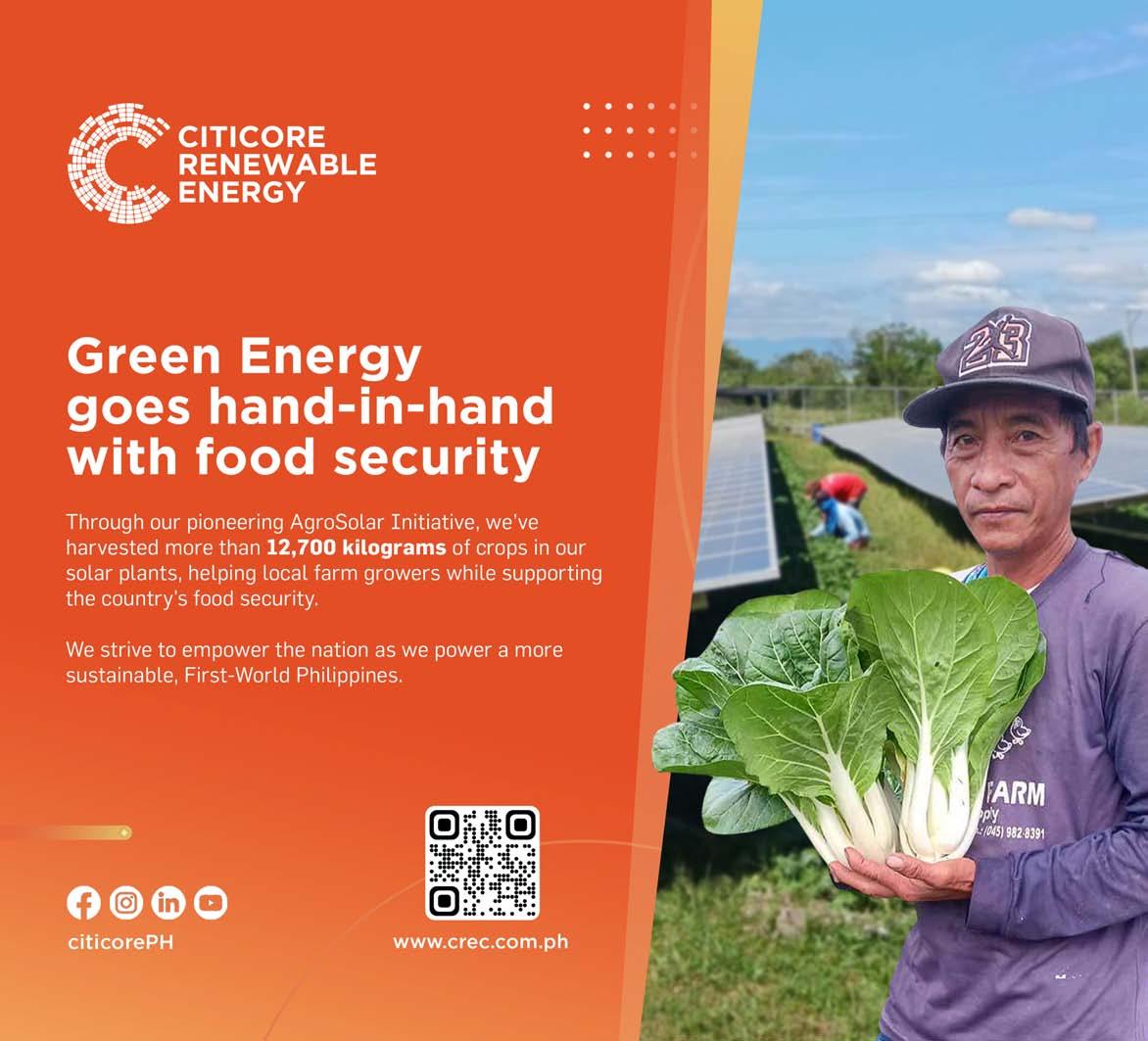

By Darwin G. Amojelar
PHILIPPINE carriers are embracing nextgeneration aircraft and innovative strategies to achieve the aviation industry’s ambitious goal of net-zero emissions by 2050.
This comes as the International Civil Aviation Organization (ICAO) projects aviation greenhouse gas emissions could soar two to four times above 2015 levels by 2050, with aviation currently contributing over 2 percent of global CO2 emissions.
Cebu Pacific is leading the charge with a capital expenditure program focused on replacing older aircraft with fuel-efficient NEO aircraft by 2028.
“Acquiring and maintaining next-generation aircraft is integral to meeting our climate goals and maintaining high-quality services,” said Alex Reyes, Cebu Pacific chief strategy officer. The airline recently welcomed its 12th A321 neo for 2024, a move that will improve network connectivity and operational efficiency.
“This latest aircraft delivery aligns with our goal of enhancing our fleet and expanding our network to better serve every Juan,” said Xander Lao, Cebu Pacific president and chief commercial officer.
“With each fuel-efficient aircraft we welcome to our

fleet, we are taking steps toward achieving our net zero goal by 2050, while continuing to open more routes and introduce new destinations for our passengers,” said Lao.
Airbus NEOs represent the latest generation of aircraft, boasting 15-percent less fuel burn per flight and reduced noise compared to their predecessors. This fuel efficiency translates directly into lower carbon emissions.
Cebu Pacific’s commitment to sustainability extends beyond its fleet. The airline recently added two new electric buses to


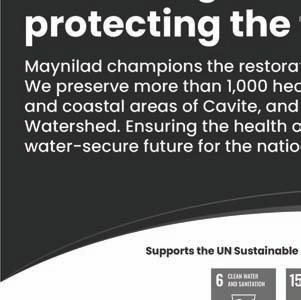
its ground operations, replacing conventional fuel-powered vehicles.
“As the aviation industry acknowledges the pressing need for sustainable operations, Cebu Pacific is expanding its decarbonization efforts beyond modernization of its aircraft,” said Reyes.
“Integrating electric buses into our ground operations is a move in this direction. Through this approach, we aim not only to reduce our carbon footprint but also to enhance the overall travel experience for our passengers,” he said.


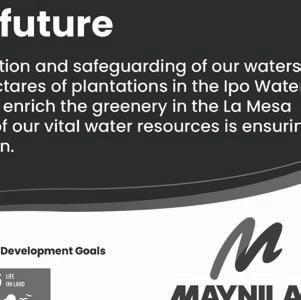
These BYD electric buses, leased from Therma One (T1) Transport, will shuttle passengers between the boarding gate and aircraft at NAIA Terminals 3 and 4. This initiative marks the beginning of Cebu Pacific’s comprehensive electric vehicle (EV) transition program. Philippine Airlines (PAL), the flag carrier, also pledged to achieve net-zero carbon emissions by 2050, aligning with international climate agreements like the Paris Agreement and the Glasgow Climate Pact. PAL is investing in
a comprehensive carbon reduction program as part of its multi-year commitment to combat climate change.
“Our Net Zero initiative comes at a crucial time for the international aviation industry, which is seeking to further lessen its environmental impact in response to the global scientific community’s clarion call against irreversible climate change,” said PAL president and chief operating officer Capt. Stanley Ng.
PAL’s holistic Net Zero goal encompasses both flight and ground operations. The airline has already transitioned to renewable energy for its major offices and is exploring the potential use of sustainable aviation fuel.
PAL continually improves operational efficiency through fuel-saving initiatives like Single Engine Taxi In (SETI) and Reduced Acceleration Altitude (RAAL), which reduce CO2 emissions while maintaining stringent safety standards.
Looking ahead, PAL plans to develop a robust Net Zero Emissions (NZE) strategy, incorporating projected emissions scenarios until 2050 using internationally recognized models and standards.
The airline aims to develop and recommend science-based targets and gender-based programs for the entire PAL community, demonstrating a comprehensive and forward-thinking approach to achieving its net-zero commitment.
By Jenniffer B. Austria
THE Securities and Exchange Commission (SEC) envisions a greener, low-carbon and sustainable economy by fostering collaboration between corporations and public and private sector stakeholders.
This commitment is underscored by the recent launch of the Sustainable Enterprise Collaboration Network (eSECnature).
eSECnature aims to connect corporations, government organizations, multilateral institutions and civil society organizations to bolster corporate participation in sustainability initiatives and accelerate the Philippines’ progress towards the UN Sustainable Development Goals (SDGs).
“Through this network, we aim to unite organizations in both the public and private sectors to collaborate in developing best practices, new ideas, and successful strategies toward our vision of a sustainable capital market and business sector,” said SEC chairperson Emilio Aquino.
Aquino emphasized the significant impact of sustainable practices on capital markets and the broader economy. “We believe that the adoption of sustainable practices will have a significant impact in improving the state of our capital markets and, more importantly, the economy. As we see more companies comply with ESG standards, we can look forward to the entry of more investments into the country that can further drive our economic growth,” he said.
The network will facilitate knowledge sharing, policy advocacy, and collaborative efforts to integrate and adopt sustainable operational practices. Key focus areas include promoting ethical and responsible business conduct, reducing carbon footprints, and supporting the government’s digitalization, zero-contact, and paperless initiatives.
The eSECnature campaign itself emphasizes digital enablement to minimize
Through this network, we aim to unite organizations in both the public and private sectors to collaborate in developing best practices, new ideas, and successful strategies toward our vision of a sustainable capital market and business sector.
SEC chairperson Emilio Aquino
the corporate sector’s environmental impact.
The SEC’s commitment to sustainability is further evidenced by recent initiatives. Last year, the SEC issued guidelines for sustainability-linked bonds, incorporating ASEAN Sustainability-linked Bond Standards. This has spurred a dramatic increase in ASEAN-labeled Green, Social and Sustainability and SustainabilityLinked (GSS+) bonds issued by Philippine companies, surging by 602.32 percent to reach P209.29 billion from January to November 2024.
The SEC also approved the country’s first blue bond offering, the proceeds of which will finance eligible blue activities such as sustainable wastewater management and marine ecosystem improvement projects. Beyond financial instruments, the SEC is also taking direct action with the launch of SECFoRest. This outlines the agency’s plan to plant over 16,000 trees across a 10-hectare area in the Angat River Watershed in Norzagaray, Bulacan, demonstrating a holistic approach to environmental sustainability.
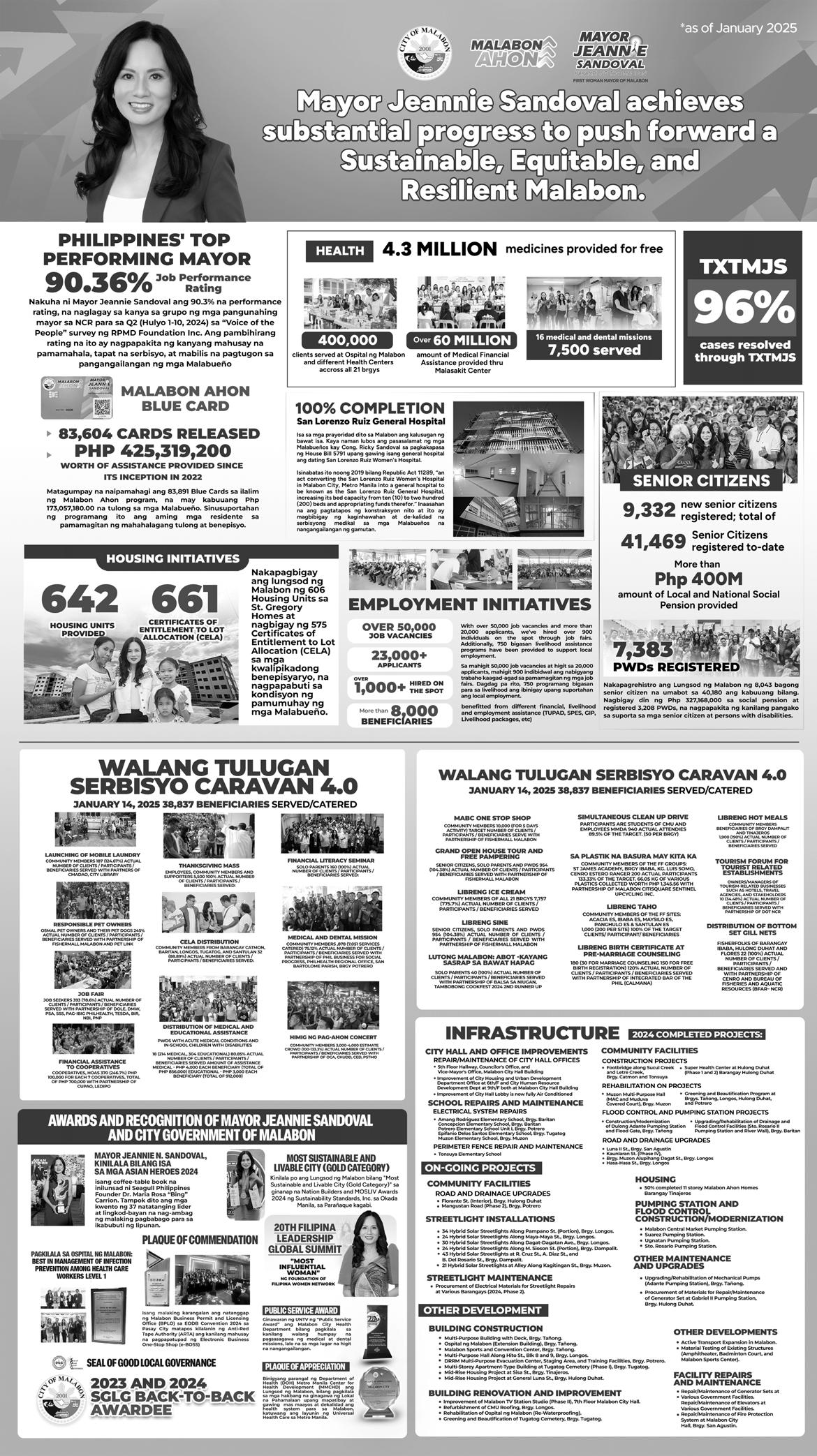

By Jenniffer B. Austria
METRO
Manila’s office landscape is poised for a green transformation. Driven by growing demand from multinational corporations and major Filipino companies, property developers are increasingly focusing on creating sustainable, healthy and environmentfriendly workspaces. A recent report by Colliers Philippines predicts this trend will significantly shape office space demand starting 2025.
Despite the current slowdown in office uptake following the departure of Philippine Online Gaming Operators (POGOs), Colliers forecasts that green, sustainable offices will dominate new office supply from 2025 to 2027. The firm estimates that about 61 percent of new office space will boast green certifications such as LEED and WELL. Key business districts like
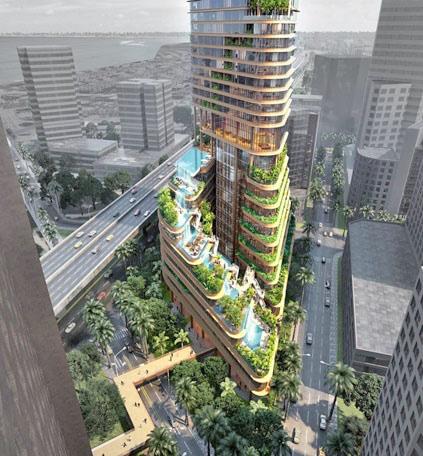
Makati, Ortigas Fringe and Quezon City will be home to the majority of these eco-friendly buildings, with projects like Innoland Altaire, Araneta Cyberpark Tower 3, SM North EDSA Towers 4 and 5, GBF Center Tower 2 and The Yuchengco Center.
These next-generation workspaces will offer a range of features designed with both employee well-being and environmental consciousness in mind. Lower density ratios, advanced curtain wall systems with thermal insulation, touchless elevator access, vertical gardens, UV disinfection in elevators and filtered air circulation systems are just some of the innovations tenants can expect.
These features aim to create healthier and more efficient environments for both traditional businesses and outsourcing companies.
Colliers’ research also highlights the growing preference for green-certified buildings among discerning occupiers. In 2024, nearly half of all office transactions in Metro Manila involved such properties, demonstrating the increasing importance of ESG (Environmental, Social, and Governance) considerations for businesses. This shift presents a clear call to action for landlords. To attract and retain tenants, Colliers advises landlords to proactively embrace green building certifications like Leadership in Energy and Environmental Design (LEED) or Building for Ecologically Responsive Design Excellence (BERDE). Highlighting a building’s green credentials, along with other amenities and value-added features, will be crucial for attracting and retaining tenants.
Colliers says the future of office buildings lies in creating spaces that are not only safer and healthier but also minimize their environmental impact. As businesses prioritize employee well-being and sustainability, green offices are set to become the new standard in Metro Manila’s commercial real estate market.


By Patricia Taculao-Deligero
OUR pockets bulge with smartphones, our homes hum with the quiet whir of laptops and tablets, and our offices glow with the light of countless monitors. We live in a world increasingly powered by technology that offers incredible convenience and connectivity.
With just a few clicks, we can talk to anyone, anywhere, and anytime, or even order items to be delivered right to our doorsteps.
The possibilities are endless with technology, especially since it continuously innovates.
However, this digital revolution comes at a cost: a mountain of electronic waste, or e-waste, is growing alarmingly.
Discarded computers, old cell phones, and broken appliances contribute to a global challenge threatening our environment and squandering valuable resources.
But the story doesn’t end there.
A new wave of innovation transforms e-waste from a problem into an opportunity, turning tech trash into treasure.
Imagine a world where old circuit boards don’t end up in landfills but become a source of precious metals like gold, silver, and copper. Picture innovative recycling facilities that can surgically dismantle complex devices, recovering every valuable component.
Forward-thinking companies and initiatives strive to turn these dreams into reality. They’re pioneering new technologies, developing sustainable recycling processes, and advocating for responsible e-waste management, offering a hopeful vision for the future. What is the status of e-waste?
The scale of the e-waste problem is staggering. The United Nations estimates that the world generates over 50 million tons of e-waste annually, projected to double by 2050. This mountain of discarded electronics contains hazardous materials like lead, mercury, and cadmium, which can leach into the soil and contaminate water sources if improperly handled. Furthermore, e-waste represents a massive loss of valuable resources. Many electronic devices contain finite, increasingly scarce precious metals. Instead of being recovered and Turn to I2






AS businesses continue to adapt to an ever-evolving digital landscape, customer experience (CX) is anticipated to play a key role in helping businesses grow and build customer loyalty in 2025. Global communications platform, Infobip sees AI continuing to play a key role in strengthening CX this year.
According to Cecile Perez Tizon, Sales Director at Infobip, “Our latest predictions categorize emerging CX trends for 2025 into three key layers—Infrastructure, Application, and Customer Experience. These trends will shape how brands interact with consumers and leverage technology for enhanced service. We are also seeing key similarities and differences when it comes to how different customer generations, from boomers to zoomers, want to engage with brands. Understanding each generation’s preferences will also help brands enhance their CX strategies and implementation.”
2025 CX Trends
Conversational AI Security
As the use of conversational AI becomes more widespread, businesses are expected to prioritize security. Conversational AI offers enormous potential, including more seamless and personalized customer journeys that boost sales and loyalty. Infobip expects companies to explore the capabilities of large action models, which allow AI to perform tasks with minimal human intervention.
Enhanced human-augmented AI practices
Businesses will increasingly adopt generative AI systems that involve human oversight before finalizing customer interactions. “Trust is the foundation of any successful customer relationship,” added Tizon. “Human oversight in AI responses bridges a critical gap, empowering organizations to ensure their messaging is accurate and relevant.”
Growth of conversational AI analytics
Real-time analytics will also emerge as a driving force in optimizing customer support and marketing strategies. “Clean, structured data is essential,” emphasizes
reused, these resources often end up in landfills, contributing to environmental degradation and resource depletion.
One of the biggest challenges in tackling the e-waste problem is the complexity of electronic devices. Modern gadgets are intricate assemblies of various materials, making it difficult and costly to dismantle and recycle them efficiently.
Traditional recycling methods often involve manual labor, which can be dangerous and inefficient.
Fortunately, thanks to innovation, companies are developing automated recycling systems that use robotics, artificial intelligence, and advanced separation techniques to break down devices into their constituent parts.
These systems can recover valuable materials with greater precision and efficiency, reducing waste and maximizing resource recovery.
Beyond technological innovation, there’s a growing recognition of the importance of responsible disposal practices.
Many countries are implementing regulations that require manufacturers to take responsibility for the end-oflife management of their products, a concept known as Extended Producer Responsibility (EPR).
EPR programs encourage manufacturers to design products that are easier to recycle and establish collection and recycling systems. It shifts the burden of e-waste management from consumers and municipalities to the producers, incentivizing them to create more sustainable products.
EPR programs are starting to make a difference. In some regions, manufacturers must set up collection points where
Tizon. “Firms must focus on building robust data pipelines to enhance their AIdriven initiatives for superior customer experiences.”
Rich messaging adoption rises in Asia In the customer experience layer, Infobip believes rich messaging will emerge as an essential customer experience channel, especially as a marketing and support tool, offering more interactive and engaging customer experiences. Consumers do not need to download a chat app to send and receive photos or videos. Meanwhile, enterprises can take consumers through the entire customer journey from initial marketing pitch to purchase and support. This growth is also a significant opportunity for telcos to seize the benefits of RCS Business Messaging and deliver rich conversational messaging for customers. The rise of AI agents in customer service
By 2025, the introduction of autonomous AI agents will change the landscape of customer interactions. “The AI agent market is poised to grow exponentially,” states Tizon. “These systems will not only drive efficiency but also enhance decision-making processes, making customer experiences smoother and more personalized.”
Personalizing CX for Boomers to Zoomers
New research from Infobip highlights how different generations want to communicate with businesses and brands. When at least 86% of all generations expect targeted and relevant communications, retailers need a personalized approach for each generation of shoppers.
Creating an appropriate omnichannel strategy to communicate with consumers across generations can be challenging.

their old
consumers can drop off their old electronics for recycling.
These programs ensure that e-waste is handled responsibly and that valuable materials are recovered. They also raise consumers’ awareness of the importance of proper e-waste disposal.
However, even with technological advancements and EPR programs, tackling the global e-waste problem requires a collective effort.
Consumers play a crucial role in recycling their old electronics properly. Instead of throwing them in the trash, they should look for certified e-waste recyclers or participate in manufacturers’ take-back programs.
By making informed choices about how we dispose of our electronics, we can contribute to a more sustainable future, empowering us to be part of the solution.
Contributing to technological sustainability as individuals
We often feel powerless against such a large-scale problem, but our collective actions, however small they may seem, can create a ripple effect of positive change. One of our most impactful actions is to be more mindful consumers. Before purchasing the latest gadget, consider whether an upgrade is essential.

By Patricia Taculao-Deligero
A RELIABLE printer is essential for home offices and small businesses in today’s dynamic work environment. The EcoTank L5290 All-in-One Ink Tank Printer with ADF offers a compelling solution with its cost-effective EcoTank system, versatile functionality, and unique ability to scan and copy long and legal-sized documents. While the platen glass scans up to A4, the ADF efficiently handles long and legal sizes, a crucial feature for many professionals. Epson, a company with a rich history that began in 1942 with timepieces before tran-
sitioning to printing technology, has consistently pushed the boundaries of innovation. From dot matrix to inkjet and now the revolutionary EcoTank system, Epson has established itself as a leader in printing solutions. Their commitment to precision engineering, honed from their watchmaking roots, is evident in the L5290’s design and performance.
But the L5290 is more than just an economical printer; it’s a versatile, all-in-one solution. It boasts printing, scanning, copying, and faxing capabilities, consolidating essential office functions into a compact device. This is particularly beneficial in a home office setting, where space is often at a premium. Instead of
cluttering your desk with multiple devices, the L5290 offers a streamlined solution, keeping your workspace organized and efficient.
A standout feature of the Epson L5290, particularly beneficial for legal professionals and those working with more significant documents, is its ability to scan and copy long, legal-sized paper. While the scanner’s platen glass accommodates standard A4 documents, the integrated Automatic Document Feeder (ADF) is the key to handling larger formats. This means you can effortlessly scan and copy legal briefs, contracts, and other long documents without manually adjusting or
piecing together multiple scans. The ADF efficiently processes these larger paper sizes, streamlining workflows and saving time. This capability sets the L5290 apart, offering a convenient and efficient solution for tasks requiring specialized equipment.
Another standout feature of the L5290 is its EcoTank system. Ditch the expensive cartridges and embrace refillable ink tanks. While the initial investment in ink bottles might be slightly higher, the long-term savings are substantial, allowing you to print thousands of pages before needing a refill.
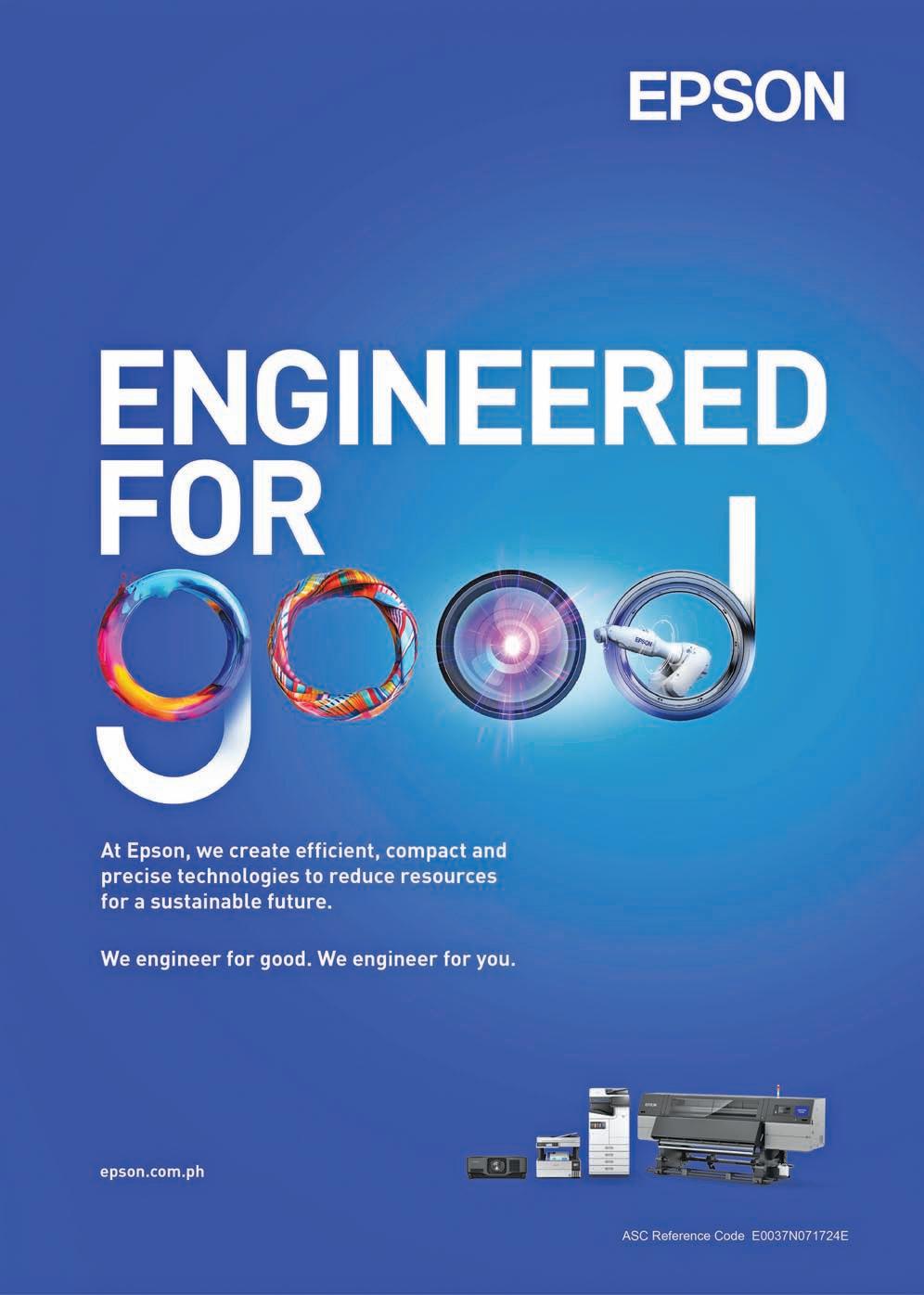
The L5290 also utilizes Epson’s heat-free technology, contributing to energy efficiency and faster print speeds. This technology does not require heat in the ink ejection process. Instead, pressure is applied to the piezo element, which flexes backward and forward, firing the ink from the printhead. This means printer parts last longer, reducing energy consumption and saving energy, time, and money.
Epson’s Engineered for Good campaign reflects the company’s commitment to sustainability and minimizing environmental impact. This aligns perfectly with the EcoTank L5290’s focus on reducing ink waste and energy consumption. By choosing EcoTank printers, users contribute to a more sustainable future by minimizing plastic waste from single-use cartridges and reducing their overall environmental footprint.
Connectivity is crucial in today’s interconnected world, and the L5290 doesn’t disappoint. With built-in Wi-Fi, you can easily connect the printer to your wireless network and print from any device in your home or office. Whether you’re printing from your laptop, smartphone, or tablet, the L5290 offers seamless wireless connectivity, eliminating the hassle of tangled cables and complicated setups. It allows multiple users to share the printer, making it an ideal solution for small businesses or families with various devices.
The L5290 delivers sharp, clear prints, ensuring professionallooking documents. It’s more than just a printer; it’s a productivity booster, a cost-saver, and a reliable partner for any home office or small business. The EcoTank L5290 is ready to handle your printing needs with quiet efficiency and unwavering reliability, allowing you to focus on what matters most.

PLDT Enterprise, the corporate arm of PLDT, elevates mobile security with Silent Authentication which is designed to enhance customer protection by ensuring secure and seamless digital transactions. This technology leverages PLDT Enterprise’s telco network, Smart Communications Inc. (Smart), PLDT’s wireless arm, to revolutionize the way e-commerce, banking, and other digital platforms manage authentication.
Supporting the Bangko Sentral ng Pilipinas’ (BSP) move to shift away from One-Time Passwords (OTPs) to mitigate fraud, Silent Authentication offers a more secure and frictionless alternative for verifying transactions.
BSP recently underscored the vulnerabilities of OTPs, citing their susceptibility to phishing, social engineering, and man-in-themiddle attacks. As part of its broader efforts to strengthen digital security, the BSP has encouraged financial institutions to adopt more advanced authentication solutions.
Silent Authentication eliminates the need for traditional passwords and OTPs (One-Time Passwords), offering users a streamlined and secure method to access their accounts and conduct transactions. With merchants directly coordinating with the telco network for verification through Application Programming Interface, the solution reduces risks associated with phishing, vishing, and OTP-related scams.
“Our exploration of Silent Authentication is a major advancement in our continued promise to provide innovative solutions that secure and enhance the digital experience for our customers,” said John Gonzales, First Vice President and Head of Enterprise Consulting Services and Technology Management at PLDT Enterprise. “By offering a seamless and secure verification method, we empower businesses and individuals to engage in digital transactions with confidence and ease.”
Advancing Customer Experience Through Digital Security
In the Philippines, where mobilefirst transactions dominate the digital landscape, security has become a pressing concern. According to recent reports, the country ranks highest in Asia for e-shopping scams, with a 35.9% scam rate in online shopping.[2] This highlights the urgency for solutions that ensure safety in digital interactions.
Silent Authentication addresses this need by enabling merchants to authenticate transactions through a direct link with the customer’s telco provider, Smart. This minimizes the risk of OTP interception and credential compromise, offering unparalleled protection for digital consumers.
Key Benefits of Silent Authentication
Seamless User Experience: Silent Authentication facilitates faster and more convenient transactions by eliminating delays caused by traditional OTP systems.
Enhanced Fraud Prevention: The solution significantly reduces vulnerabilities to phishing and other cyberattacks, fostering a secure e-commerce ecosystem.
Industry Versatility: From banking to e-commerce, Silent Authentication supports various industries, offering them a robust layer of security without compromising user convenience.
Aligned with PLDT Enterprise’s commitment to the United Nations Sustainable Development Goals, Silent Authentication contributes to fostering a secure digital ecosystem that bridges the digital divide. By supporting the growth of digital transactions in a safe and reliable manner, this innovation empowers businesses of all sizes to thrive and empowers customers to secure digital ecosystem.
PLDT Enterprise is set to unveil more solutions that harness the power of telco data to enhance security and efficiency. Visit bit.ly/PLDTEnterpriseSilentAuthenticationIntro-PR for updates on this initiative.




By Patricia Taculao-Deligero
THE narrative that technological advancement and ecological responsibility are mutually exclusive is outdated. Today, we can—and indeed must—prioritize both.
A sustainable future hinges on our ability to seamlessly integrate eco-friendly technology into our lives to minimize our environmental footprint without sacrificing the conveniences and advancements we’ve come to rely on. This could be as simple as using LED bulbs, smart appliances, or renewable energy sources like solar power. It’s time to leverage innovation to create a world where progress and planetary health coexist. With our conscious choices about the electronics, gadgets, and appliances we use daily, we can transform our homes and workspaces into hubs of sustainable living, bringing hope for a brighter future. Creating a sustainable environment starts at home. Look at the lighting in your house. Switching to LED bulbs is a simple yet powerful change. LEDs consume significantly less energy than traditional incandescent bulbs, reducing your electricity bill and carbon footprint. Beyond energy savings, LEDs also last much longer, minimizing the need for frequent replacements and reducing waste. Smart lighting systems take this a step further, allowing you to control your lights remotely, schedule them to turn on and off automatically, and adjust their brightness to optimize energy use. Imagine a home where lights automatically turn off when you leave a room or dim when natural light is abundant. This level of automation not only saves energy but also enhances convenience.
Next, let’s examine appliances. When replacing an old refrigerator, washing machine, or dishwasher, prioritize an energy-efficient model and look for appliances with high Energy Star ratings or similar certifications indicating superior energy performance. These appliances may have a higher upfront cost, but the longterm savings on your energy bills will more than make up for it. Smart appliances offer even greater potential for energy savings. For instance, smart refrigerators can track food inventory, reducing food waste and unnecessary trips to
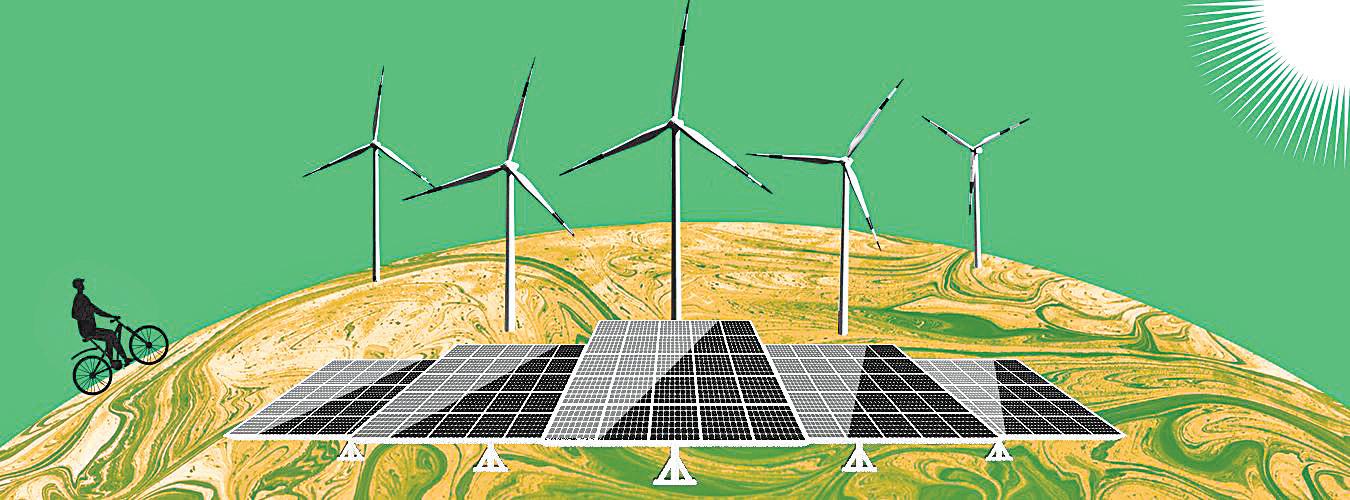

the grocery store. Meanwhile, smart washing machines can optimize water usage based on load size and fabric type. These intelligent features not only save resources but also make our lives easier.
Beyond the major appliances, the smaller gadgets and electronics we use daily are another way we can foster sustainability. When choosing a new laptop or smartphone, look for models with high energy efficiency ratings and those made from recycled or sustainable materials. Many manufacturers are now incorporating
recycled plastics and metals into their products, reducing the demand for virgin resources.
Another way to promote sustainability at home using technology is to use renewable energy, such as solar power. Try using solar-powered chargers for your devices. These chargers harness the sun’s power to replenish your batteries, reducing your reliance on grid electricity. Smart power strips can also help reduce energy waste by automatically cutting off power to devices when they’re not in use. These seemingly minor changes can add up to significant energy savings over time.
In the kitchen, embrace sustainable cooking practices and appliances. Induction cooktops are far more energyefficient than traditional electric or gas stoves, as they heat the pan directly, reducing heat loss. These appliances can significantly reduce cooking times and energy consumption. A countertop composter can help you reduce food waste by turning kitchen scraps into nutrient-rich compost for your garden. It reduces the amount of waste going to landfills and creates valuable fertilizer for your plants.
There are also sustainable choices we can make regarding entertainment. Instead of constantly upgrading to the latest television, extend the lifespan



of your current model. When it’s time for a new TV, look for energyefficient models with features like automatic brightness adjustment and power-saving modes. Alternatively, use a streaming device instead of a cable box, as streaming devices consume less energy. When listening to music, use rechargeable batteries for your headphones or portable speakers instead of disposable ones. Creating a sustainable environment is not just about the products we buy; it’s also about how we use them. Mindful consumption is key. Unplug devices when not in use, as they can still draw power even when turned off. Avoid leaving chargers

plugged in when they’re not charging anything. Repair broken electronics instead of immediately replacing them. Extending the lifespan of our devices reduces waste and conserves resources.
The transition to a sustainable future is not a journey we take alone. It’s a collective effort, where governments, businesses, and individuals all have a role to play. Governments can use policies and regulations to encourage the development and adoption of eco-friendly technologies, and we, as individuals, can contribute to this movement. Each of us is a vital part of the solution, and together, we can make a significant impact.
By Santosh Kesari, Country Manager of Omega Healthcare Philippines
rganizations today grapple with rising operational costs, staff shortages, and complex inefficiencies in revenue cycle management (RCM).
These challenges put pressure on maintaining a balance between operational sustainability and quality patient care.
To address these pressing issues, many providers are increasingly turning to outsourcing as a strategic solution.
Outsourcing RCM has proven to be a powerful approach, enabling healthcare providers to improve efficiency, reduce costs, and focus on delivering quality care.
This shift is reflected by a recent report from Expert Market Research, which projects the global market for RCM outsourcing in healthcare to grow from USD 23.49 billion in 2023 to approximately USD 44.28 billion by 2032.

Outsourcing RCM processes provides healthcare providers with a strategic advantage in addressing operational challenges. By delegating these complex tasks to specialized RCM providers, healthcare organizations can focus on their core mission—delivering quality patient care.
Partnering with an experienced RCM provider eliminates the need for healthcare organizations to invest heavily in staff training or advanced RCM technologies. Outsourcing ensures access to skilled professionals equipped to manage critical functions like medical coding, billing, compliance, and reimbursement processes efficiently.
This growth also signals expanding job opportunities, particularly in the Philippines, where the thriving business process outsourcing (BPO) sector is expected to surpass a two-million-strong workforce by 2025, according to the IT and Business Process Association of the Philippines (IBPAP). This creates a strong pipeline of talent for healthcare RCM providers.
This approach not only reduces operational costs but also minimizes errors in claims and billing. Accurate and timely processing of payments and claims enhances cash flow, boosts financial stability, and drives revenue growth for healthcare providers.
Payments integration, big data, and advanced tech reshape the market
MAYA, the No. 1 Digital Bank in the Philippines, is proving that the next wave of banking growth will be digital-first, data-driven, and embedded in everyday transactions.
Payments integration, big data, and advanced tech reshape the market MAYA, the No. 1 Digital Bank in the Philippines, is proving that the next wave of banking growth will be digital-first, data-driven, and embedded in everyday transactions.
By the end of 2024, Maya had increased deposits to P39 billion and disbursed P68 billion in loans, resulting in total loan disbursements of P92 billion since 2022. Additionally, it served 5.4 million bank customers.
By the end of 2024, Maya had increased deposits to P39 billion and disbursed P68 billion in loans, resulting in total loan disbursements of P92 billion since 2022. Additionally, it served 5.4 million bank customers.
Unlike banks that rely on physical branches and traditional credit scoring, Maya has built a scalable digital banking model by embedding financial services into payments and using AI-driven insights to offer intuitive, responsive products.
Unlike banks that rely on physical branches and traditional credit scoring, Maya has built a scalable digital banking model by embedding financial services into payments and using AI-driven insights to offer intuitive, responsive products.
This strategy is driving rapid adoption, especially outside Metro Manila. Today, 70% of Maya’s customers live in regional areas, where lending and savings growth outpace the capital.
This strategy is driving rapid adoption, especially outside Metro Manila. Today, 70% of Maya’s customers live in regional areas, where lending and savings growth outpace the capital.
“Banking should be simple and empowering,” said Shailesh Baidwan, Maya Group President and Maya Bank Co-Founder. “By merging payments and banking on one delightful digital experience, we’re enabling more Filipinos to save, borrow, and grow their money with ease.”
“Banking should be simple and empowering,” said Shailesh Baidwan, Maya Group President and Maya Bank Co-Founder. “By merging payments and banking on one delightful digital experience, we’re enabling more Filipinos to save, borrow, and grow their money with ease.” Banking Growth Powered by Payments
Banking Growth Powered by Payments
Maya’s key differentiator is its ability to turn payments activity into a gateway for financial services. It uses transaction data to assess creditworthiness, allowing it to offer loans without collateral or excessive paperwork. It also rewards customers with higher savings interest rates based on payment activity and app engagement.
Maya’s key differentiator is its ability to turn payments activity into a gateway for financial services. It uses transaction data to assess creditworthiness, allowing it to offer loans without collateral or excessive paperwork. It also rewards customers with higher savings interest rates based on payment activity and app engagement.
This approach is driving strong gains. Loan activity outside Metro Manila is growing fast, with active borrowers for Maya Easy Credit rising 82% year-on-year, compared to 64% in Metro Manila as of December 2024. Deposit growth follows the same trend. Regional deposit balances surged 67% year-on-year, now accounting for more than half of Maya’s total deposit growth.
Targeting the Underserved
Maya’s success in expanding banking access across the Philippines is rooted in its deep understanding of its customers. Maya designs its products for young, techsavvy Filipinos and small business owners who are often excluded from traditional banking.
“Outside Metro Manila is where the most transformation is happening,” said Angelo Madrid, Maya Bank President. “The surge in savings and credit shows our platform’s impact on more Filipinos.”
Targeting the Underserved
Maya’s success in expanding banking access across the Philippines is rooted in its deep understanding of its customers. Maya designs its products for young, techsavvy Filipinos and small business owners who are often excluded from traditional banking.
Opening an account requires just one ID, with no minimum balance. For entrepreneurs, Maya provides collateral-free loans of up to P2 million, enabling businesses to access much-needed working capital. Consumers can apply for loans of up to P250,000 and receive approval and disbursement within the same day through the Maya app.
As RCM outsourcing continues to play a pivotal role in overcoming healthcare challenges, organizations can benefit from partnering with industry leaders like Omega Healthcare, a leading provider of RCM solutions, which offers unmatched domain expertise and technology-led RCM solutions to enhance efficiency and improve patient outcomes.
Healthcare challenges in RCM
Through outsourcing, healthcare providers gain the expertise, workforce, and technological capabilities needed to streamline their revenue cycle operations, allowing them to allocate resources where they matter most—improving patient outcomes.
Opening an account requires just one ID, with no minimum balance. For entrepreneurs, Maya provides collateral-free loans of up to P2 million, enabling businesses to access much-needed working capital. Consumers can apply for loans of up to P250,000 and receive approval and disbursement within the same day through the Maya app.
Half of Maya Easy Credit borrowers received their first formal loan through the platform, and many small enterprises now rely on its business lending products to sustain and grow their businesses.
Scaling Through Technology and Innovation
RCM serves as the backbone of healthcare operations, encompassing essential tasks such as patient scheduling, medical coding, billing, and payment collection. However, these complex processes often consume significant time and resources, diverting valuable resources from providing exceptional patient care.
Transform healthcare RCM with Omega Healthcare Omega Healthcare empowers healthcare providers with industry-leading expertise and technology-driven solutions designed to address complex RCM challenges. By fostering an ecosystem that unlocks the full potential of healthcare, Omega Healthcare supports providers in achieving seamless operations and improved patient outcomes.
Maya’s rapid growth is underpinned by advanced technology. AI and machine learning process billions of microtransactions to enhance credit scoring, prevent fraud, and deliver personalized services.
Half of Maya Easy Credit borrowers received their first formal loan through the platform, and many small enterprises now rely on its business lending products to sustain and grow their businesses.
Scaling Through Technology and Innovation
The platform’s user-friendly design ensures firsttime customers can easily navigate banking tools, while small businesses benefit from a single platform that integrates payments, banking, and financial management.
Maya’s rapid growth is underpinned by advanced technology. AI and machine learning process billions of microtransactions to enhance credit scoring, prevent fraud, and deliver personalized services.
The platform’s user-friendly design ensures first-time customers can easily navigate banking tools, while small businesses benefit from a single platform that integrates payments, banking, and financial management.
This approach is driving strong gains. Loan activity outside Metro Manila is growing fast, with active borrowers for Maya Easy Credit rising 82% year-on-year, compared to 64% in Metro Manila as of December 2024. Deposit growth follows the same trend. Regional deposit balances surged 67% year-on-year, now accounting for more than half of Maya’s total deposit growth.
The approach is paying off. Regional loan drawdowns surged 137% year-on-year, now accounting for 70% of Maya’s lending growth. Embedded finance partnerships with retailers and fintech players, including Landers Supermarket, Grab, Tala, and WeFund, further extend Maya’s lending reach.
Managing RCM also requires skilled professionals who are adept at navigating compliance requirements, adapting to evolving regulations, and utilizing advanced technologies. Training staff to meet these demands can be resource-intensive, contributing to rising operational costs for healthcare providers. Additionally, maintaining an in-house RCM team necessitates continuous investment in technology and talent development.
“Outside Metro Manila is where the most transformation is happening,” said Angelo Madrid, Maya Bank President. “The surge in savings and credit shows our platform’s impact on more Filipinos.”
“With digital banking that’s intuitive, we’re reaching communities that have been underserved for far too long,” Baidwan said.
The approach is paying off. Regional loan drawdowns surged 137% year-on-year, now accounting for 70% of Maya’s lending growth. Embedded finance partnerships with retailers and fintech players, including Landers Supermarket, Grab, Tala, and WeFund, further extend Maya’s lending reach.
Maya Philippines, Inc. and Maya Bank, Inc. are regulated by the Bangko Sentral ng Pilipinas. (www.bsp.gov.ph). Deposits are insured by PDIC up to P500,000 per depositor.
“With digital banking that’s intuitive, we’re reaching communities that have been underserved for far too long,” Baidwan said.
When staff lack adequate training, errors and inconsistencies can occur in critical areas such as patient billings and collections. These mistakes often result in delayed or denied payments, which can disrupt cash flow and affect the financial stability of healthcare organizations.
The benefits of outsourcing RCM
To meet the growing demand for RCM services, Omega Healthcare operates multiple delivery centers, including locations in Manila and Cebu in the Philippines. These centers in the country are supported by a skilled workforce of over 2,600 employees, with more than 200 new hires each month. These professionals are expertly trained to manage all RCM tasks—from patient scheduling and registration to billing and payment collection—ensuring efficient and accurate processes that drive operational success.
This workforce is supported by the Omega Digital Platform, a proprietary technology offering advanced automation capabilities and data-driven analytics. These tools enable healthcare providers to optimize workflows, reduce errors, and enhance financial performance.

By Atty. Noel M. Baga
AS the Philippines pursues energy transformation, we must prioritize what matters most: ensuring a reliable and secure power supply for our nation.
While the country has committed to ambitious renewable energy targets—35% by 2030 and 50% by 2040—these goals must be pursued within a framework that places energy security at its core. The transition to renewable energy carries substantial hidden costs that must be carefully weighed against our development priorities.
As we at the Center for Energy Research and Policy (CERP) consistently emphasize, a nation’s development and resilience depend first and foremost on its ability to maintain a stable and dependable power supply.
The first major hidden cost stems from the inherent variability of our primary renewable options. Solar and wind power, despite their promise, cannot yet guarantee the consistent power supply our economy demands. When clouds gather or winds fall still, power

generation fluctuates, potentially compromising the baseload power essential for our industries, hospitals, and daily lives. This intermittency requires substantial backup power investments, adding significant system costs that ultimately affect consumer prices. While battery storage systems offer a potential solution, their implementation costs run into billions of pesos, requiring substantial investment and technological expertise that must be weighed against immediate energy security needs.
Our grid infrastructure demands equally costly upgrades. The National Grid Corporation of the Philippines must undertake extensive modernization to accommodate renewable energy sources without compromising system stability. These essential upgrades are estimated to cost hundreds of billions of pesos over the next decade. Without these crucial upgrades, the integration of variable renewable energy sources could lead to increased power outages—a direct threat to energy
security. More concerning still, some of our most promising renewable energy sites lack basic transmission infrastructure, requiring additional billions in investment to connect these resources to the grid.
The territorial aspects of renewable energy projects introduce significant compensation and social costs. These installations require vast tracts of land, often leading to conflicts with local communities and indigenous peoples.
Such conflicts can delay or derail energy projects, potentially impacting our ability to maintain a secure power supply and adding substantial risk premiums to project financing. As we pursue environmental sustainability, we must ensure that our energy security isn’t compromised by protracted landuse disputes.
The environmental and social costs of renewable technology production translate into real financial burden.
The mining operations required for solar panels and wind turbines raise important questions about resource security and environmental impact.
The projected demand for silver alone—estimated to exceed 50% of global reserves by 2050—will drive up equipment costs significantly.
Additionally, end-of-life disposal and recycling of renewable energy equipment represents a future cost that is often overlooked in current planning.
This doesn’t mean we should abandon our renewable energy aspirations. Rather, we must pursue them within a hierarchy of energy priorities: security first, followed by affordability and sustainability. A balanced strategy must invest in grid modernization and energy storage solutions while ensuring robust protections for indigenous rights and local communities. This approach should encompass responsible mining practices and create an energy framework that prioritizes security while advancing sustainability goals. As CERP advocates, the path to a resilient energy future requires careful consideration of all these factors. The true cost of renewable energy transition extends far beyond the headline equipment prices, encompassing grid upgrades, land acquisition, community support, and system reliability investments. Our renewable energy goals are achievable, but their pursuit must not compromise the fundamental requirement of energy security. Only through methodical planning, inclusive dialogue, and responsible implementation—with energy security as our guiding principle— can we create an energy landscape that truly serves all Filipinos. (Noel Baga is the convenor of the think tank Center for Energy Research and Policy.)
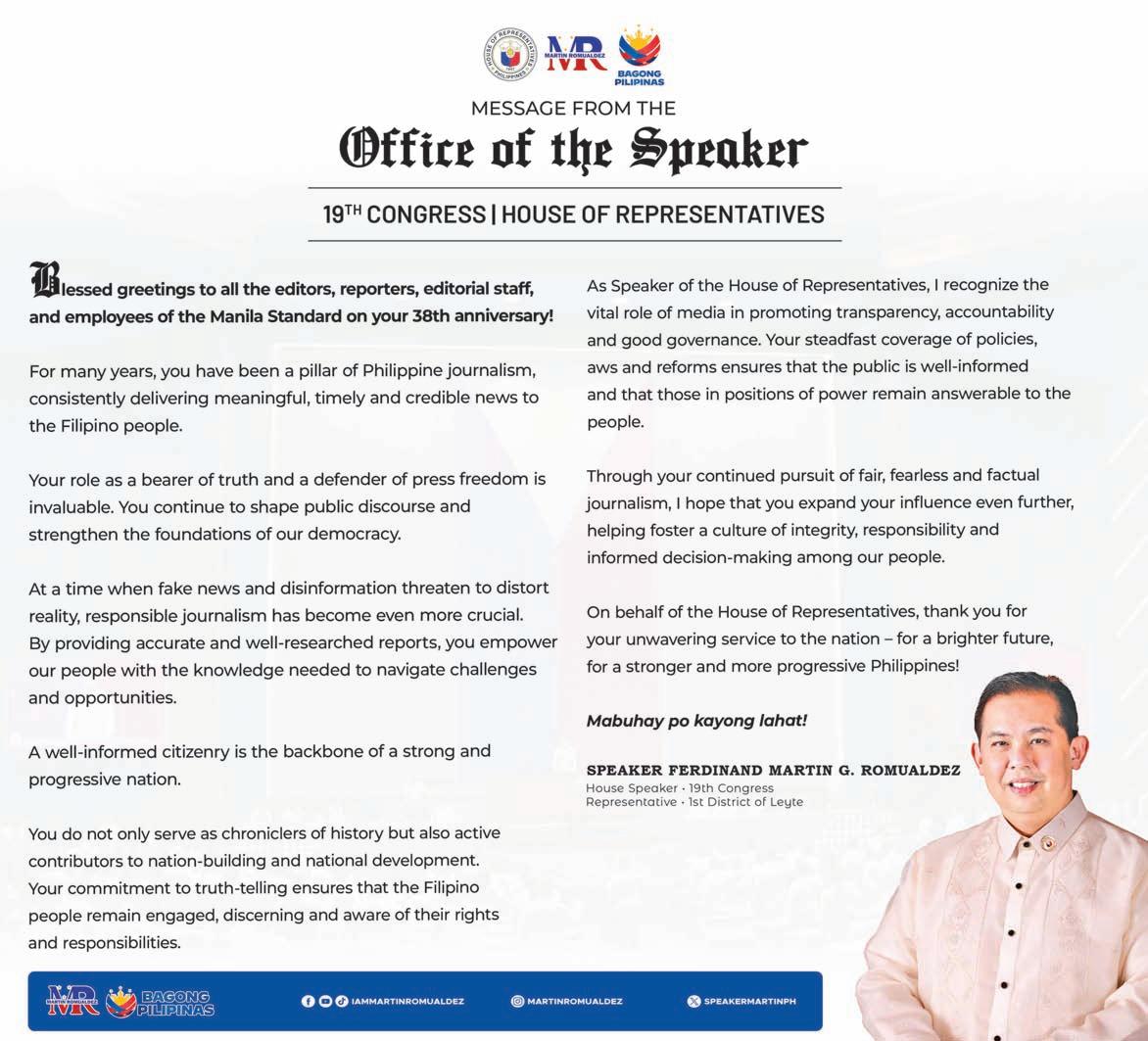

AJINOMOTO Philippines
Corporation (APC Group) is making waves in the sustainability space with a powerful commitment to environmental responsibility. From launching solar power at its Bulacan plant to achieving 100% renewable energy and spearheading impactful waste reduction programs like TOO GOOD TO WASTE and SariCycle, APC Group is proving that businesses can drive meaningful change for both people and the planet. The efforts underscore APC Group’s broader commitment to environment sustainability and innovation.
Ajinomoto Philippines Powers
Up with Renewable Energy, Slashing Carbon Footprint by 950 Tons
In a major step toward sustainability, APC Group marked a green milestone with an Energization Ceremony on June 1, 2022, celebrating the introduction of solar power at the Ajinomoto Philippines Flavor Food Inc. factory in Guiguinto, Bulacan. In partnership with Meralco-owned Spectrum, the solar installation covered roughly 20% of the facility’s annual energy needs.
“We, at Ajinomoto, are proud of the steps that we are taking as an advocate for environmental wellness. Introducing solar energy to our Bulacan plant is just the beginning of the many environmental projects that we have in our sustainability roadmap,” said APC Group Director of Supply Chain Management and Chief Sustainability Officer Ernesto Carlos.
Propelling its journey towards achieving 100% Renewable Energy for its Bulacan factory
The APC Group partnered with ACEN Renewable Energy Solutions which, as of December 2023, supplied the facility with renewable energy from their diverse portfolio. A commemorative MOA signing was held on March 1, 2024, to celebrate this milestone. Since its energy transition, the Bulacan facility was able to cut its carbon emissions by approximately 950 metric tons —comparable to eliminating 3.8 million kilometers of vehicle travel in a year. With ACEN RES’s support, the factory is now fully powered by renewable energy, reinforcing APC Group ’s leadership in sustainable business practices, proving that sustainability and business can go hand in hand.
Ajinomoto Philippines Strengthens Sustainability Efforts with New Waste Management Partnerships
In a decisive move toward environmental responsibility, APC Group has partnered with four leading waste management organizations to advance compliance with the Extended Producer Responsibility (EPR) Act of 2022. At a Memorandum of Agreement signing on September 1, 2023, APC Group formalized collaborations with Basic Environmental Systems and Technologies (BEST), Envirotech,
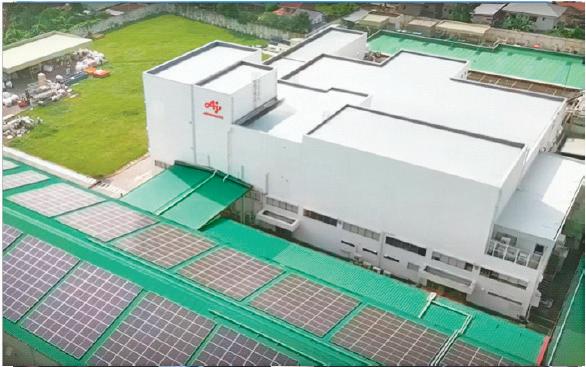
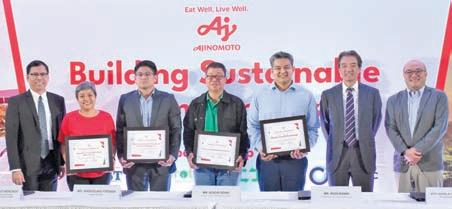
Mr.
and

can make a positive impact on the environment and create a more sustainable future for all.”
With these partnerships, APC continues to lead the food industry in environmental stewardship, proving that corporate responsibility and sustainability go hand in hand.
APC’S Global Commitment: TOO GOOD TO WASTE™ Beyond plastic waste reduction, APC Group is also taking a stand against food loss and food waste through its TOO GOOD TO WASTE™ (TGTW) initiative. A study conducted by the DOST-NFRI

Credit Exchange (PCX), and Republic Cement — each playing a key role in plastic waste recovery, recycling, and sustainable disposal. “We encourage all companies to embrace the EPR Act and take a proactive approach to managing their plastic footprint,” said Ernesto Carlos, APC’s Chief Sustainability Officer.
in 2023 showed that rice, vegetables and meat are the top three most wasted foods that unfortunately should have been a decent meal for the hungry.
As a food company that has been part of every Filipino household for over 66 years, APC Group embarks on a new campaign to provide a solution to this alarming situation of food loss and food waste in the Philippines.
Too Good To Waste is an initiative that originated from Ajinomoto Co., Inc. in Japan that aims to help consumers

realize the potential value of food and rethink what we throw away. Through this project, APC Group aims to raise awareness and present practical solutions to minimize food wastage. The TGTW logo has three exclamation points, each with a dot depicting what is commonly discarded: a carrot top, a half-eaten chicken leg and a fish head.
Part of APC Group’s TGTW campaign is to offer practical recipes and tips on its Cookmunity website that encourages consumers to creatively use all their ingredients and transform leftovers into new dishes, making food waste reduction a habitual practice
Systems and Technologies (BEST), the initiative has made a substantial impact on reducing plastic waste in local communities.
In just one year, the SariCycle program successfully collected 8.1 metric tons (8,100 kilograms) of single-use plastics, equivalent to over 16 million sachets, demonstrating the effectiveness of community-driven environmental efforts. The program engaged 1,000 active SariCyclers across 23 barangays, reinforcing the power of collective action in tackling plastic pollution.
To mark this significant milestone, APC Group recognized the Top SariCyclers whose contributions have been instrumental in the program’s success. These individuals embody the essence of environmental stewardship, proving that collective efforts can lead to meaningful change.
As APC Group continues to lead sustainability efforts, the company remains committed to expanding the reach and impact of SariCycle, reinforcing its dedication to a cleaner and greener Philippines.
Expanding the Impact:
From One to Malawakan
Following the success of SariCycle in Quezon City, APC Group is now set to expand the program to other municipalities through a partnership with the Philippine Association of Stores and Carinderia Owners (PASCO). This expansion aims to inspire more communities to participate in sustainable waste management while strengthening long-term environmental commitments.

for everyone and empowering individuals to contribute to the preservation of our resources and the environment through mindful consumption.
APC Group launched the TGTW campaign video at The Eat Well, Live Well Youth Summit held last November in Cebu City.
The campaign video was also released at Ajinomoto Philippines’ official website and FB Cookmunity Page so that more Filipinos can join the movement and be part of the solution on food loss and food waste and start to make a difference.
Celebrates a Year of Transforming Plastic Waste Management
The APC Group marks a major sustainability milestone with the first anniversary of its SariCycle program, an incentivized plastic collection and recycling initiative. In collaboration with the Quezon City Climate Change and Environmental Sustainability Department (QC CCESD) and Basic Environmental

“This milestone is a testament to what can be achieved when communities and organizations work together,” said Ernesto Carlos, Chief Sustainability Officer of APC Group. “We are proud of SariCycle’s achievements and look forward to scaling its impact across the country.”

A Positive Outlook for the Philippine Market APC Group President, Koichi Ozaki, emphasized the group’s confidence in the growing Philippine economy. “The opportunities in the Philippines are immense. We aim to further expand our investments in the country, diversifying into areas such as frozen foods and supplements, alongside our core seasoning products.” Future investments may include the local manufacturing of new product lines, depending on market demand and logistical feasibility. “We will explore every opportunity to grow our business portfolio in the Philippines,” Mr. Ozaki added.
About Ajinomoto Philippines
Ajinomoto Philippines Corporation has been serving Filipino households for decades, offering high-quality seasonings and food products. The company is dedicated to enhancing the quality of life through its products and sustainability initiatives. For more information, visit www.ajinomoto. com.ph.

BYD Cars Philippines sold an impressive 4,780 passenger vehicles in 2024, capturing an astonishing 82 percent share of the Philippine NEV market. Among these sales, popular models such as the BYD Seagull, Dolphin, Atto 3, T3, Seal, Han, and Tang contributed to a commanding 69 percent market share in the battery-electric vehicle (BEV) segment.
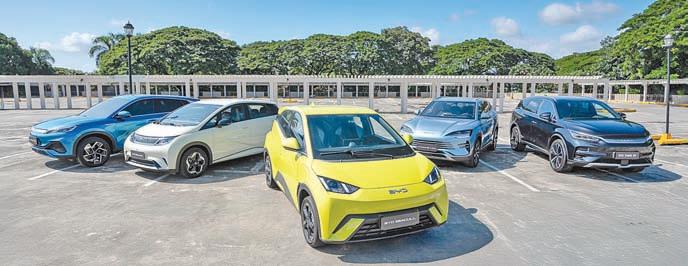

The standout performer was the BYD Sealion 6 DM-i, which sold 2,669 units, making it BYD’s topselling model. From July to December, it also became the best-selling vehicle in both the NEV and hybrid electric vehicle (HEV) segments, capturing a 19 percent market share.
The ACMobility-led brand’s remarkable sales performance marked an astounding 8,900 percent growth compared to 2023, elevating the brand to the 11th best-selling automotive brand in the Philippines with a 1.0 percent market share—surpassing several established competitors and other Chinese brands. On a global scale, BYD set a new sales record, moving 4,272,145 New Energy Vehicles in 2024, a 41.26 percent increase from the previous year. This milestone marks the first time BYD has sold over 4 million units in a single year, establishing the company as the undisputed Global New Energy Vehicle Market Sales Champion.
Bob Palanca,
Managing Director
of BYD Cars Philippines, expressed excitement over the company’s 2024 performance, calling it a pivotal year. He noted that this achievement reflects the dedication of the team, the unwavering support of dealer partners, and the trust of valued customers. Palanca emphasized that together, they will continue driving the Philippines toward a smarter and greener future with innovative and accessible solutions.
BYD’s extraordinary success can be attributed to its cutting-edge lineup of electric vehicles. The BYD Sealion 6 DM-i not only led sales but also captured a 14.6 percent share in the overall Compact-SUV market in 2024, alongside a 25.9 percent share from July to December. The BYD Atto 3 subcompact crossover also made waves, with 1,062 units sold in 2024, giving it a remarkable 35 percent market share in its segment. This model has provided Filipino consumers with a reliable and comfortable Blade Battery-powered
electric mobility solution. Meanwhile, the BYD Seagull, introduced in the Philippines in September, ranked as the third-best-selling model, with 411 units sold and a 38 percent share of the BEV segment in the last quarter of 2024.
These impressive results highlight the growing acceptance of electric vehicles among Filipinos, marking a significant step toward a greener future. Aiffy Liu, Country Head of BYD Philippines, stated that the company is committed to providing more Filipinos with global models that symbolize smarter mobility solutions and is focused on sustaining this momentum by delivering innovative and affordable options.
A crucial factor in BYD’s remarkable growth has been its rapid dealership expansion. Starting 2024 with only two dealerships, BYD closed the year with 25 operational locations nationwide. To enhance accessibility further, the company has approved 52 new dealer locations for 2025.








By Sam Millano
In 2005, the streets of Manila thrummed with a symphony of roaring engines, the unmistakable hiss of turbo blow-offs, and the occasional squeal of tires on asphalt. The Philippine car scene was in full throttle, dominated by the raw, mechanical charm of internal combustion engines (ICE). Fast forward to 2025, and that symphony has transformed into a quieter, more calculated hum. The passion hasn’t faded; it has evolved, adapting to new technologies, environmental consciousness, and shifting lifestyles.
So, what exactly has changed in two decades? Let’s take a drive down memory lane to see how the Philippine automotive landscape has shifted from pure petrol power to hybrids, plug-in hybrids (PHEVs), and battery electric vehicles (BEVs).
In 2005, car culture in the Philippines celebrated individuality and mechanical prowess. It was the heyday of the JDM (Japanese Domestic Market) craze, with iconic models like the Honda Civic EG and EK, Toyota Corolla AE92 and AE101, and Mitsubishi Lancer GSR being passed down from an aging Gen X crowd to their millennial offspring. These vehicles were more than just modes of transport; they were canvases for self-expression. Car enthusiasts invested in aftermarket modifications, from body kits and spoilers to engine swaps and turbo upgrades. The streets were alive with lowered sedans, custom exhausts echoing through underpasses, and racing stripes hinting at the drivers’ penchant for speed. Weekly car meets became rituals, whether at The Fort in Taguig or Ortigas Home Depot, where hood pop-ups were as common as selfies today.
charging times. The younger generation, raised amid climate change discussions, is more inclined to choose eco-friendly cars without sacrificing performance.
This doesn’t mean the Filipino love for cars has waned; it has simply evolved. Drag races and tuning battles have given way to EV range challenges and autonomous driving showcases. The thrill remains, but it’s found in different forms: how quickly an EV can reach peak torque or how adeptly a car’s Advanced Driver Assist Systems (ADAS) navigate EDSA traffic. THE TECH FACTOR
In 2005, the most high-tech feature in a car might have been a Pioneer sound system or an aftermarket turbo timer. Fast forward to 2025, and cars are essentially rolling smartphones. Touchscreens, voice commands, over-the-air updates, and autonomous driving features are now standard in many vehicles.
Take the Hyundai Ioniq 5, for example. It’s not just an electric car; it’s a tech showcase, featuring augmented reality head-up displays, vehicle-to-load (V2L) charging capabilities, and adaptive cruise control reminiscent of a sci-fi movie. Even mainstream models like the Toyota Yaris

Despite the post-9/11 political landscape, gasoline remained relatively affordable, and emissions regulations were, shall we say, less stringent. This resulted in a culture thriving on manual transmissions, high-revving engines, and the tactile joy of driving. Cars were loud, proud, and unapologetically analog. By 2025, a new narrative has taken hold. The Philippine automotive scene has shifted from the raw, fuel-fueled rebellion of the early 2000s to a more tech-driven, eco-conscious movement. Hybrids, PHEVs, and BEVs are no longer novelties; they are becoming the new norm.
The streets now feature vehicles like the Toyota Corolla Cross Hybrid, BYD Sealion 6, and Hyundai Ioniq 5, alongside a slew of Chinese BEV models. These vehicles embody a balance of efficiency, performance, and cutting-edge technology. The once-unimaginable sight of charging stations in malls and parking lots is now as common as gas stations.
Moreover, Filipino car buyers, once skeptical, are warming up to the idea of silent, electric propulsion. It’s not just about reducing carbon footprints; it’s about embracing the future of mobility. The instant torque of electric motors, seamless infotainment connectivity, and advanced driver-assist features are redefining the driving experience. FROM HORSEPOWER TO KILOWATT-HOURS: CHANGING CONSUMER MINDSETS
Back in 2005, the mantra was simple:
“The more horsepower, the better.” It was all about acceleration, exhaust growls, and turning heads at stoplights. Fuel economy? It was an afterthought, if considered at all. But in 2025, the conversation has shifted to efficiency, sustainability, and tech integration. Car buyers now consider kilowatt-hours, battery range, and
Cross Hybrid come equipped with advanced safety systems and smart infotainment. This tech integration has attracted a new breed of car enthusiasts—those who value innovation over raw power. For them, a car isn’t just about driving; it’s about connectivity, efficiency, and integration into a digital lifestyle.
THE ROAD AHEAD
Of course, the transition hasn’t been without challenges. Infrastructure remains a hurdle. While charging stations are more prevalent, they are still concentrated in urban centers like Manila, leaving provinces lagging behind. The initial cost of EVs and hybrids is also higher, despite long-term savings on fuel and maintenance. Moreover, many car enthusiasts retain a nostalgic attachment to the classic roar of ICE engines. Many hold on to their Project Cars, preserving the legacy of manual transmissions and turbocharged engines. Yet, even among purists, there’s an acknowledgment that the future is electric.
A CULTURE IN MOTION
From the revving engines of 2005 to the silent, tech-savvy rides of 2025, the Philippine car culture has undergone a remarkable transformation. What hasn’t changed is the passion—Filipinos still love their cars. Whether it’s a customized Civic from the early 2000s or a sleek EV with autonomous features, cars continue to be an extension of identity and a symbol of freedom. As the country navigates this evolving landscape, one thing is clear: the road ahead is as exciting as ever. Whether fueled by gasoline or kilowatt-hours, the Filipino love affair with cars is here to stay—just with a quieter, more sustainable hum. In the immortal words of every car enthusiast: It’s not just about the destination—it’s about the drive. And in 2025, that drive is looking smoother, smarter, and a whole lot greener.

By Sam Millano
N ELECTRIC
storm is brewing, set to transform the Philippine automotive landscape. Tesla—yes, that Tesla—has recently established its presence in the country, bringing with it a mix of hype, innovation, and disruption that has already reshaped the global EV industry.
But Tesla’s arrival could benefit not just itself; it has the potential to revolutionize the entire Philippine EV market, including its competitors.
A SMARTPHONE ANALOGY
Consider the smartphone industry. Before the iPhone, touchscreens were a novelty, app stores were nonexistent, and phones were merely tools for calls and texts. Apple didn’t just create a popular phone; it redefined the industry, compelling competitors to elevate their offerings. Today, while Apple has its loyal followers, the Android ecosystem—with brands like Samsung, Google, and OnePlus—has flourished. Tesla is the iPhone of the EV world, while its competitors represent the Android landscape—diverse approaches all aiming for the same future. Just as the smartphone revolution sparked innovation, Tesla’s potential entry into the Philippines could catalyze a serious commitment to electric mobility. Here’s why that’s beneficial for all.
CREATING MASS AWARENESS FOR EVS
Currently, EVs remain a niche market in the Philippines. Brands like Nissan (with the Leaf) and BYD have made attempts, but many Filipino car buyers view EVs as either too expensive, impractical, or unfamiliar. Enter Tesla.

Tesla has a unique ability to make EVs exciting. It’s not solely about efficiency or sustainability; it’s about performance, cutting-edge technology, and an undeniable cool factor. When Tesla enters a market, it generates buzz—media coverage, influencer discussions, and a shift in perception. Suddenly, EVs transform from an abstract concept to an aspirational choice. This curiosity doesn’t just focus on Teslas; it broadens interest in all EVs. As a result, more attention is drawn to competing brands, conversations about charging infrastructure gain momentum, and public interest in the future of transportation grows.
STRENGTHENING COMPETITION
Returning to the iPhone-Android analogy, the iPhone set the standard and compelled Android manufacturers to innovate. The same dynamic will
unfold in the Philippine EV sector. Currently, many EV options appear as afterthoughts—overpriced or lacking essential features. Tesla’s entry will establish a new benchmark, prompting competitors to enhance their offerings.
Brands like BYD are already making waves globally with affordable, techrich EVs, while Hyundai and Kia are rolling out impressive electric models. With Tesla in the mix, expect these companies to refine their strategies and compete more aggressively.
Boosting Charging Infrastructure
One significant barrier to EV adoption in the Philippines is the lack of robust charging infrastructure. The current setup is limited and inconsistent, leading to range anxiety among potential buyers.
Tesla’s entry could catalyze meaningful change. The company doesn’t just sell cars; it builds
ecosystems, including Superchargers and collaborations with local businesses to expand charging access. As this infrastructure develops, it benefits all EVs, not just Teslas. Other brands will likely respond by promoting their own charging solutions, leading to a more competitive and widespread network. Businesses will recognize the profitability of EV charging, prompting gas stations, malls, and even residential complexes to follow suit.
ENCOURAGING SUPPORTIVE GOVERNMENT POLICIES
Philippine EV policies are still in their infancy. While there are tax breaks and incentives, they don’t create a seamless adoption process. Tesla’s presence could change that. When a global giant like Tesla enters a market, it pressures governments to adopt more EV-friendly policies.
In many countries, Tesla’s arrival has coincided with improved tax incentives, charging mandates, and streamlined import regulations. With Tesla in the Philippines, expect serious discussions around EV subsidies, charging station mandates, and partnerships between government and private companies. Ultimately, these policies would benefit all EV brands.
Improving Resale Value and Aftermarket Support
Potential EV buyers in the Philippines often worry about resale value. Given the market’s size, concerns about depreciation and longterm reliability loom large. However,
when Tesla enters a market, resale values tend to stabilize.
This stability stems from Tesla’s strong global reputation, dedicated fanbase, and software updates that keep older models relevant. As Teslas populate Philippine roads, expect enhanced aftermarket support, including third-party repair shops and battery replacement services— creating a robust second-hand market. And this improvement isn’t just beneficial for Tesla owners; as the EV ecosystem matures, other brands will also enjoy better resale values and aftermarket support, making EV ownership a more viable long-term investment.
THE FUTURE OF EVS IN THE PHILIPPINES STARTS NOW
Tesla’s arrival in the Philippines represents more than just car sales— it signals the acceleration of an entire industry. Just as the iPhone didn’t eliminate Android but instead spurred innovation, Tesla’s presence won’t eliminate competition. Instead, it will strengthen the entire EV market, making it more competitive and appealing to consumers.
Expect increased awareness, innovation, better infrastructure, stronger government support, and a healthier second-hand market. Tesla’s entry may begin as a disruptor, but in the long run, it could be exactly what the Philippine EV industry needs to take off. Whether you’re a die-hard Tesla fan or simply seeking better EV options, that’s something to get excited about.




By Andy Sevilla
THE future of a potential merger between Nissan Motor Co., Ltd. and Honda Motor Co., Ltd. hangs in the balance as reports emerge that Nissan is set to withdraw from ongoing negotiations. Sources indicate that differences in the talks have grown significant enough to jeopardize the proposed $60 billion deal aimed at creating the world’s third-largest automaker.
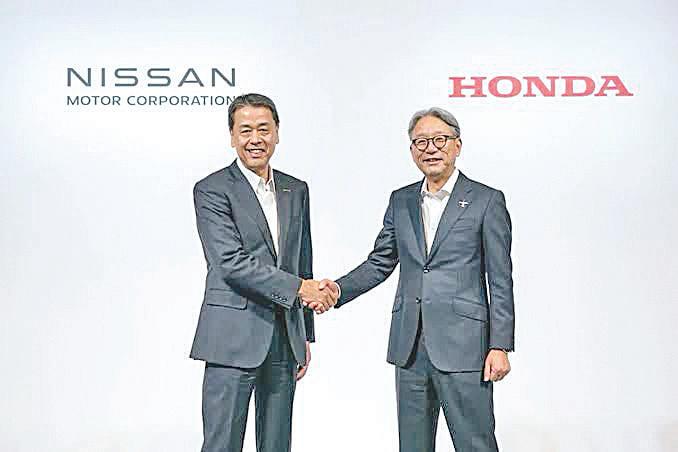
This week, the Nissan board convened and reportedly decided to halt discussions, primarily due to Honda’s insistence on being recognized as a subsidiary—a stance that contradicts the initial vision of a merger of equals. These developments come in the wake of a memorandum of understanding (MOU) signed just before Christmas, which aimed to explore business integration through a joint holding company.
The collaboration between the two automotive giants was anticipated, given their ongoing partnership to promote carbon neutrality and address the challenges posed by the shifting automotive landscape. Since March 2023, Nissan and Honda have been working together to enhance vehicle intelligence and electrification, culminating in a strategic partnership that included joint research on platforms for next-generation software-defined vehicles.
However, Nissan has been grappling with declining market performance, resulting in significant workforce reductions and production cuts. The joint conference held on December 23, 2023, in Tokyo was seen as a response to concerns over Nissan’s viability in an increasingly competitive market dominated by aggressive Chinese electric vehicle manufacturers.
During the conference, Nissan’s chief executive officer Makoto Uchida expressed optimism about the potential merger, stating, “Today marks a pivotal moment as we begin discussions on
business integration that has the potential to shape our future.” Meanwhile, Honda’s president Toshihiro Mibe emphasized the importance of combining resources to create new mobility solutions amid a challenging industry landscape.
As Nissan’s struggles deepen, with a staggering 94 percent profit decline reported for the six months ending September 2023, the urgency for a successful merger grows. Analysts have raised alarms about Nissan’s financial stability, speculating that bankruptcy could be on the horizon as debt obligations loom. The latest reports have already affected stock prices, with Nissan shares tumbling over 4 percent on the Tokyo Stock Exchange, while Honda’s shares surged by more than 8 percent. Both companies have issued statements refuting the notion that a final decision has been made regarding the talks, reaffirming their commitment to reach a conclusion by mid-February.
Amidst all this, the involvement of Renault, Nissan’s long-term partner, adds another layer of complexity. Renault has expressed its willingness to support the merger, seeking to protect the interests of the alliance.
As the clock ticks down to the revised deadline, the automotive industry watches closely. The primary question remains: Can Nissan navigate its current crisis alone, or will the opportunity for a strategic alliance with Honda slip away?

ELEGANT. RUGGED. ELECTRIFIED. For the first time in its 23-year story, the iconic Kia Sorento nameplate is embracing electrification. Now available in the Philippines, the all-new Kia Sorento Turbo Hybrid delivers an impressive combination of eco-conscious efficiency, robust all-wheel drive performance, and modern luxury, making it a compelling choice for Filipino families seeking both sustainability and style. The launch punches Kia’s commitment to hybrid and electric mobility, expanding its lineup with cutting-edge hybrid technology that enhances both driving dynamics and fuel efficiency. The Kia Sorento embodies a seamless blend of power and practicality while reducing its carbon footprint.
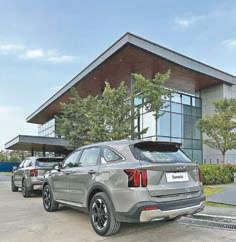
Sustainability Meets Performance
Acer’s sustainability efforts are exemplified with the latest Aspire Vero 16 (AV16-71P), a carbon-neutral laptop and the world’s first to incorporate bio-based oyster shell material[i],. This laptop has remained committed to carbon neutrality throughout its lifecycle[1]. It has also increased the usage of PCR and bio-based materials by more than 70%[2] on the chassis compared to its previous model. Other design details reflect the Vero line’s eco-conscious identity, including its ocean-bound plastic touchpad, reduced PET thickness, and easy-to-repair design, ensuring a reduced environmental footprint. The durable MIL-STD-810Hcertified chassis can withstand daily use while maintaining a sleek, modern look and feel.






The Aspire Vero 16 is powered by Intel Core Ultra 200H series processors supported by up to 32 GB of memory and up to 2 TB of storage, offering robust performance for all computing needs. The “green but mean” machine has revolutionized sustainability and performance in today’s mobile AI PCs, earning recognition as a CES 2025 Innovation Award Honoree.
For work or entertainment, the Aspire Vero’s 16-inch display brings clear, sharp images with 100% sRGB color gamut support and a wide aspect ratio thanks to slim bezels. Collaboration and security are enhanced with a high-resolution 1440P QHD webcam, privacy features, vital connectivity options in Wi-Fi 7, HDMI 2.1, and two Thunderbolt 4 ports.
The bold innovation from Acer offers a sustainable laptop option without compromising performance or durability.

By Peter Atencio
THE Philippine sports scene is riding high after a remarkable 2024, punctuated by the historic achievements of Carlos Yulo, who clinched two gold medals, and the bronze medal wins of Nesthy Petecio and Aira Villegas at the Paris Olympic Games.
Building on this momentum, Philippine Sports Commission (PSC) Chairman Richard Bachmann has articulated a vision for sustained success in 2025 and beyond, emphasizing the agency’s unwavering commitment to supporting
demonstrating the depth of talent emerging from the grassroots level. “We recognize that the future of Philippine sports lies in the hands of our youth,” Chairman Bachmann emphasized.
“The Batang Pinoy 2024 proved to be

Filipino athletes on their journey to international prominence.
“2024 was a truly triumphant year for Philippine sports,” Chairman Bachmann declared. “It was a year that not only inspired the entire nation but also reignited the passion for sports across all sectors of society. The collaborative efforts we witnessed, from grassroots development to elite competition, culminated in some truly historic achievements.
Carlos Yulo’s double gold at the Paris Olympics, along with the inspiring bronze medals earned by Nesthy Petecio and Aira Villegas, stand as powerful testaments to the dedication and talent of our athletes. Furthermore, the promising performances of our Paralympic athletes showcased their incredible resilience and determination.”
He added, “As we look ahead to 2025, our vision is clear: we aim to build on these successes, achieve even greater heights, and establish a foundation for sustainable and long-term success in Philippine sports.”
The PSC’s commitment to nurturing young talent was evident in the success of events like the Batang Pinoy 2024, which took place in Puerto Princesa City.
This event served as a crucial platform for discovering and developing the next generation of Filipino athletes.
Young swimmers like Arvin Taguinota, along with the contingent from the City of Pasig, delivered exceptional performances,
an overwhelming success, not only in terms of participation but also in its ability to unearth promising new talents and ignite fresh aspirations among young Filipinos. These young athletes represent the future of our nation in the world of sports, and we are committed to providing them with the resources and opportunities they need to reach their full potential.”
Chairman Bachmann firmly believes that the Philippines has the potential to become a global force in sports, and that this potential can be realized through continued investment in both grassroots development programs and elite-level competitions.
“Our ability to compete and succeed on the international stage underscores the immense potential of our nation to become a prominent player in the global sports arena,” he stated.
“The fact that the Philippines has successfully hosted multiple international sporting events demonstrates not only our capacity to organize world-class competitions but also the unwavering passion and enthusiasm of the Filipino people for sports excellence. We are confident that with the right support and resources, our athletes can achieve even greater things on the world stage.”
The PSC is deeply committed to improving the welfare of national athletes and providing them with the necessary tools to succeed.
“While we celebrate the successes of 2024, we remain acutely aware of the chal-
lenges that lie ahead,” Chairman Bachmann acknowledged.
“We are committed to continuously enhancing the welfare of our athletes, both on and off the field. Significant improvements to their training facilities are currently underway, and we are working tirelessly to ensure that their needs are met in every aspect of their athletic development. The 2025 calendar is packed with numerous international tournaments, and we are confident that our athletes are ready to build on their achievements and strive for
even greater goals.”
Chairman Bachmann also emphasized the importance of financial assistance and robust programs in supporting athletes, national sports associations, and promising young talents.
“We recognize that financial resources play a critical role in the success of our athletes,” he said.
“We are committed to increasing financial assistance and strengthening our programs to ensure that our athletes have the resources they need to train, compete, and excel
at the highest level. We will also continue to expand platforms for youth development by strengthening our linkages with stakeholders nationwide and deepening our collaboration at every level. By working together, we can create a more sustainable and thriving sports ecosystem for generations to come.”
The PSC’s vision is clear: to build a legacy of champions, to inspire a nation through sports, and to create a brighter future for Filipino athletes on the world stage.








• Mondelēz International and PCX Markets expand sustainability efforts
• Plastic collection sites in Parañaque City bolster plastic cleanup partner badge of the snacks company
MONDELĒZ International in the Philippines, in collaboration with its partners and rooted in its home community of Parañaque City, PCX Markets, HOPE, Barangay BF Homes, and SM Cares, proudly announces the launch of two new Aling Tindera sites in Barangay BF Homes and SM City Sucat.
Mondelēz International is the maker of beloved brands such as Oreo, Cadbury Dairy Milk, and Toblerone. The Aling Tindera is a flagship initiative by impact organization HOPE, and is a pioneering waste-to-cash initiative that provides communities with opportunities to earn additional income by collecting and exchanging plastic waste for cash at the sites. This new action supports the snacks company’s commitment to its Sustainable Snacking strategy and focuses helping reduce environmental impact while promoting responsible consumption. Furthermore, the initiative is particularly meaningful as it directly benefits the local communities of Parañaque where Mondelēz International has been present for the past 62 years, highlighting the importance of grassroots engagement and collaboration.
The Aling Tindera Program contributes to diverting plastic waste from nature, while educating the public on responsible waste management practices. In each site, residents can bring their collected plastic waste from home and exchange them for cash. By establishing these sites, Mondelēz International and its partners aim to inspire behavior change and provide sustainable livelihood opportunities for local communities.
“We believe that sustainability starts at the grassroots level,” said Caitlin Punzalan, Corporate and Government Affairs Lead at Mondelēz International. “By expanding the Aling Tindera program in Parañaque, we are helping address a pressing environmental challenge while


fostering positive change within the communities we call home. The biggest challenge in plastic waste collection is knowing where the waste can be brought so that it is properly diverted and does not end up as landfill or marine litter. We hope these new sites will help build the habit of collecting plastic waste in homes to give them new life and to avoid ending up in nature.”
In 2024, Mondelēz International also achieved key sustainability milestones, including attaining the PCX Market’s Plastic Cleanup Partner badge. This certification reflects the company’s ongoing commitment to reducing plastic waste in the Philippines including its extensive support for the Extended Producer Responsibility (EPR) Law. Since 2023, the company has pledged to collect the equivalent amount of the plastic packaging it puts out in the market and divert it from nature. This commitment goes beyond the percentage targets required by the EPR Law.
“We welcome and fully support the Aling Tindera site in our barangay,” shares BF Homes Barangay Captain Jeremy Marquez. “Our environmental protection team has already made it a priority project for 2025 and we will continue to leverage on these sites to ensure plastic waste is collected in our community and this action helps provide livelihood for out citizens.”
The successful establishment of the new collection sites underscores the importance of collaboration between businesses, local governments, and community members. Mondelēz International and its partners
and the planet.
By Randy M. Caluag
FOR Filipino martial artist and national athlete Jean Claude Saclag, every fight is more than just a competition—it’s a tribute to his heritage.
If you’ve ever watched Saclag enter the combat arena, you might have noticed the striking headdress he wears. More than just an eye-catching accessory, it’s called the Lawi—a symbol of courage, victory, and the warrior spirit of his Kalinga ancestors.
“Every time I step into the cage, I carry with me the spirit of my ancestors,” said Saclag, a three-time Southeast Asian Games champion and a top contender in ONE Championship.
“The Lawi is not just for show—it represents bravery, honor, and the legacy of the Kalinga warriors who came before me. In the past, our ancestors had to earn the right to wear it through acts of courage and triumph in battle,” he explained.
While the battlefield has changed, Saclag remains devoted to keeping the warrior tradition alive.
“In this modern era, I continue that legacy—not through headhunting, but through mixed martial arts,” he said. “My opponents are not enemies, but challengers. With every fight, I carry the same pride and determination that my forefathers had. The Lawi is not just a symbol of where I come from—it’s my vow to honor my heritage with every battle, win or lose.”
Nicknamed ‘The Dynamite’, Saclag is fresh off a dominant performance at ONE Friday Fights 78 in Thailand, where he overwhelmed South Korea’s Lee “Bad Guy” Jun Young with a relentless barrage of strikes. The fight lasted only 1 minute
and 34 seconds into the first round, further solidifying his reputation as one of the most dangerous rising stars in the promotion.
For the 27-year-old, the victory still feels surreal.
“I still have to pinch myself. This is everything I worked for, but when it finally happened, it felt like a dream come true,” he admitted.
With this emphatic win, Saclag has caught the attention of the global MMA community. Another standout performance could earn him a $100,000 contract and a coveted spot on the ONE Championship main roster—a milestone he’s determined to reach.
“The win was huge, but I know I can achieve even more,” Saclag said. “My focus is on making it to the main roster and proving to the world what I’m truly capable of.”








EMPOWERING A SUSTAINABLE TOMORROW
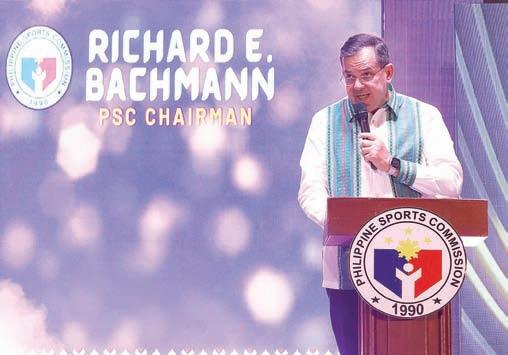
By Randy Caluag
THE Philippine Sports Commission (PSC), led by Chairman Richard Bachmann and Commissioners Olivia “Bong” Coo, Walter Torres, Edward Hayco, and Matthew “Fritz” Gaston, has demonstrated a strong commitment to Filipino athletes and sports development over the past year. Facing a demanding workload from the outset, the board quickly found its stride, collaborating with key stakeholders like the Philippine Olympic Committee and national sports associations to achieve remarkable results on the international stage.
A Historic Year for Philippine Sports
The year 2024 proved to be a banner year, highlighted by the Philippines’ best-ever performance at the Paris Olympics. The nation celebrated two gold medals (Men’s Artistic Gymnastics Floor Exercise and Men’s Vault) and two bronze medals (boxing), thanks to the exceptional talent of Carlos Yulo, Aira Villegas, and Nesthy Petecio. This historic haul placed the Philippines 37th overall, a testament to both the athletes’ dedication and the PSC’s support. While the Paralympics yielded no medals, the strong performances of the Filipino athletes, with four out of six reaching the finals, were inspiring. Supporting Athletes at All Levels
The PSC’s support extended beyond the Olympics and Paralympics. They played a crucial role in international competitions, including the BIMP-EAGA Friendship Games, and hosted several prestigious events, such as the Asian Cadet Junior & U21 Championship and the Southeast Asian Shooting Association Championships. They also supported Filipino athletes in various other international competitions, from the Winter Youth Olympics to the Asian Volleyball Confederation Challenge Cup.
At the grassroots level, the PSC’s flagship programs, Batang Pinoy and the Philippine National Games, engaged over 11,000 athletes. Other initiatives included the community-based Laro’t Saya sa Parke, the Indigenous Peoples Games, the Philippine National Para Games, and the Philippine
He also received a fully furnished threebedroom unit in McKinley Hill worth P32 million from Megaworld, a house and lot in Nasugbu, Batangas, worth P6 million from Century Properties, a Toyota Land Cruiser Prado worth P4.8 million from Toyota Motors Philippines and a two-story house on a 500-square meter lot in Tagaytay City from the Philippine Olympic Committee, to name a few. He also was offered a lifetime supply of various food products, from Pizza Hut to Mang Inasal, and Cabalen to Waffle Time and Buddy’s. Lovers in Paris
In 2020, Caloy and Chloe began a love story written across continents. During the pandemic, their connection deepened through countless video calls, heartfelt messages, and shared moments on social media. Their virtual world became a reality in 2022, when Chloe, all the way from Australia, surprised Caloy in Hanoi for the Southeast Asian Games. From that moment on, Chloe has been his constant supporter, a beacon of love at every major tournament.
King of the floor Bent on burying the heartbreak of his Tokyo Olympic campaign, Caloy put on a show for the ages in Paris with a performance that dazzled the entire arena and uplifted the spirits of his weary nation as he captured the gold medal in the men’s floor exercise.
The Filipino gymnast, who was eliminated from final contention in the Tokyo Olympics three years ago, where everyone expected him to win, delivered a flawless
ROTC Games. The PSC also championed Women in Sports with dedicated awards and recognition.
Investing in the Future
Recognizing the importance of infrastructure, the PSC is prioritizing the development and upgrading of sports facilities. Projects include the construction of a new athletes’ dormitory and a Multi-Sport Training Center, along with the renovation of the Rizal Memorial Baseball Stadium, the PSC Administration Building, the Philippine Sports Museum, and the Gymnastics Center. Looking Ahead to 2025 and Beyond
The PSC’s commitment continues in 2025, with a focus on supporting athletes in major international competitions, including the Southeast Asian Games, the ASEAN Para Games, the Asian Youth Games, the Asian Winter Games, and The World Games. The Philippines will also host several significant events, such as the FIVB Men’s Volleyball World Championships and the FIFA Women’s Futsal World Cup. Grassroots programs will continue to be a priority, nurturing the next generation of athletes.
A Foundation for Greatness
Chairman Bachmann acknowledged the challenges but emphasized the inspiration drawn from the athletes’ achievements.
With its focus on elite and grassroots development, combined with strategic infrastructure investments, the PSC is laying a solid foundation for continued success in Philippine sports for years to come.
routine this time, culminating in a perfectly executed three-and-a-half twist dismount that left no question as to who the true king of the floor was.
When Caloy’s score flashed at 15.000 as the finale’s third performer, Chloe let out a scream, as if to announce to the world – that’s my man. Caloy would set the pace from there, until the score of the final gymnast on the mat, Great Britain’s Luke Whitehouse flashed side by side with Caloy’s -- 15.000 to 14.466. Gold!
“This is overwhelming, I could hardly believe this has happened,” said Caloy. “I thank the Lord God for this. He has watched over me all these years, all throughout my career as a gymnast.”
Several feet away, Chloe, engulfed with emotion, was already shaking, tears rolling down her cheeks. Word spread fast that she was Caloy’s significant other, and so a small crowd of fans stood and clapped around her, further drowning her in tears.
“Hindi ko na po alam ang sasabihin ko, nanginginig pa din ako, thank you God and thank you po sa family ko na super supportive sa amin ni Caloy,” said Chloe. Love is a gold medal
As the Philippine national anthem was played at the Paris Olympics for the first time, Caloy stood at the center of the universe, his hand a steady presence on his chest. But his heart belonged to that particular woman in the crowd. In this moment of national pride, their spirits were one, a testament to the enduring power of their affection towards each other. With love, even superhumans are humans, after all.

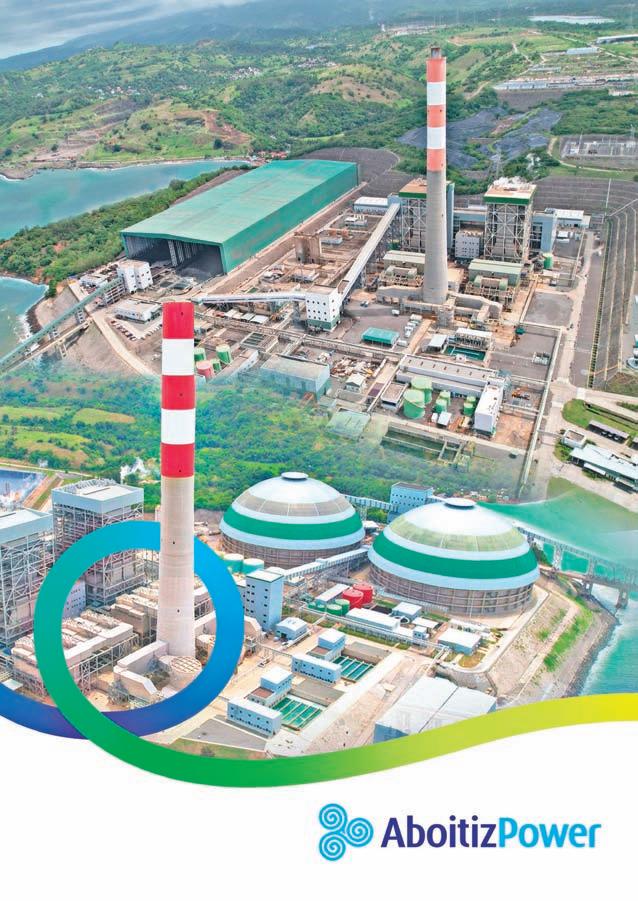




By Riera U. Mallari
THERE are only a few of them in the world, superhuman athletes, who push the boundaries of human potential, freaks of nature that are true marvels of physical prowess – Michael Jordan, Michael Phelps, Mike Tyson. In the Philippines, they come once in a generation – Manny Pacquiao, Paeng Nepomuceno.
Carlos “Caloy” Yulo.
Greatness came in a 4’11” bundle of power and precision as gymnast Caloy clinched two gold medals in the 2024 Paris Olympic Games in two consecutive, momentous days of August, a feat unheard of and seemed impossible in the past.

But there he was, performing superhuman routines that boggled the mind and left judges and spectators alike at the Bercy Arena in Paris with mouths agape.
A vault into history
After being crowned the previous day as floor exercise champion, the 24-year-old Caloy put the exclamation point to his intoxicating Paris campaign with yet another perfect routine, this time in the vault, to claim his second gold and put sports-loving Filipinos back home in a state of delirium.
Already a history maker as the Philippines’ first male Olympic champion a day before and a first in his sport, the gymnastics’ phenom capped off his extraordinary stint with yet another historic gold as he averaged a stellar 15.116 points to secure the top spot in the competition.
Caloy’s exceptional performance, highlighted by a 15.433-point score on his first vault, solidified his status as the Philippines’ newest sporting icon, joining the likes of the country’s first Olympic champion Hidilyn Diaz and eight-division world titlist Pacquiao in the pantheon of all-time greats.
“I was surprised myself, I just kind of did it,” said Caloy. “I went out there and just poured everything I got.” Artur Davtyan of Arme-
nia, the Tokyo 2020 silver medallist, remained the runner-up with his 14.966, while Great Britain’s Harry Hepworth, just 20 years old in his first Olympiad, bagged the bronze on 14.949.
The win marked a remarkable redemption story for Caloy, who finished fourth in the same event at the Tokyo games.
Man on a mission
Caloy’s first gold in the Olympics was even more impressive. And emotional.
In a breathtaking display of athleticism and grace, Caloy capped his faultless show in the floor exercise by charging toward the center of the mat, launching himself skyward, his body twisting and turning.
A controlled descent followed, as he landed with impeccable precision, his form as perfect as the execution.
After his flawless display that got


him a 6.600 from difficulty and 8.400 from execution for a stunning 15.000 score, Caloy pumped both his fists, saluted the fans and touched his heart as a gesture of thanks to an adoring crowd that included his girlfriend Chloe Anjeleigh San Jose.
Caloy knew in his heart he did something magical. For himself, for his country and for the love of his life. “Mahaaaaaal!” screamed the pretty lady clad in elegant black several feet away from the center mat, the lights bouncing off her silky, porcelain skin and blonde hair, her cheers drowned by the chorus of applause and salutations from all over the arena.
Caloy may have never heard her cheers, but he knew she was there in the stands, proud of his achievement as the Philippines’ first ever gymnastics’ gold medalist in the Olympic Games, where the country has never won in 97 years, until weightlifter Diaz delivered one in the pandemic-hit Tokyo games in 2021. Windfall of incentives As a double-gold medalist in the Olympics, Caloy’s windfall of bonuses has breached a staggering P100 million as more incentives, gifts, and perks poured his way, the biggest of which were his P20 million for his two gold medals under Republic Act 10699, P20 million from the Office of the President, P14 million from the House of Representatives, P10 million from business magnate Manny V. Pangilinan and P10 million from the International Container Terminal Services Inc. Turn to L3





By Angelica Villanueva
MORE people are looking for ways to shop sustainably, whether it’s for clothes, food, or everyday items. But what does that really mean? Simply put, sustainable shopping is about making choices that are better for the planet and the people who make the products we buy. The good news is that small changes in how we shop can make a big difference.
Sustainable shopping means buying things that are made responsibly using materials and processes that don’t harm the environment. It also includes supporting brands that treat their workers fairly and choosing
products that last longer, reducing waste.
An increasing number of businesses are now providing sustainable options. In the fashion industry, for instance, brands are utilizing organic fabrics, recycled materials, and ethical
labor practices. Grocery stores are broadening their selections to include locally grown and plasticfree products. Moreover, some companies are designing products that can be reused or recycled rather than disposed of. Turn


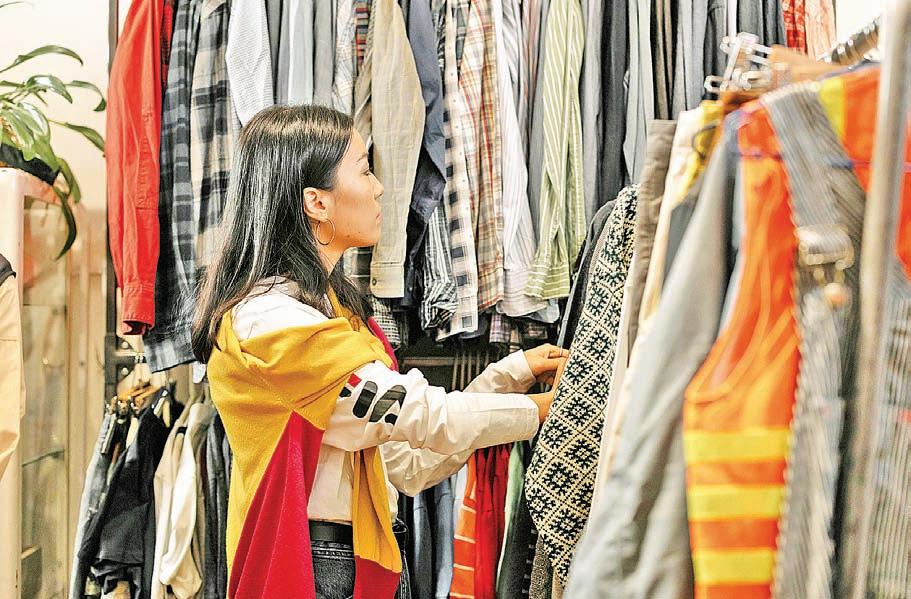
Simple ways to shop sustainably
Making eco-friendly choices doesn’t have to be complicated. Always remember: a little goes a long way. Here are some straightforward ways to get started:
To make eco-friendly shopping choices, start by buying secondhand. Explore thrift stores, vintage shops, and resale platforms to give items a second life.
Opt for quality over quantity by investing in durable products that will last longer instead of purchasing inexpensive items that deteriorate quickly. Support local and ethical brands that champion fair trade and embrace sustainable production practices—your support can have a meaningful impact.
Reduce your use of single-use plastics by bringing your own reusable bags, bottles, and containers when shopping to minimize waste.
Finally, do your research before making a purchase, ensuring that the brand is committed to sustainable practices and holds valid environmental certifications. Your thoughtful decisions can lead to significant change and help create a more sustainable future.
As we face pressing environmental challenges, taking immediate action is essential. Companies and government entities need to make sustainability a top priority, but consumers are vital in this effort as well. The decisions we make can significantly influence positive changes in the marketplace.
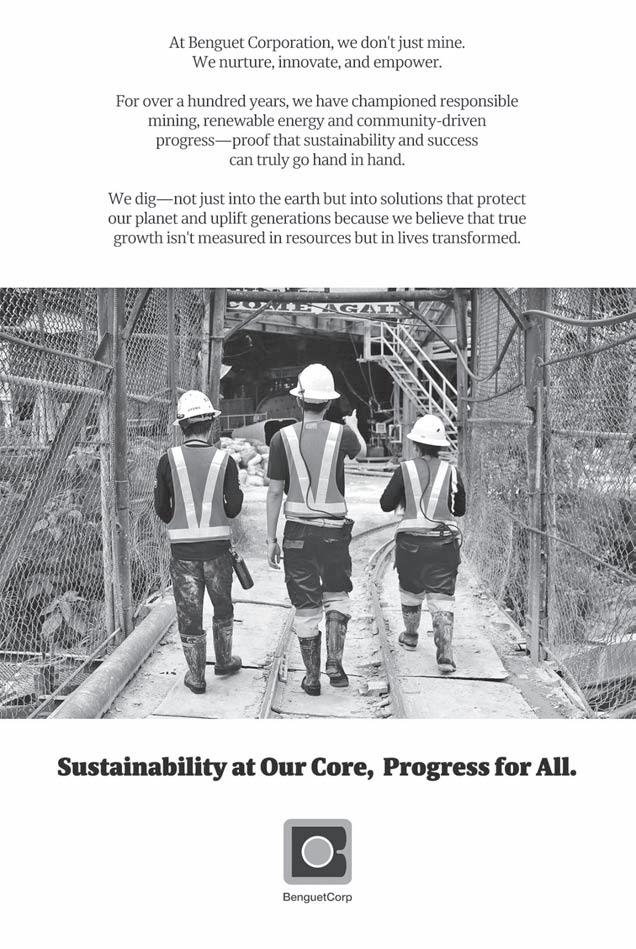
Sustainable shopping isn’t just a passing trend—it’s a shared responsibility. Every transaction we make represents the future we aim to create. By choosing ecoconscious products, we encourage companies to adopt sustainable methods and protect our Earth. Minor adjustments in our purchasing behaviors can lead to substantial effects. A change is still a change. Every deliberate choice brings us closer to a future where sustainability becomes the standard, not the exception. The influence lies with us—let’s wield it wisely to create a more sustainable future for all.

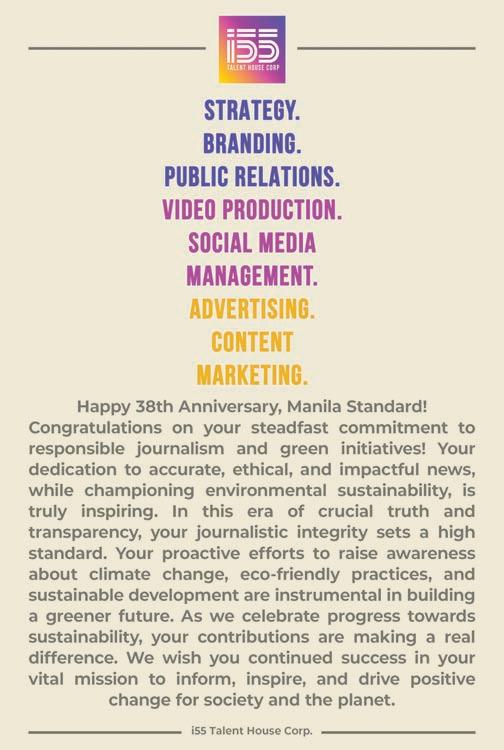




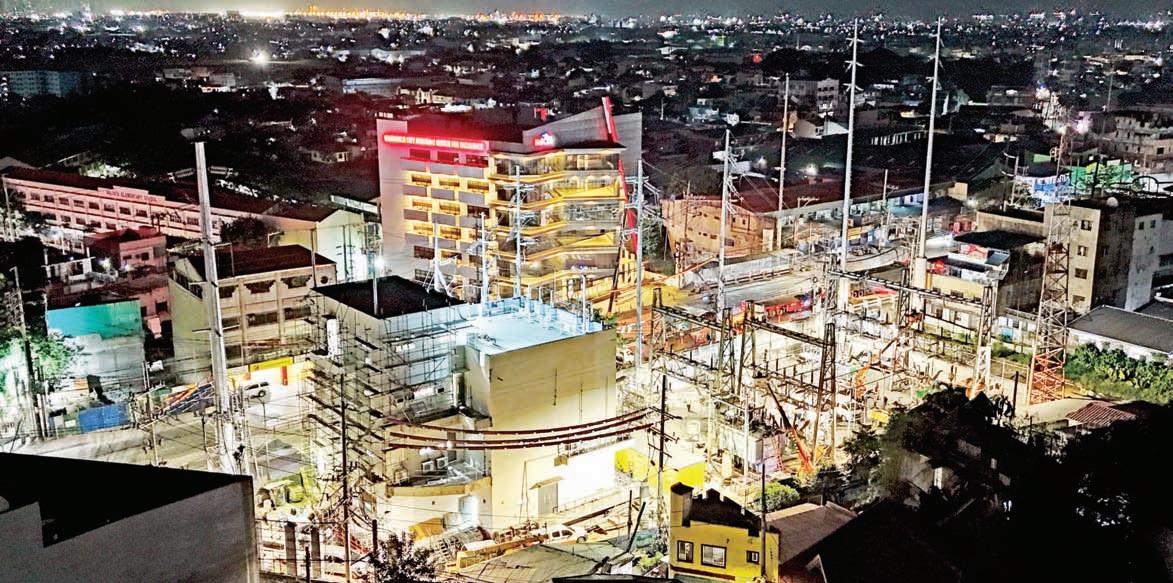
THE Manila Electric Company (Meralco) stands at the forefront of transformative change, driven by bold ideas, strategic foresight, and an unwavering commitment to provide 24/7 power to its over eight million customers. Innovation is evident in Meralco’s initiatives such as smart grid technologies, digital customer platforms, and renewable energy ventures that are vital in improving the delivery of electricity to consumers and ensuring the people have secure, reliable, sustainable, and affordable power supply in the long term. Its efforts consistently yield results. In fact, the distribution utility achieved alltime best reliability performances, enhancing the customer experience in terms of fewer and shorter power interruptions and more consistent electricity service.
Meralco’s total System Average Interruption Frequency Index (SAIFI) or the average number of interruptions that a customer experienced in a year has been steadily going down. At 1.041 times by the end of 2024, this was even lower than 1.194 times in 2023. Similarly, its total System Average Interruption Duration Index (SAIDI) or the average duration of interruptions that a customer experienced in a year improved to 108.213 minutes from 123.708 minutes.
“This is truly a testament of Meralco’s service excellence,” Meralco Executive Vice President and Chief Operating Officer Ronnie L. Aperocho said. Beyond its pursuit to ensure safe, stable, and dependable service that directly affect convenience, cost, and peace of mind of its customers, it also endeavors to keep up with the evolving requirements of its growing number of customers.
In October last year, Meralco crossed the eight-millionth customer mark—a testament to its extensive reach and growing customer base as well as the crucial role it plays in enabling economic growth. This milestone underscores the company’s operational resilience as it adapts to evolving energy demands and consumption patterns. With the continuous growth of its customer base, Aperocho said the company recognizes the need to accelerate Meralco’s grid modernization efforts and enhance operational efficiency by leveraging advanced metering infrastructure (AMI), paving the way for a stronger, more resilient, and smarter network. Through its AMI program, Meralco has been integrating smart metering technologies into its distribution network since 2013 to improve operational efficiency, enhance grid reliability and resiliency, as well as empower its customers. To further optimize network operations, the power distributor launched Powertech Innovation and eXperience Lab (PIXL) in May 2023. PIXL is a digital

reality (VR) and augmented reality (AR) for training and education, supports efforts toward a smart grid by enabling simulations of critical incident resolutions and remote assessments.
To meet the ever-changing and growing power needs of consumers and support the country’s clean energy transition, Meralco has embedded in its strategy a twin commitment to source a portion of its supply requirements from renewable energy and develop a generation portfolio through its subsidiary, Meralco PowerGen Corporation (MGEN).
Last year, MGEN broke ground for its cornerstone renewable energy development, the MTerra Solar Project. Touted as the world’s largest integrated solar and battery storage facility, the MTerra Solar Project will consist of 3,500 megawatts peak (MWp) photovoltaic (PV) capacity, complemented by a 4,500 megawatt-hours (MWhr) Battery Energy Storage System (BESS) capacity.
“As the construction begins, we will be needing plenty of resources and the skills to energize the first phase of the MTerra Solar project by 2026,” Aperocho said. These accomplishments are not just corporate successes—they represent the tangible benefits that Meralco customers experience every day, from reliable power to meaningful community engagement. Moving forward, the focus will be on scaling innovative initiatives, driving operational excellence, and fostering a collaborative environment where bold ideas can thrive.
At the heart of Meralco’s vision lies a culture of innovation—a mindset that challenges conventions, embraces creativity, and seeks to create sustainable value for stakeholders.
Advocating for creativity and digital transformation even beyond the organization, Meralco brought together employees, partners and students in celebrating Innovation Month in November last year.
The Innovation Month program was powered by the support of leading technology partners, including Huawei, Cloudera x Novare, Tata Consultancy Services, PPI, MSPI, Itron, and One Commerce, Abbe x Dell, Fibercom, Trends, UAS x Cisco, Fortinet, Palo Alto, Checkpoint, Vintecom, Geoplan and Fujitsu.
The two-week long celebration served not only as a platform for celebrating technological advancements but also as a rallying call for Meralco employees, partners, and stakeholders to embrace innovation as a core driver of progress.
The Innovation Month program featured tech exhibits and pocket sessions featuring innovative solutions and ideas.
It also presented Innovation Awards 2024, where groundbreaking achievements at Meralco were recognized across categories, including Community of Practice (COP) Members Introduction, Innovative, Digital, Original, Leading-edge (IDOL) Awards, Environment, Safety, and Health (ESH) Innovation, Customer eXperience Innovation Summit (CXIS), and Meralcostar.
The ESH Innovation showcased groundbreaking initiatives aimed at enhancing
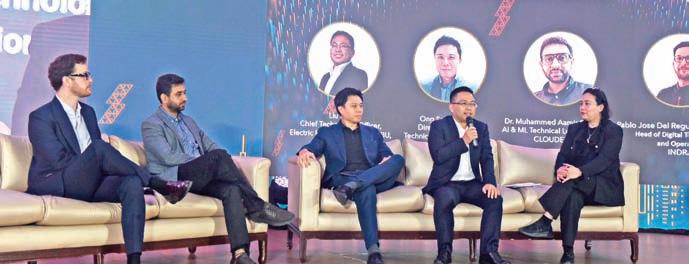

sustainability, ensuring workplace safety, and promoting the well-being of employees and communities.
The CXIS also presented innovative projects while promoting sustainable solutions to improve process efficiency, enhance customer journeys and boost customer experience using the different touchpoints.
Meanwhile, Meralcostar celebrated grassroots innovations that showcase passion, resilience, excellence, and discipline amid an evolving energy landscape.
Shaping New Ideas from Young Minds
One of the highlights of the Innovation Awards was the IDOL series, which brought together diverse talents for the IDOL Hackathon and IDOL Excellence Awards.
The IDOL Awards celebrated Meralco employees who are expanding their digital skills and expertise to drive innovation across the enterprise, highlighting the company’s commitment to cultivating digital fluency and problem-solving capabilities throughout the organization.
Meanwhile, Meralco Power Academy’s
IDOL Hackathon gathered 15 teams of talented students for an intense 24-hour challenge of rapid, collaborative engineering to develop functional software. With the theme, “Beyond the Grid: Shaping the Future of Electric Utility with Next-Gen Solutions,” the IDOL Hackathon highlighted innovation in action.
KuryentEEE, composed of four Electrical and Electronics Engineering students from the University of the Philippines –Diliman, emerged as the winner for their project “$BOLTZ(BLTZ) – Decentralized Net Metering and Tracking System on Arbitrum Blockchain,” which aims to encourage the adoption of renewable energy technologies and promote energy conservation by providing financial incentives that are transparent, secure, and efficient.
Energy No Gap, a three-man team of BS Data Science students from Mapua University, bagged the second place for their project “SmartGrid,” a visionary solution designed to outsmart outages and empower the future of energy.
Landing in third place is Homefie, a group of students from the National University–Manila, for their project “Grid Guard,” a solution designed to scale efficiency, simplify workflows, and empower success. Digital Transformation to Drive Sustainability and Innovation
Another significant undertaking during Meralco’s Innovation Month was Tech Talk, where discussions centered on emerging technologies that boost customer experience and satisfaction. With the theme “WATTS NEXT: Powering Digital Resilience Through Intercon-
nected and Intelligent Grid,” Tech Talk 2024 which—featured three technology experts—underline the critical role of integrating advanced technology and data-driven strategies to meet global sustainability goals and build future-ready systems.
Aperocho said the Tech Talk celebrated ideas that are “not only transforming the way we work but are also setting the stage for the next chapter of Meralco’s digital transformation journey.”
“These ideas will drive us to solve real challenges, enhance customer experiences, and push the boundaries of what we thought possible,” he said.
Lifei Liu, Huawei’s Chief Technology Officer and Regional Director for Electric Power Digitalization Business Unit in Europe and Middle East, in his talk “Technologies Empowering the Future-Oriented Smart Grid”, discussed how digital platforms and ecosystems empower smart grids to address energy transition challenges and achieve carbon neutrality.
“Beyond the Grid - Advancing Sustainability with Smart Streetlights” of Itron Director and Head of Technical Sales Asia Pacific Ong Seng Chuan highlighted the role of Internet of Things (IoT)-enabled smart lighting networks in reducing energy consumption and promoting sustainable practices in communities.
Muhammed Aamir Saleen, Cloudera’s Artificial Intelligence (AI) and Machine Learning (ML) Technical Lead for Asia Pacific, brought his insights how to “Trust your data, Trust your AI.” He emphasized the importance of trustworthy data and AI in building robust platforms that support innovation and adapt to future needs.
Moderated by Meralco Vice President and Chief Information Security Officer Marilene P. Tayag, Tech Talk also featured an interactive panel discussion with the speakers, which delved into how technological innovations are redefining industries and transforming everyday life. As Meralco prepares for the next chapter, the company remains committed to its mission of delivering safe, reliable, sustainable, and innovative energy solutions. From large-scale renewable energy projects to enhancing customer experiences through technology, every initiative reflects Meralco’s dedication to building a better future.
“We must continue to embrace the culture and mindset of continuous improvement and collaboration, not only to stay ahead of the curve but also to lead the way in our industry,” Aperocho said. With passion, collaboration, and a shared vision, Meralco is not just keeping the lights on—it is illuminating the path toward a sustainable and innovative future for the country.




By Angelica Villanueva

IN RECENT years, businesses worldwide have embraced sustainability through environmental, social, and governance (ESG) practices. Brands are adopting eco-friendly methods to address environmental issues while promoting economic and social growth for a sustainable future.
In the Philippines, more local lifestyle brands are leading the charge, offering ecofriendly products that encourage green living. These companies are not only meeting the demand for sustainable alternatives but also shaping how we live, consume, and interact with the environment. From fashion to home goods, they prove that sustainability enhances both the planet and everyday life.
Rags2Riches (R2R): Sustainable fashion with purpose
For 16 years, the brand has empowered Filipino artisans by repurposing discarded fabric into handwoven bags, clothing, and accessories. This sustainable fashion brand reduces textile waste and provides livelihoods for communities in need, proving that fashion can be both stylish and eco-friendly.
Randolf Clothing: Playful, upcycled fashion
For over a decade, Randolf Clothing has been at the forefront of sustainable fashion, crafting quirky, pop-culture-inspired pieces from recycled fabric scraps. By minimizing waste and reimagining excess materials, the brand proves that fashion can be both fun and responsible.
Muni Muni: Slow fashion with a story Muni Muni’s collections celebrate heritage and sustainability, using small-batch, handmade techniques passed down through generations. Their tie-dye pieces, each uniquely crafted, highlight the beauty of slow fashion—one that values artisanship over mass production.
Eco-conscious home and lifestyle Green living extends beyond fashion, and Filipino brands are redefining sustainability in everyday essentials.
Damgo Studio: Bags with a circular story
Damgo Studio reimagines fashion through circular design, transforming discarded materials into stylish, functional bags. Their Sumilon Toe Bag, handwoven by artisans in Cebu, gives new life to upcycled fabrics, proving that sustainability and style can go hand in hand.
EcoNest: Packaging for a plastic-free future
EcoNest is tackling plastic pollution headon with biodegradable packaging made from plant-based materials like cassava and sugarcane. Their eco-friendly bags and containers offer a guilt-free alternative to single-use plastics, helping businesses and consumers reduce their environmental footprint.
Bambuhay: Sustainable bamboo for a better world
Founded in 2018, Bambuhay is harnessing the power of bamboo to combat climate change, pollution, and deforestation. From reusable bamboo straws to ecofriendly toothbrushes, the brand promotes a circular economy while providing sustainable livelihood opportunities for local communities.
Why supporting local sustainable brands matters
Every purchase from these Filipino brands is a step toward a more sustainable future. By choosing ethically made products, consumers are not just supporting local businesses— they’re investing in a lifestyle that values environmental responsibility and cultural heritage.







By Nickie Wang
As the newest academic member of EVAP, Benilde will collaborate on curriculum development, research projects, competitions, and industry exposure programs related to EV technology.
Faculty members and students will take part in various initiatives, including hosting events and participating in contests focused on sustainable mobility.
EVAP will provide support through curricular consultations, resource sharing, and thesis development to align academic programs with industry needs. The organization will also offer expert guidance on national EV policies, industry standards, and regulations.
The partnership was formalized through a memorandum of agreement signed by EVAP president Edmund Araga, chairman Rommel Juan Benilde vice chancellor for academics Angelo Marco Lacson, and School



HE Electric Vehicle Association of the Philippines (EVAP) has partnered with De La Salle-College of Saint Benilde (DLS-CSB) to promote sustainable transportation and advance electric vehicle (EV) technology in the country.
of Environment and Design (SED)
Dean Ar. Harvey Vasquez
Faculty member

Patrick Sunico facilitated the collaboration, while Industrial Design Program chairperson

A
Romeo Catap Jr. oversaw the signing.
Student representatives Roland Reynoso and Jared Sanchez also attended the event.
As part of the partnership, Benilde participated in the 12th Philippine Electric Vehicle Summit, the country’s largest annual EV conference and exhibition.
Industrial Design students, mentored by Sunico and professors Manuel Dacanay Jr. and Christian Pagulayan, competed in the E-Tricycle

Design Contest against other EVAPaffiliated schools. Paolo Aquino, Joey Manalansan, and Aurma Matriano secured the top prize, while Manuel Babasa, Juliana Jaurigue, and Adriel Ramos placed third.
Several raffle prizes, including two e-scooters, were awarded during the event.





The

By Nickie Wang
PLASTIC pollution has been one of the biggest environmental challenges of the past few decades, and with its growing impact, the push for sustainable alternatives has never been more urgent
The Philippines, one of the countries most affected by plastic waste, is taking its first steps toward a more sustainable future with the launch of the Philippine Reuse Consortium (PRC). This new initiative, introduced in celebration of International Zero Waste Month, is part of a larger regional movement aiming to shift toward a reuse economy.
The PRC, the Philippine chapter of the Asia Reuse Consortium, is bringing together civil society organizations, government agencies, and businesses in a shared mission to
eliminate single-use plastics (SUPs) and promote community-driven reuse solutions. With a focus on innovation and sustainability, the Consortium is working to develop systems that will not only reduce plastic waste but also create a more circular, eco-friendly economy.
One of the most exciting aspects of the PRC’s launch was the spotlight it placed on local initiatives that are already driving the change toward a reuse culture. From zero-waste sarisari stores (neighborhood convenience stores) and carinderias (local eateries)
to dedicated reuse-and-refill stores like Back-to-Basics and Sabon Express, small businesses in the Philippines are at
the forefront of the movement. These models show that reuse is not just possible but effective, and they offer valuable insights into how systems can be scaled to address plastic pollution in the country.
“These initiatives are examples of how local businesses can drive a sociocultural shift toward reuse,” said Rap Villavicencio, deputy director for programs at the Mother Earth Foundation. “However, achieving widespread systemic change requires strong support from enabling policies and the involvement of various sectors.”
As part of its efforts, the PRC unveiled a five-year roadmap to prioritize reuse in the country. The roadmap outlines 10 key action points, including lobbying for progressive laws, expanding reuse models, and empowering stakeholders through training and education. It also emphasizes the importance of ensuring that waste workers, often at the heart of the waste management system, are included in the transition to a reuse economy.
For Faye Ferrer, a network organizer with Break Free From Plastic, the

potential for reuse to address both plastic pollution and climate change is immense. “Reuse practices are alive and thriving in our communities,” Ferrer said. “With the right policies, investments, and corporate accountability, we can shift away from single-use plastics and create a circular economy that benefits everyone.”
While the PRC’s roadmap provides a clear vision for the future, it’s the small, everyday actions that will drive this change. Simple swaps, like using reusable containers at carinderias or adopting refillable options in sari-sari stores, can have a profound impact on reducing plastic waste. Local businesses and communities are already leading the way, and with the right support, the reuse revolution can expand across the nation.
As the country rallies around the PRC’s mission, there’s hope for a future where plastic waste is significantly reduced and sustainability becomes a part of daily life for Filipinos. This is not just about reducing pollution— it’s about creating a culture of responsibility, collaboration, and innovation that will help preserve the environment for future generations.
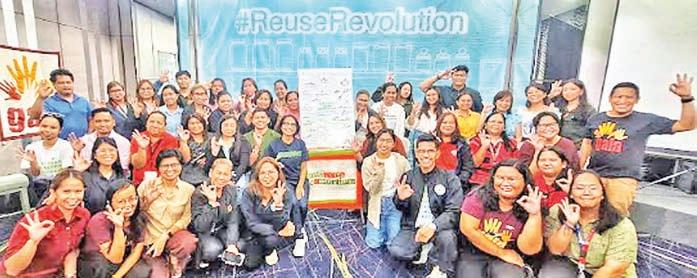


If you’re passionate about protecting underwater life, visiting marine sanctuaries and wildlife rehabilitation centers not only offers unforgettable experiences but also helps fund crucial conservation work.
6. Travel light, travel tight
Packing light isn’t just convenient; it’s an easy way to cut down on waste. The less you bring, the less you throw away. When getting around, opt for public transport like jeepneys or electric vehicles. This helps in reducing carbon emissions and, at the same time, gives you a more authentic

glimpse into local life.
7. Small wins count, too Zero-waste travel isn’t about perfection; it’s about making better choices, one step at a time. After all, every small effort adds up to a bigger impact. By packing smart, avoiding plastics, choosing sustainable stays, and supporting ethical businesses, you’re not just exploring the Philippines responsibly— you’re helping preserve its beauty for generations to come.
Remember, every small change matters. The more travelers choose sustainability, the bigger the ripple effect.


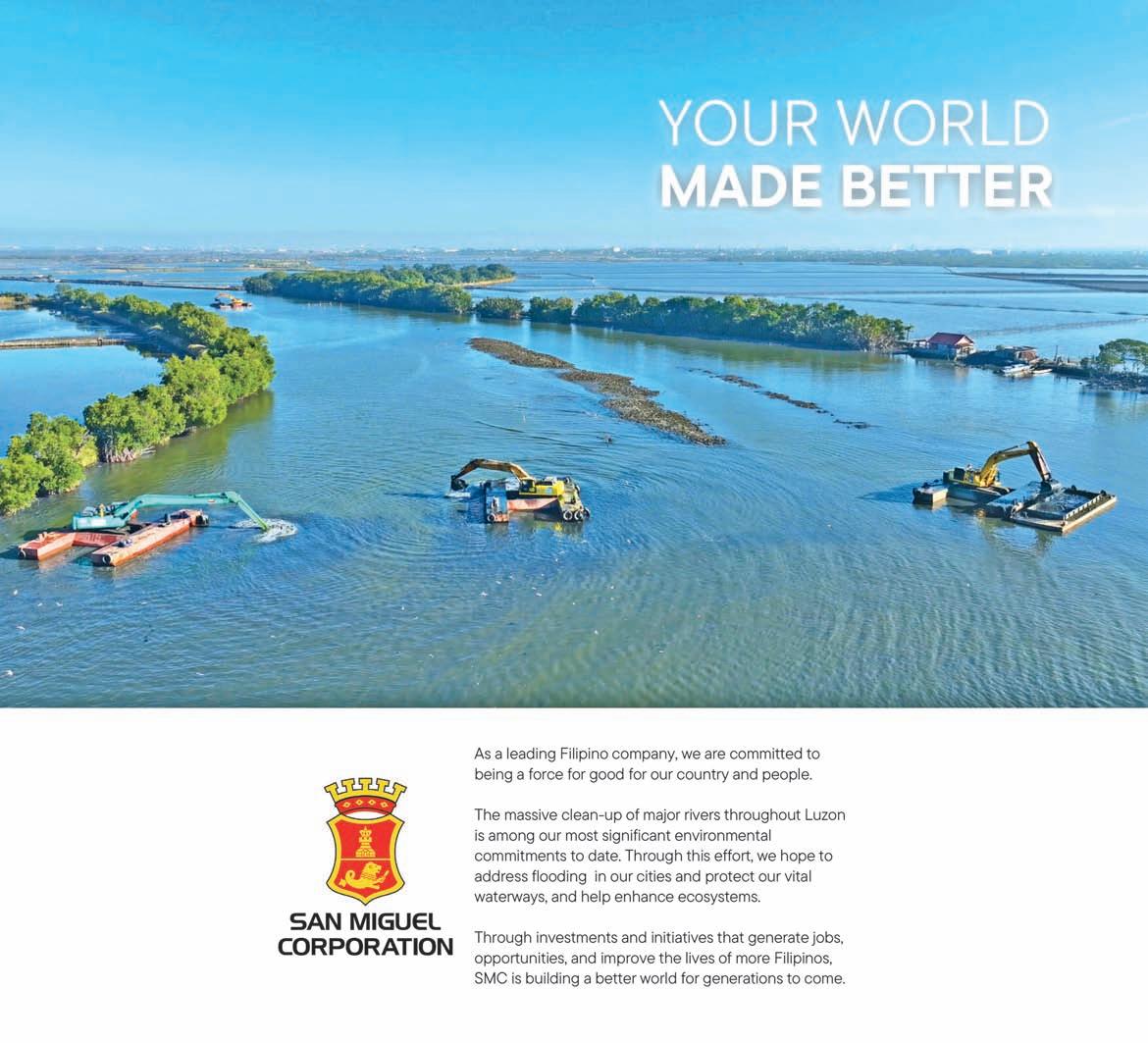
By Jasper Valdez
IMAGINE this: You finally make it to that world-famous white sand beach you’ve been dreaming of—crystal-clear waters, soft, powdery sand—only to find plastic bottles and snack wrappers ruining the view.
Instead of paradise, you’re met with a mess. Sadly, this is becoming more common in some of the Philippines’ most beautiful spots. Tourism brings in jobs and boosts the economy, but it also leaves behind a trail of waste that harms marine life and fragile ecosystems. The good news? We can still turn things around. The way we travel matters, and small choices can make a big difference. Here are a few ways you can explore responsibly and leave nothing but your footprints behind.



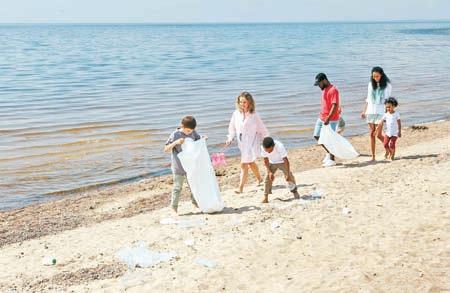
1. Rely on reusables
The easiest way to cut down on waste starts before you even leave home— by packing reusable essentials. A little preparation goes a long way in reducing your environmental footprint while traveling.


First up, a durable, reusable water bottle should be at the top of your list. Not only will it keep you hydrated, but many tourist spots now have refill stations, helping you avoid single-use plastics.
For food lovers, bamboo or metal cutlery is a great alternative to plastic, especially when sampling local delicacies and street food. Pair it with a cloth tote bag for shopping, which you can use again and again. Your toiletries can be eco-friendly too. Shampoo bars and refillable toiletry bottles save space, reduce plastic waste, and keep your travel kit lightweight.
unpackaged ingredients are the norm. Not only is this more sustainable, but it also means enjoying food at its freshest.
When dining out, order only what you can finish to avoid food waste.
livelihood.
An extra tip? Bring your own toiletries and towels to skip singleuse hotel freebies and cut down on unnecessary waste.




And if you can’t start the day without coffee, a reusable cup is a must-have to cut down on disposable cups and lids.
2. Eat smart and waste less Food is a big part of any trip, but enjoying it shouldn’t come at the cost of unnecessary waste.
One simple way to reduce your impact is by supporting farm-to-table restaurants and local markets, where fresh,
It’s also smart to bring a reusable container so you can save leftovers for later.
For snacks on the go, swap plasticwrapped options for fresh fruit or local delicacies wrapped in banana leaves. It’s a more eco-friendly choice and a tastier way to experience authentic flavors.
3. Stay in sustainable accommodations Where you stay can make a huge difference in reducing your environmental footprint. Across the Philippines, eco-resorts and green hotels are leading the way with solar-powered rooms, plasticfree amenities, and water-efficient systems.
If you prefer a deeper cultural experience, community-based homestays let you connect with locals while directly supporting their
4. Spend your money where it counts Every peso you spend has the power to promote sustainability, so support brands that create upcycled souvenirs and dine at zero-waste cafés.
Booking eco-friendly tours like kayaking instead of motorized boat rides will also help lessen pollution, specifically in the air.
The more we choose responsible businesses, the more the tourism industry shifts toward sustainability.
5. Give back while you travel Looking to make a positive impact? Join beach cleanups—many local communities organize them as part of ecotourism efforts. Some lodges even offer tree planting activities, letting you leave a lasting mark on the environment.
